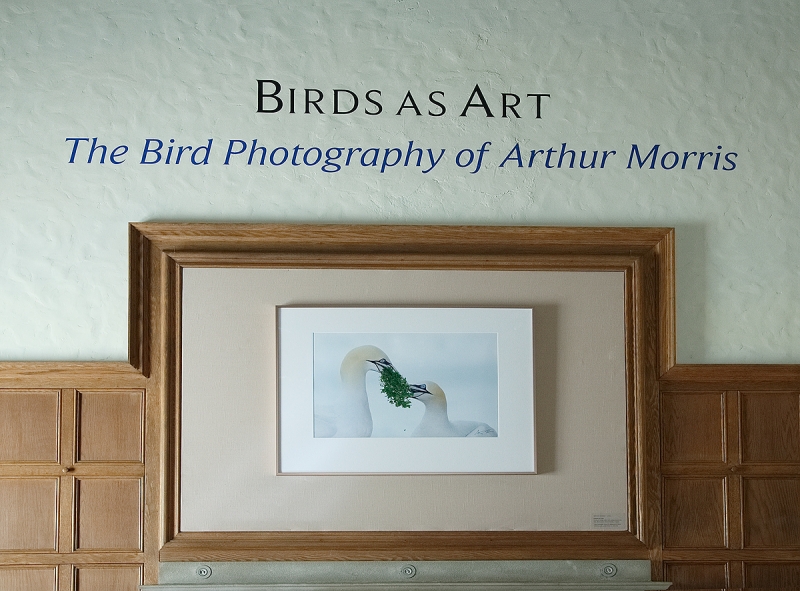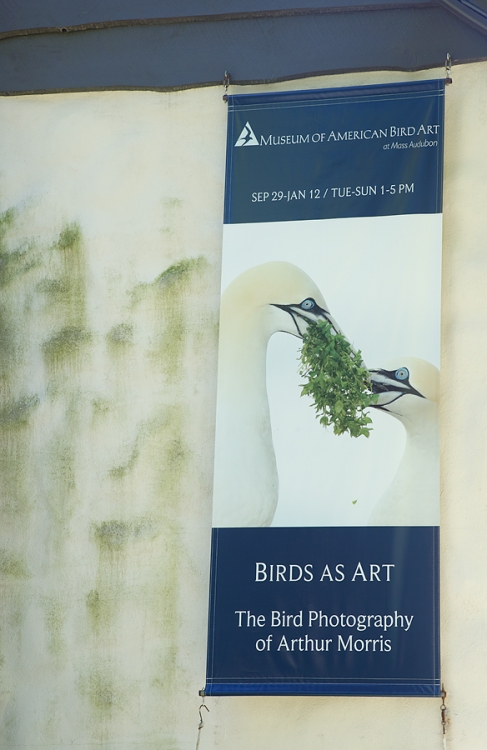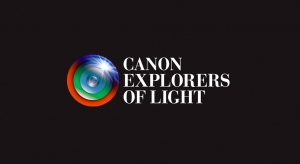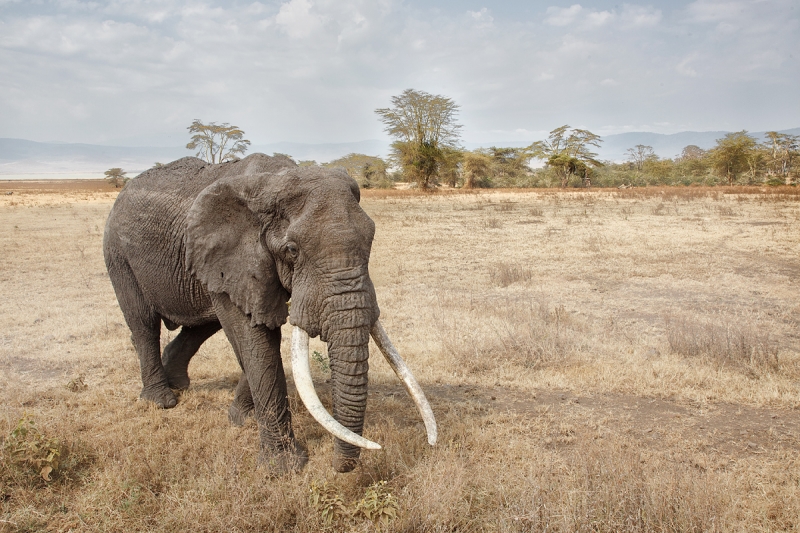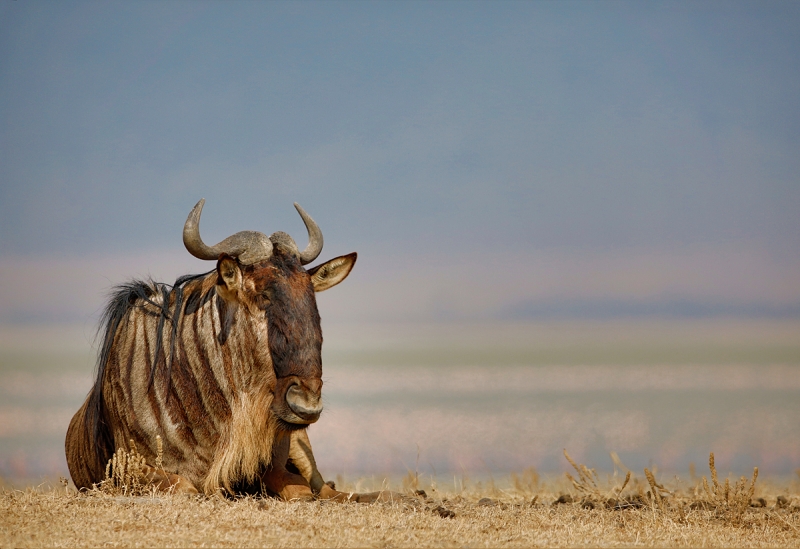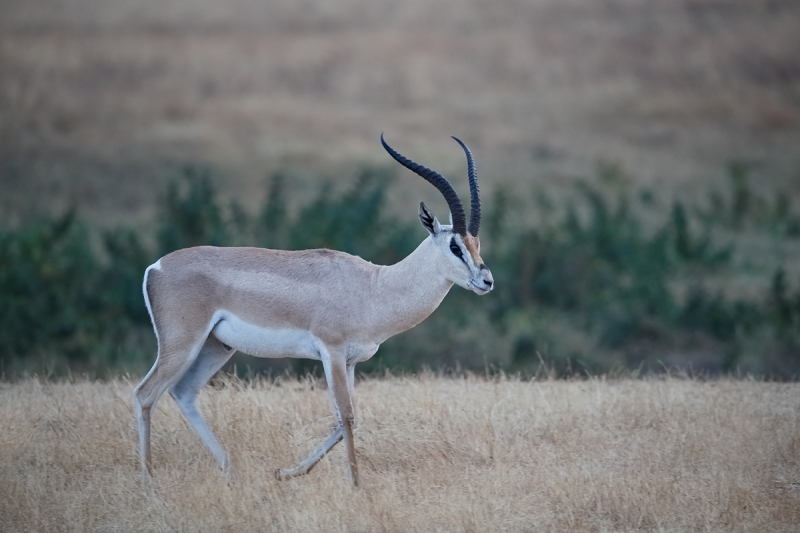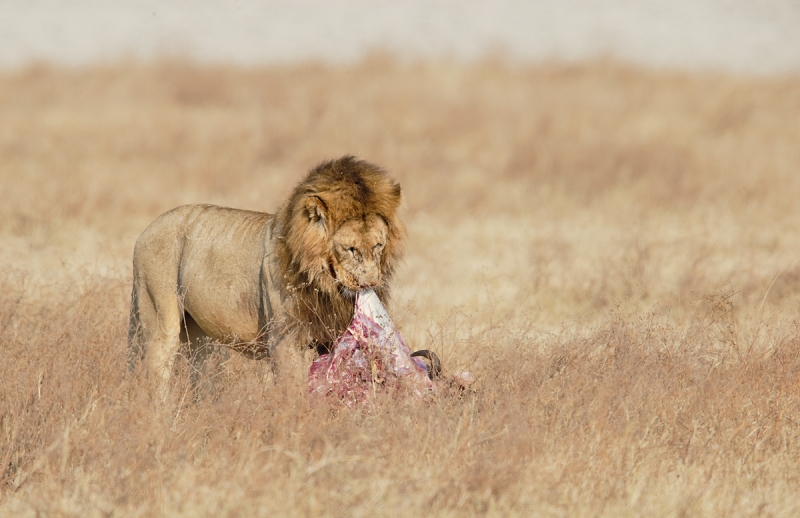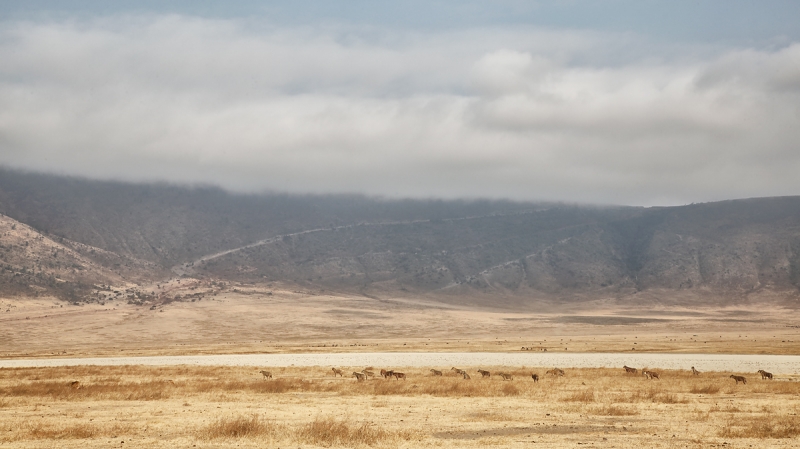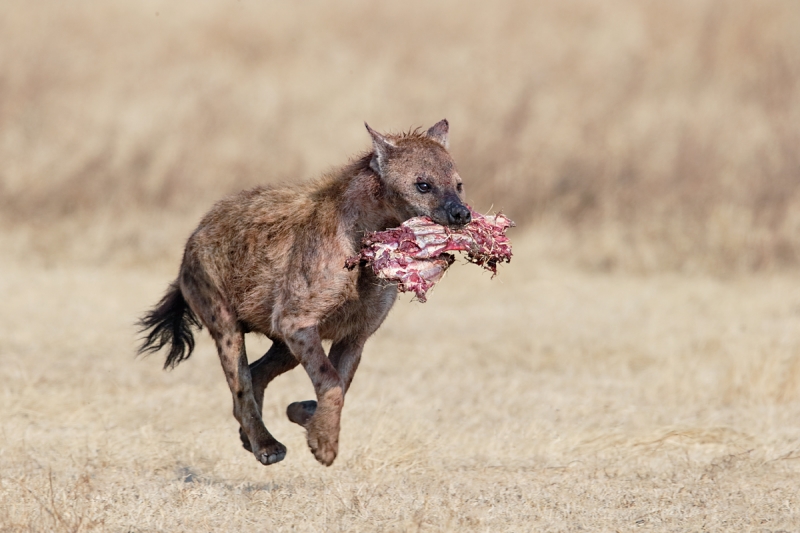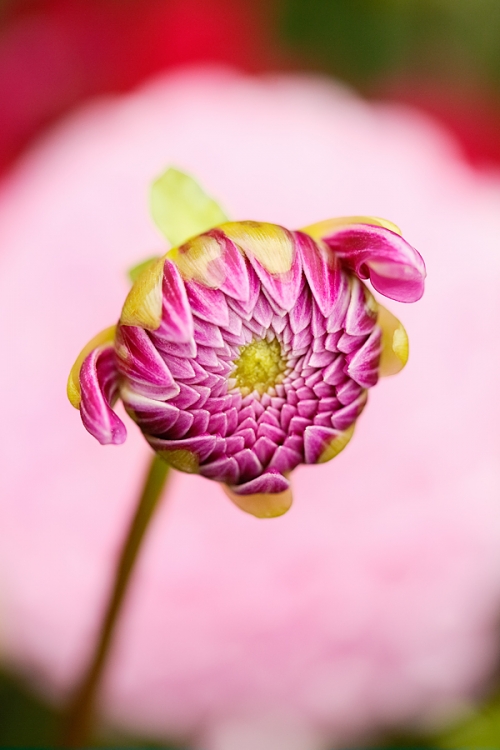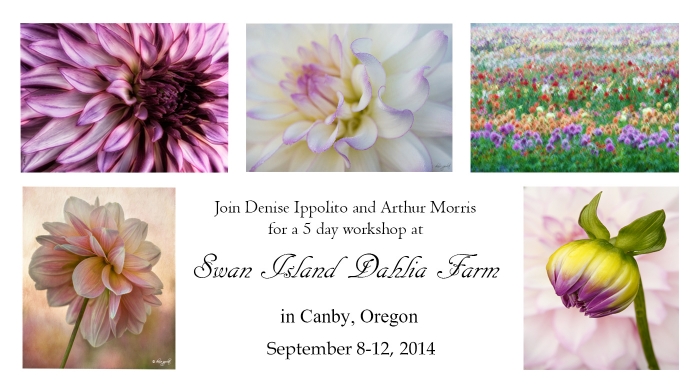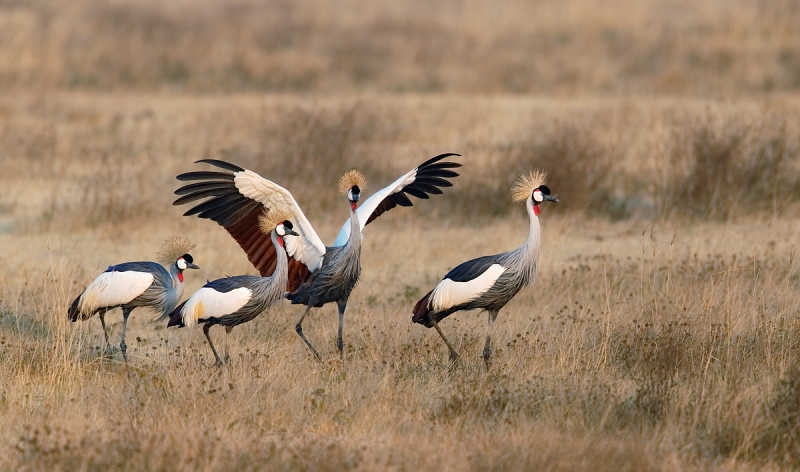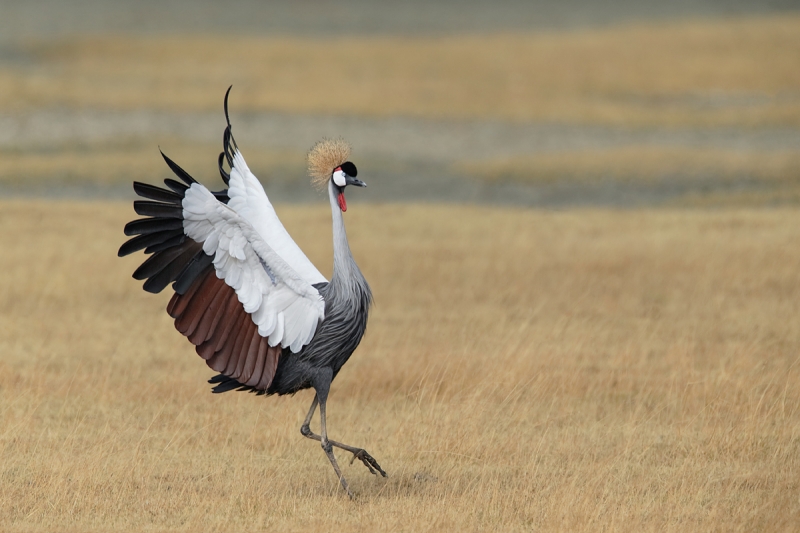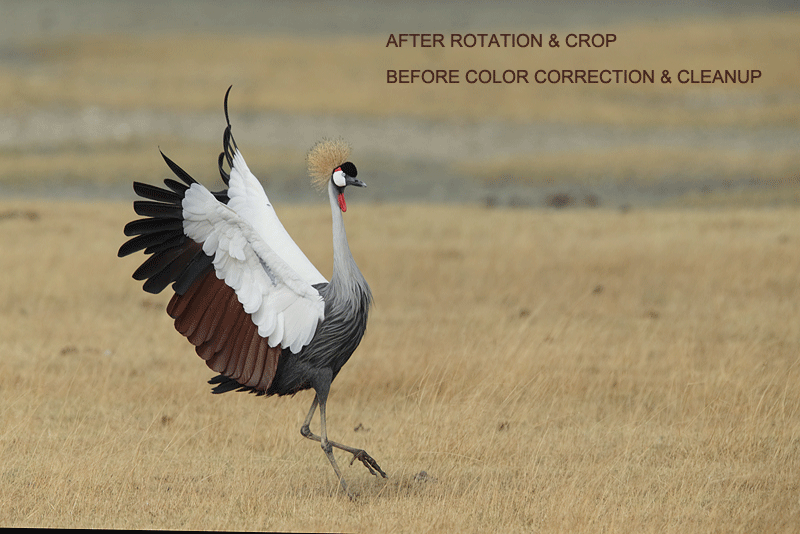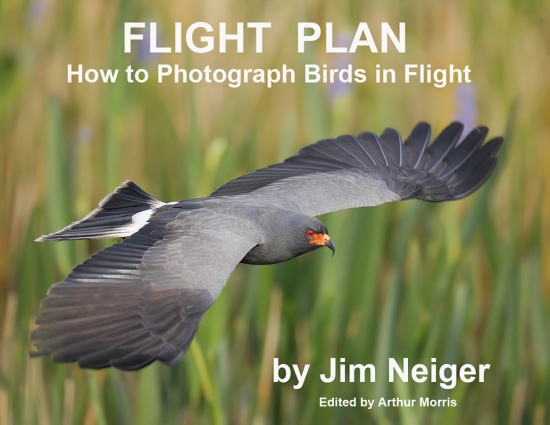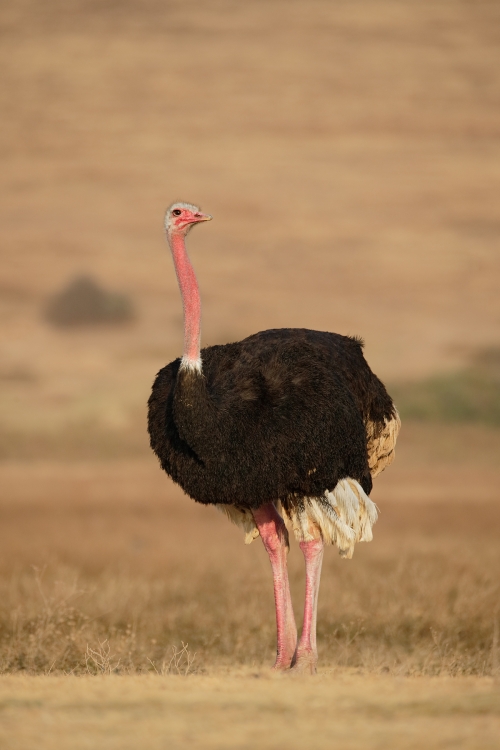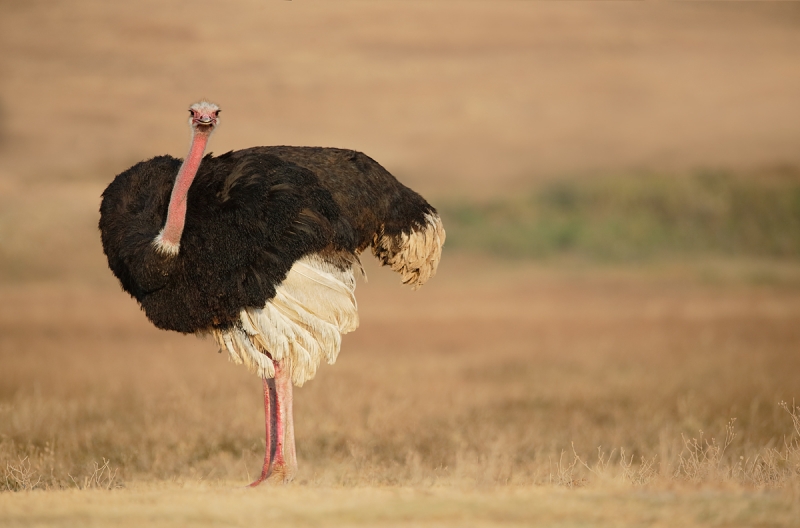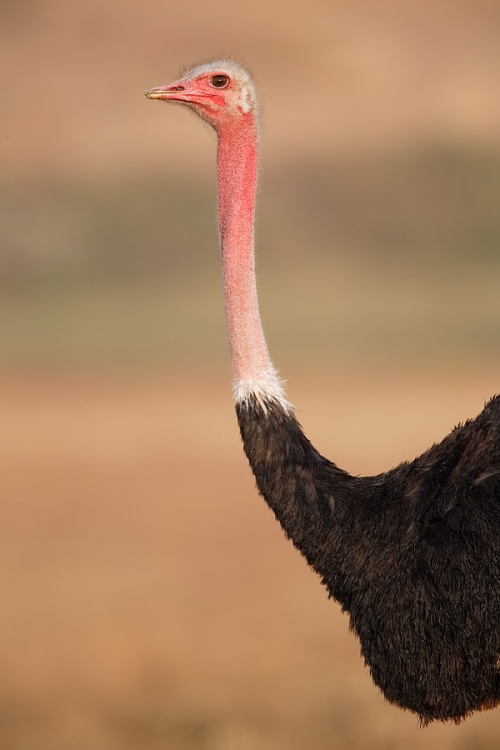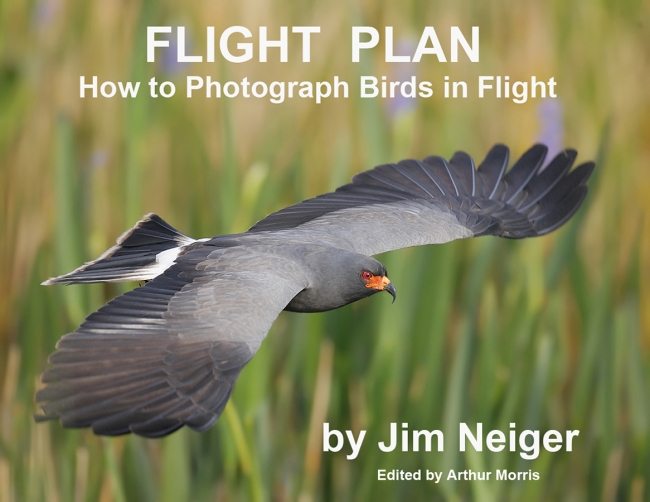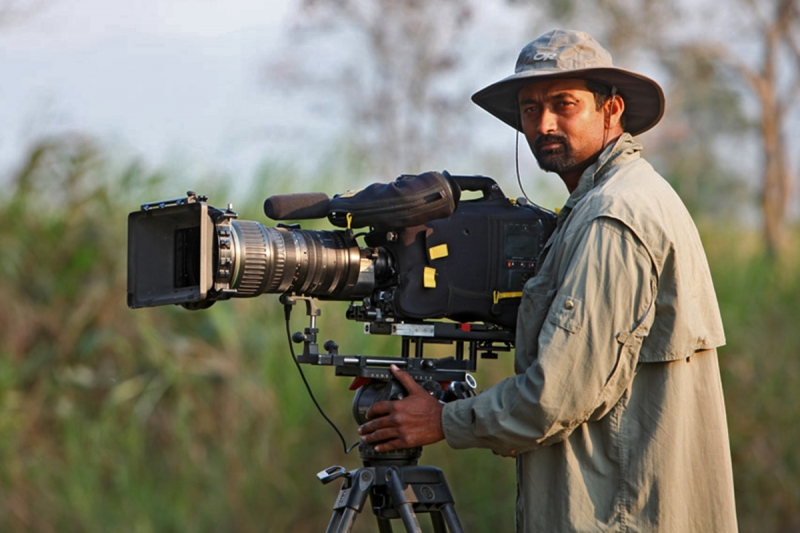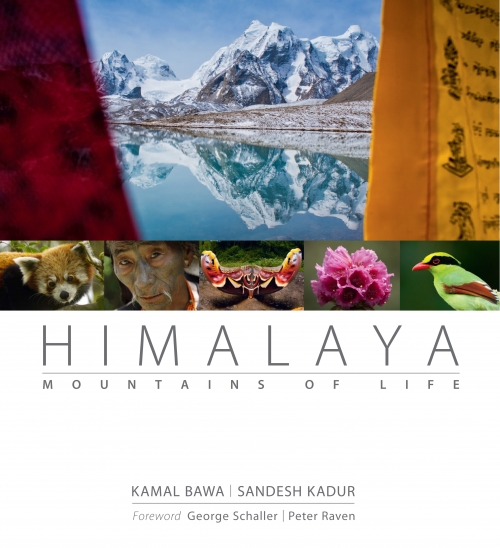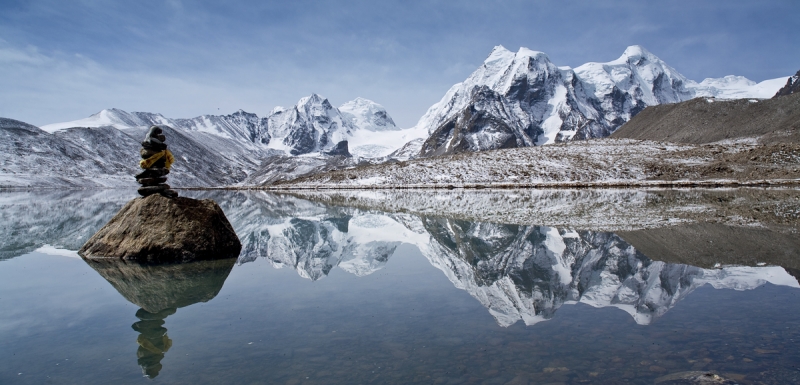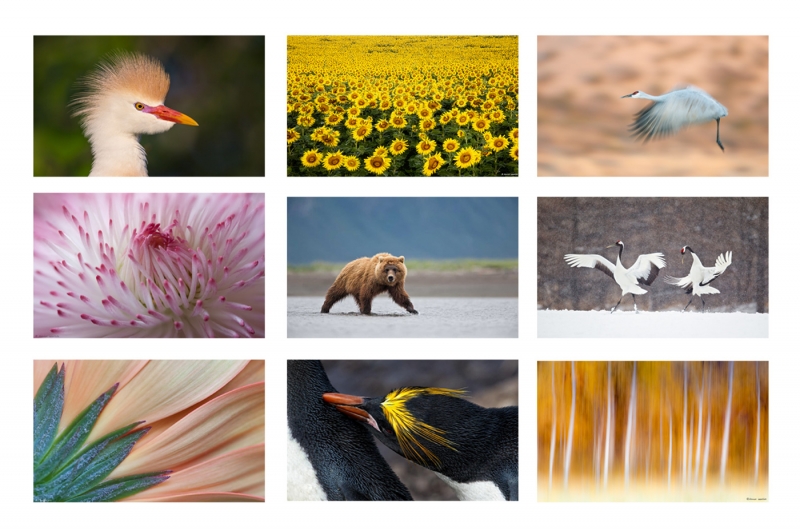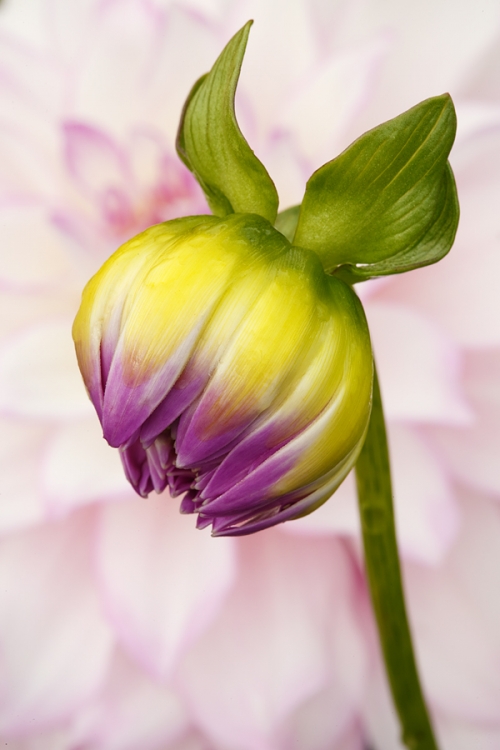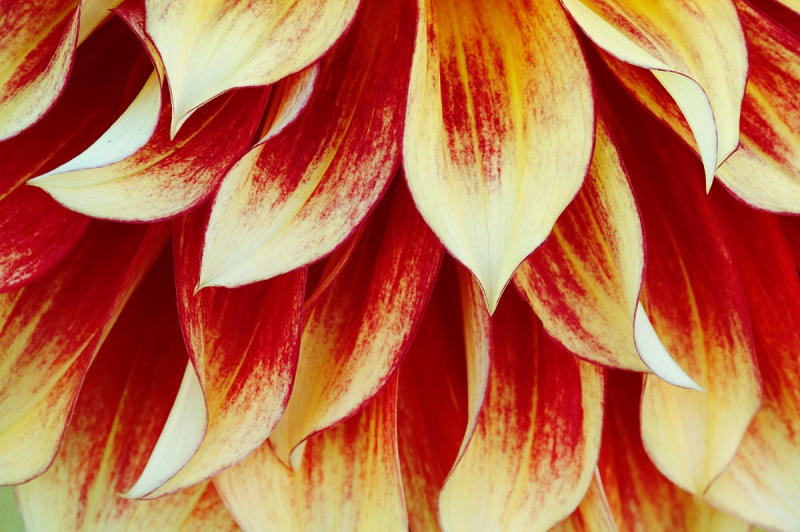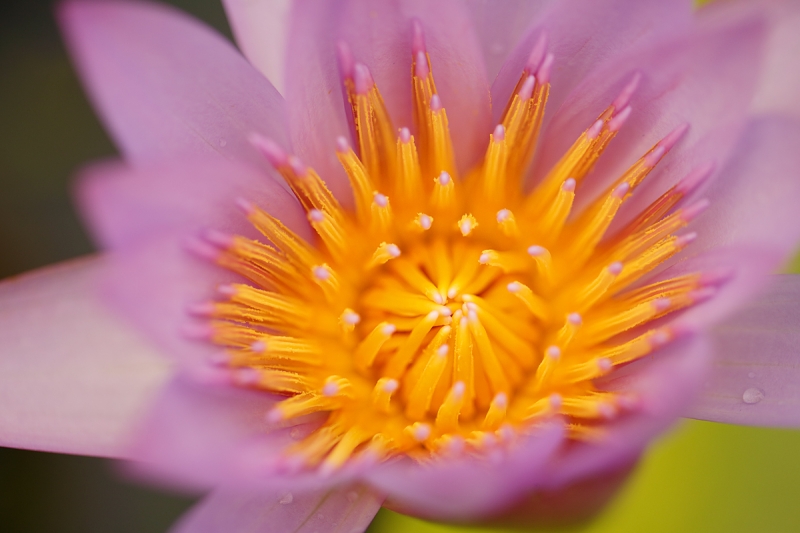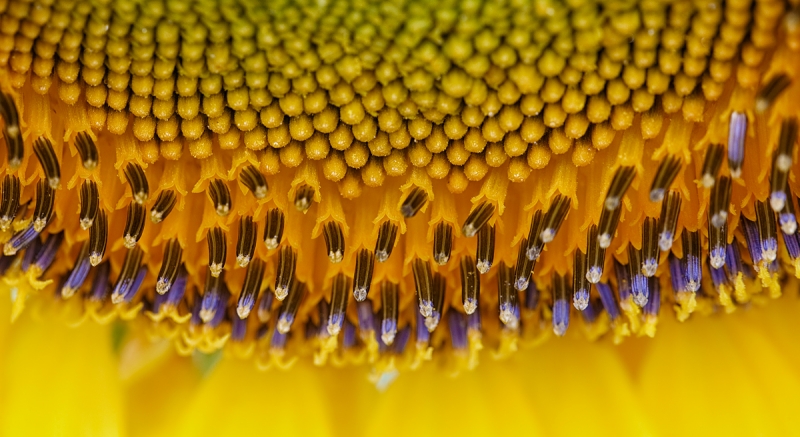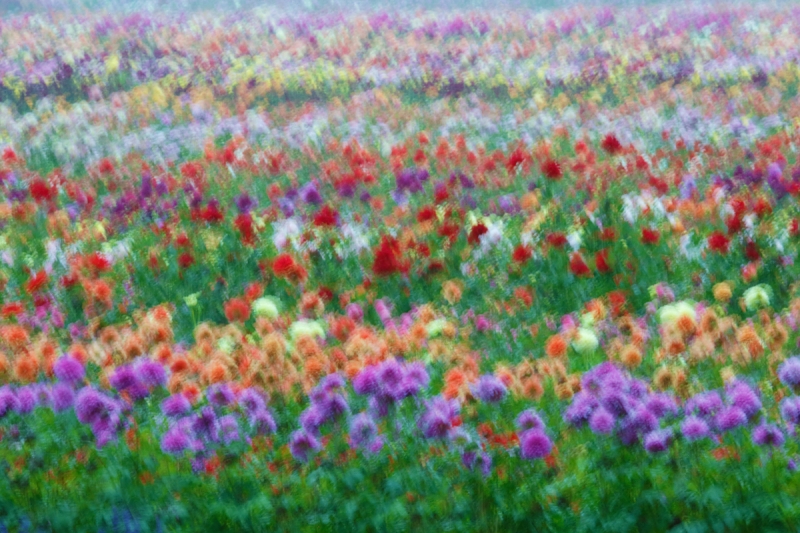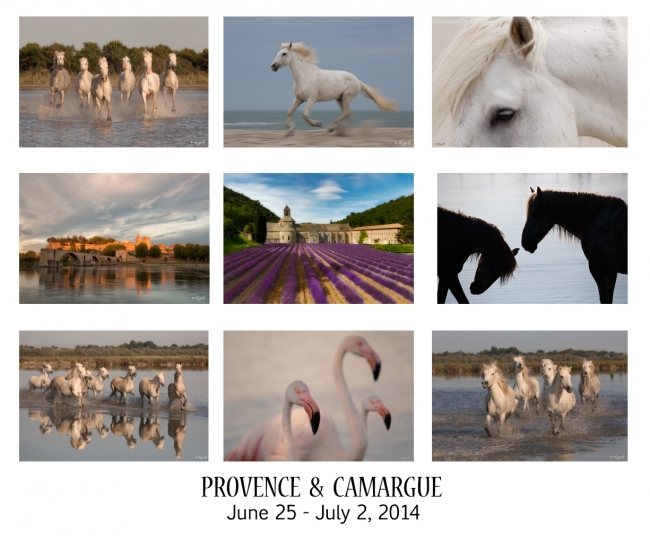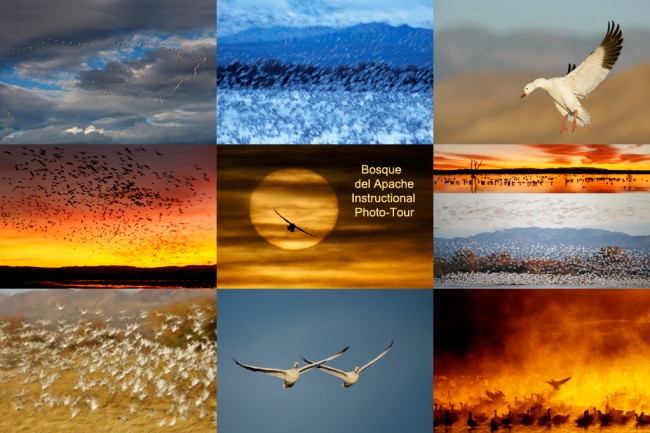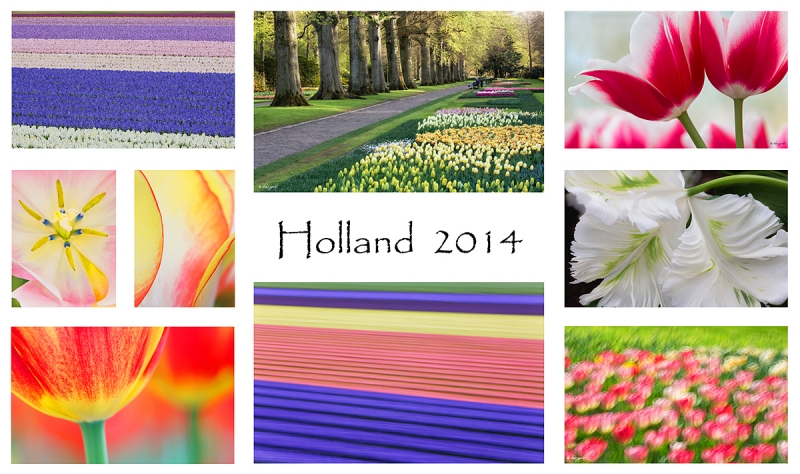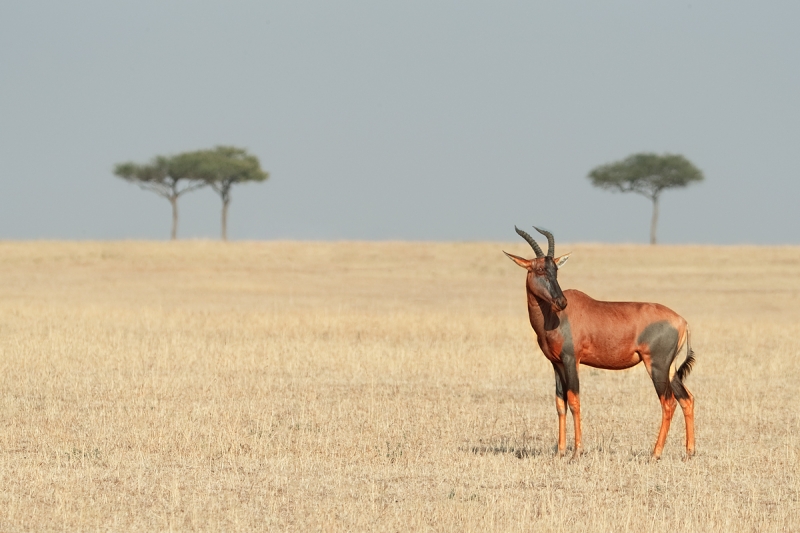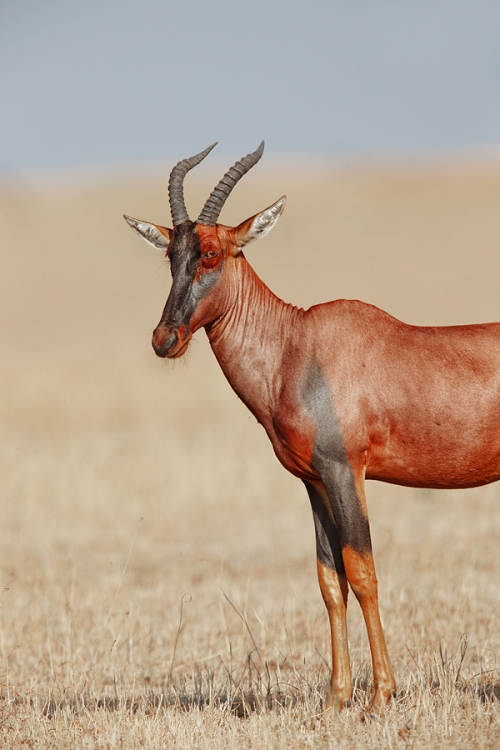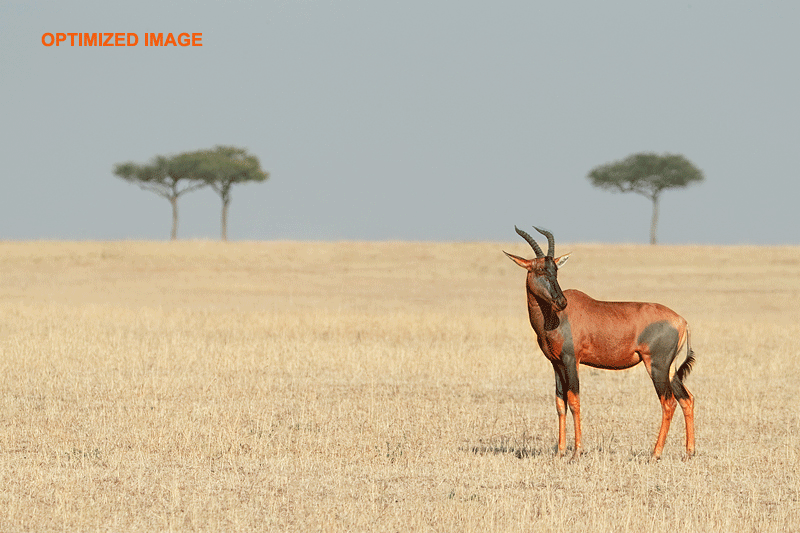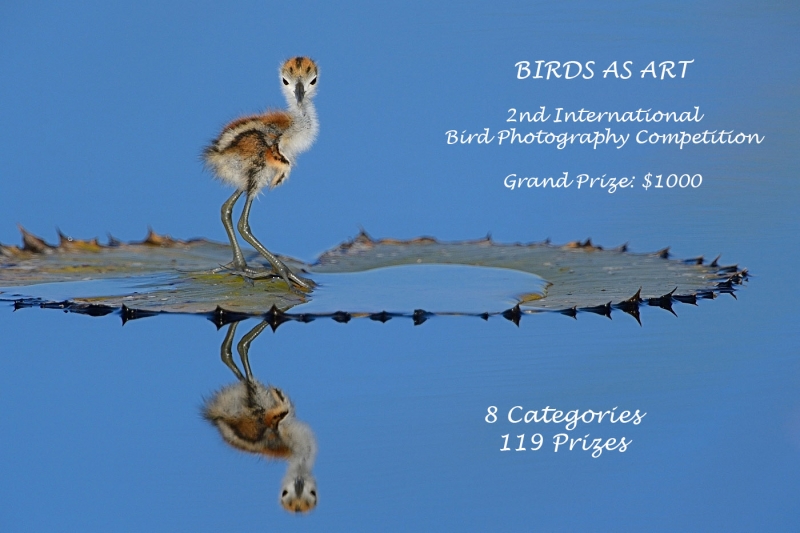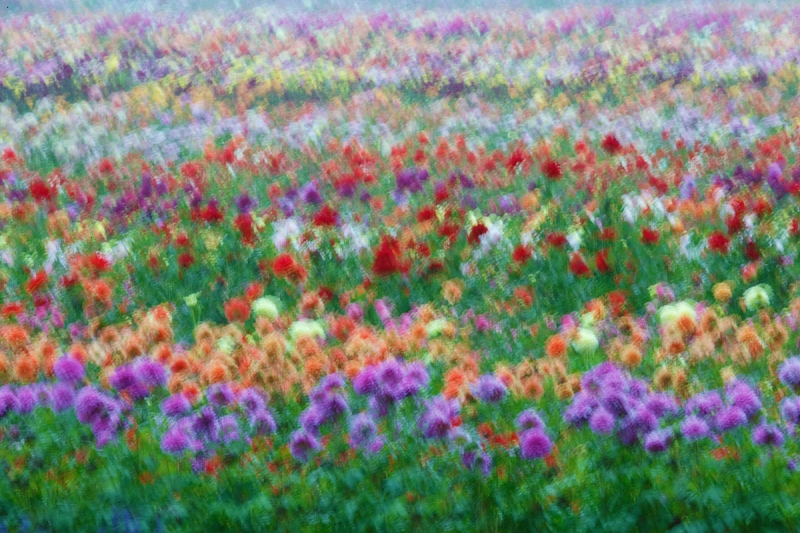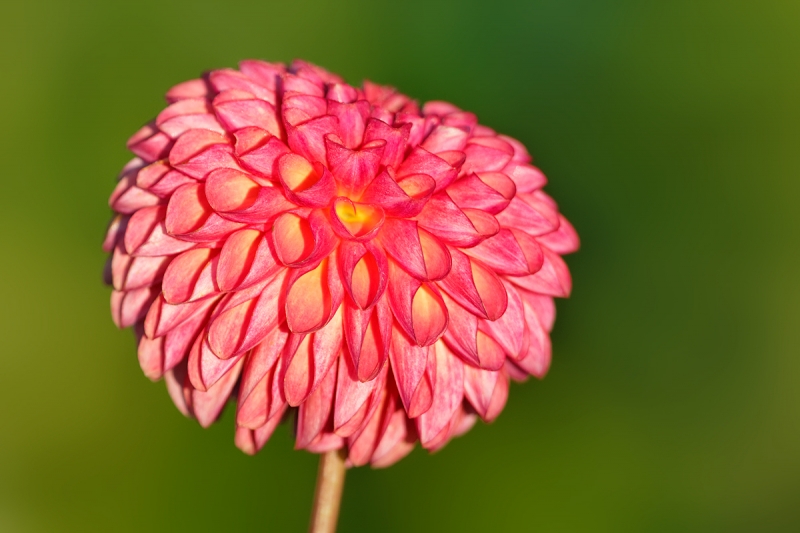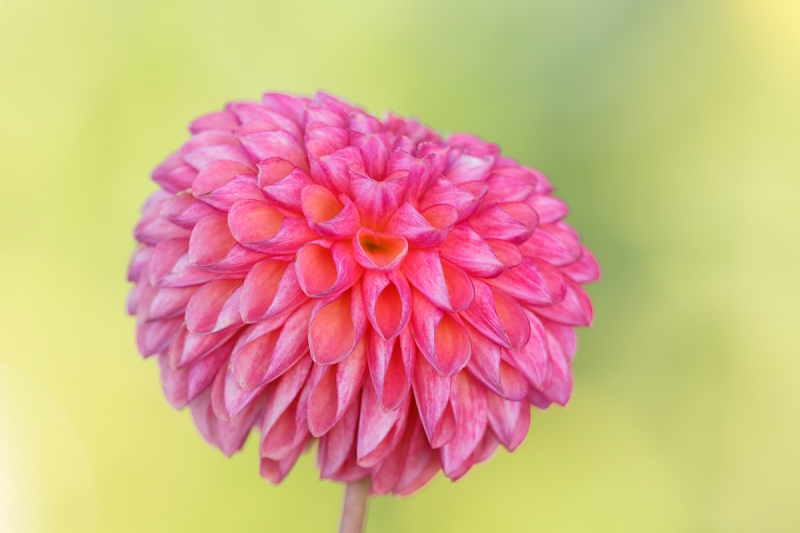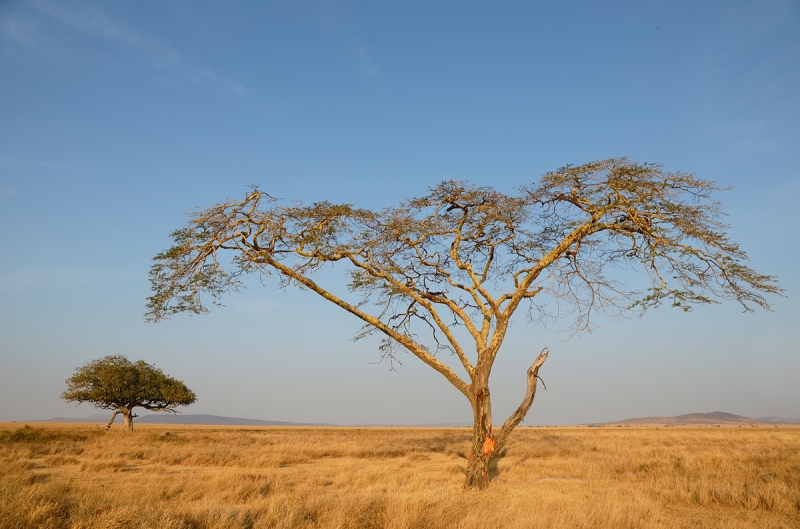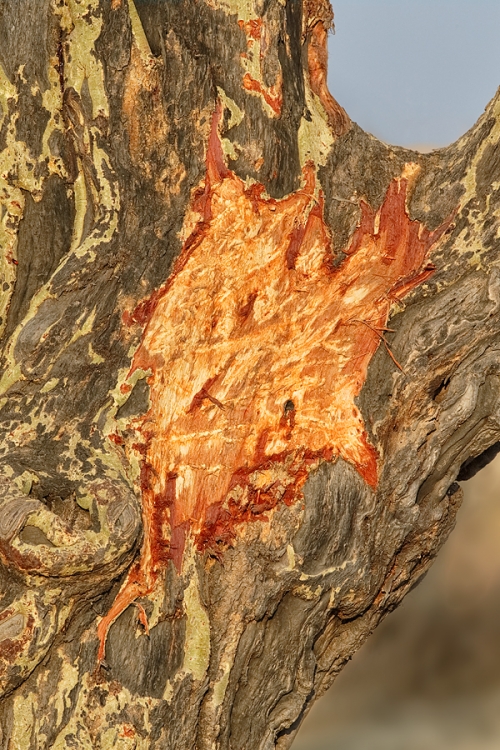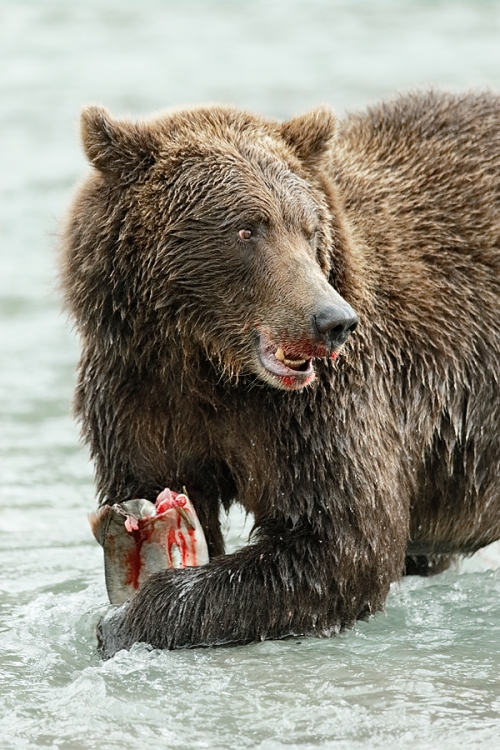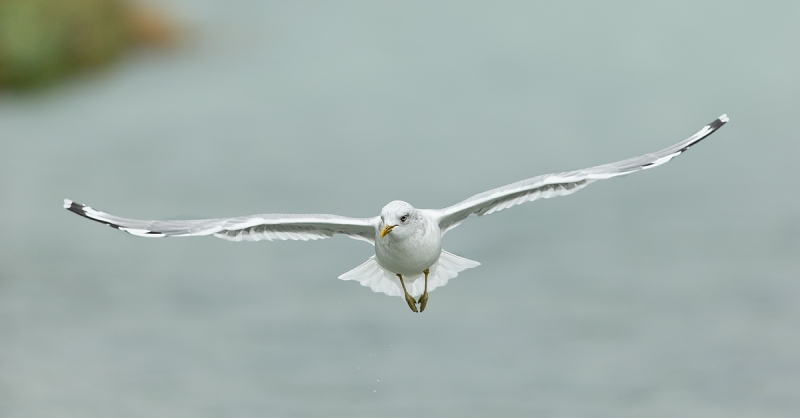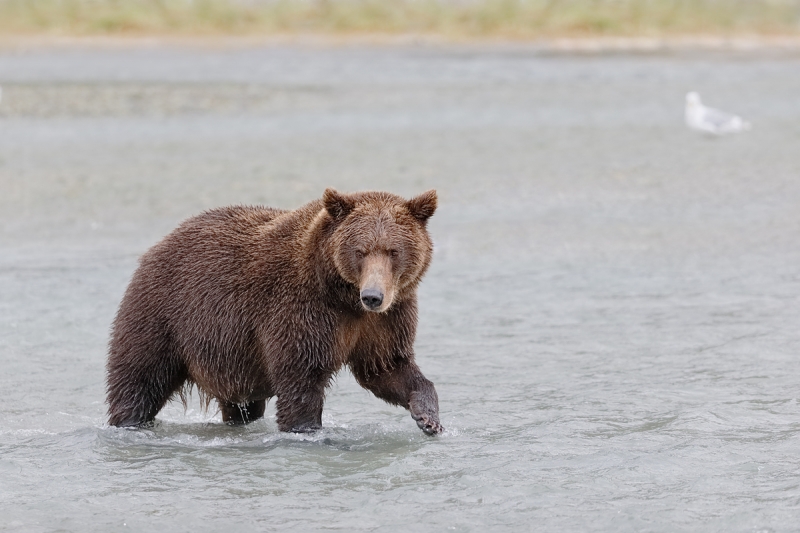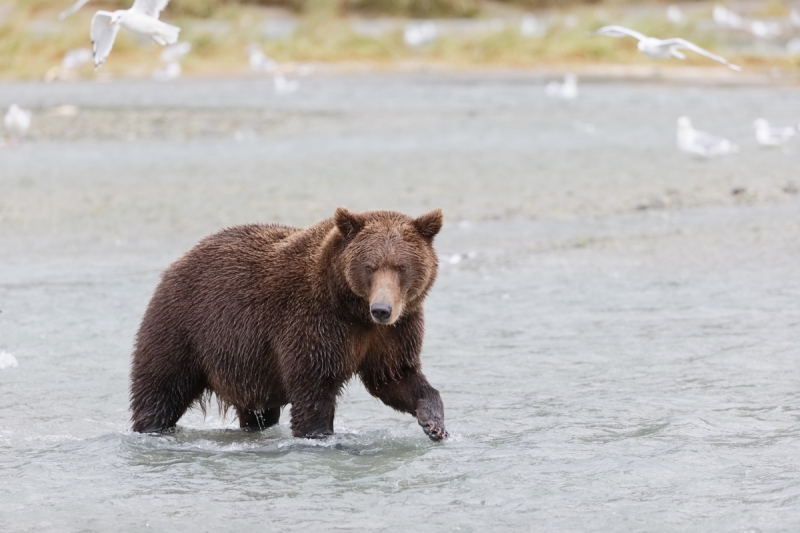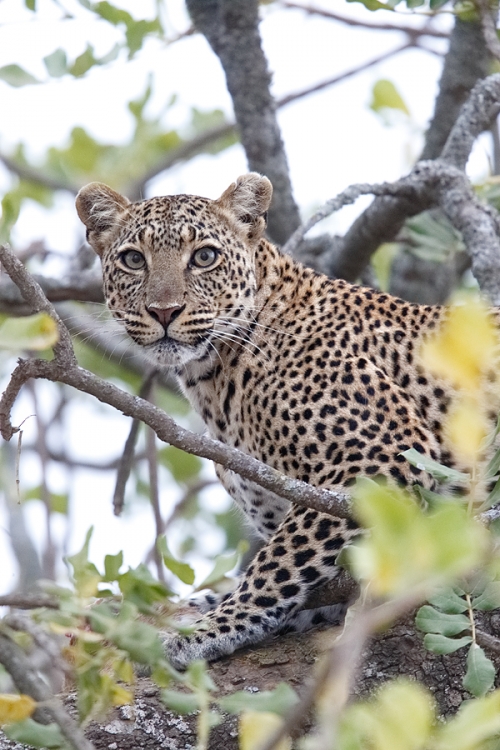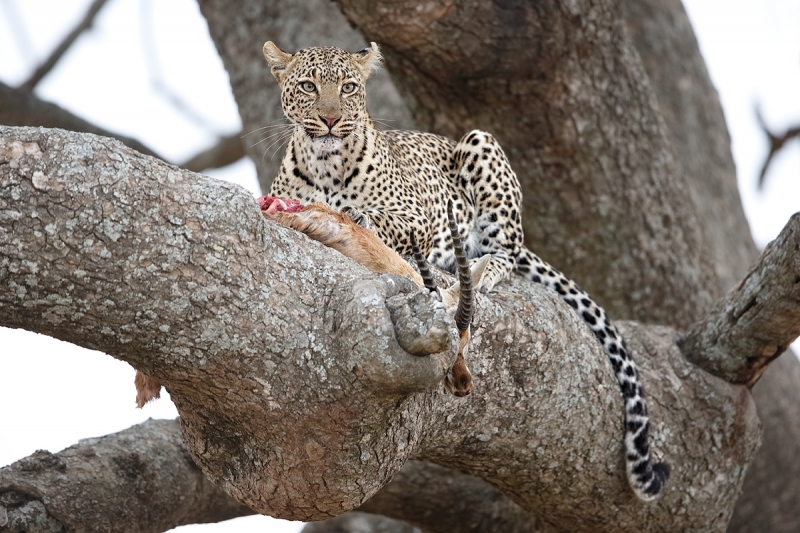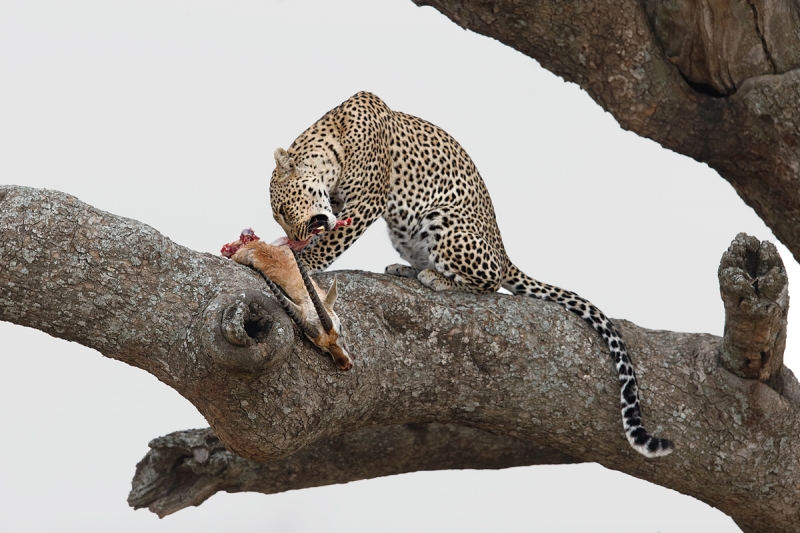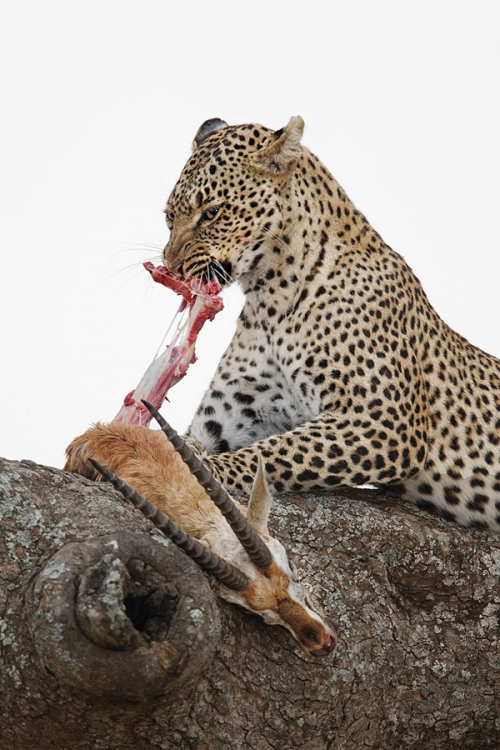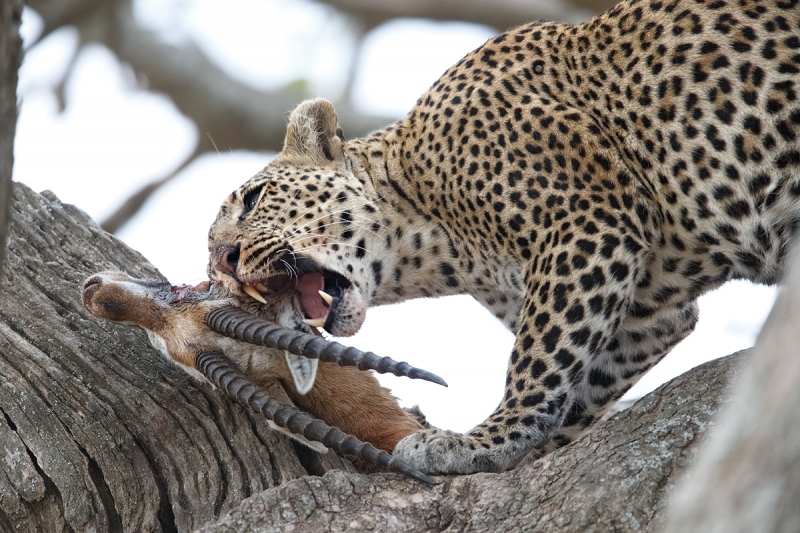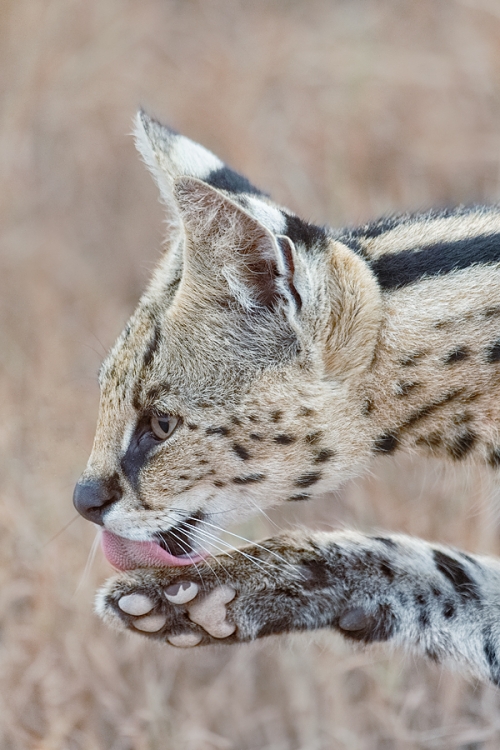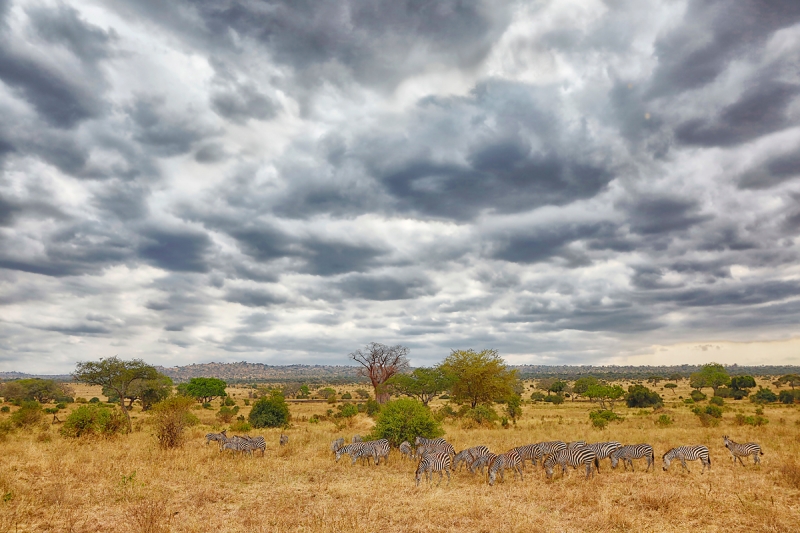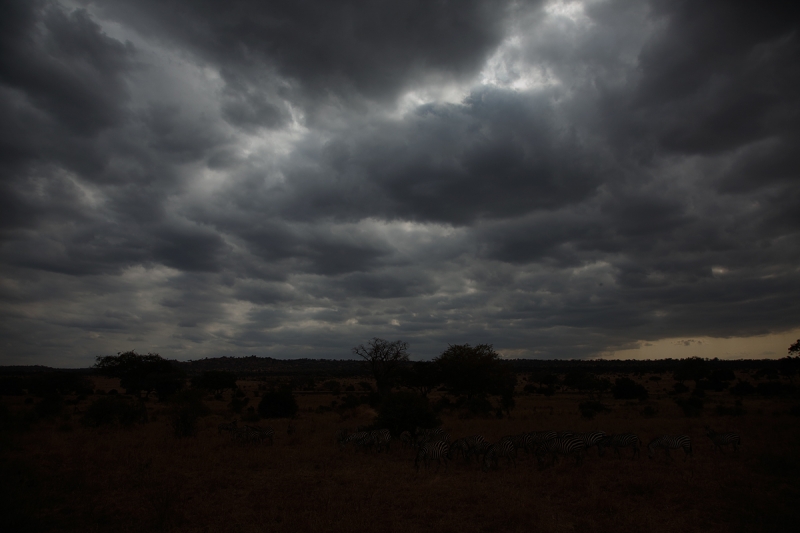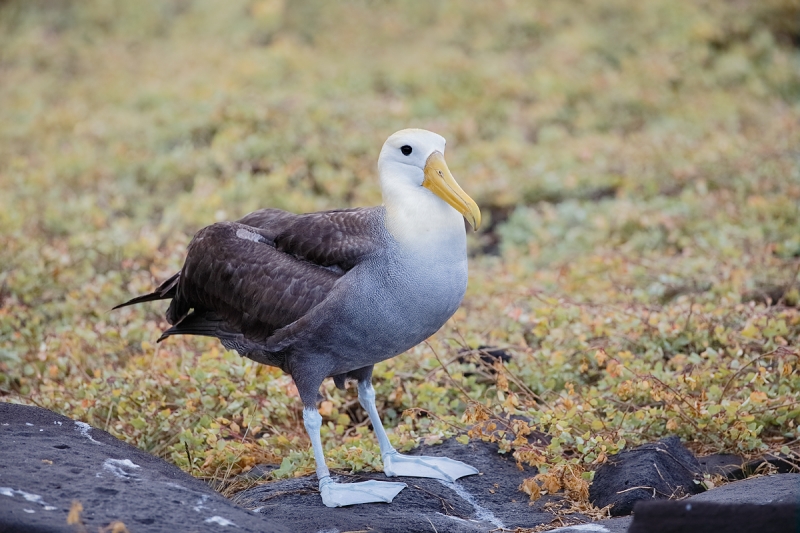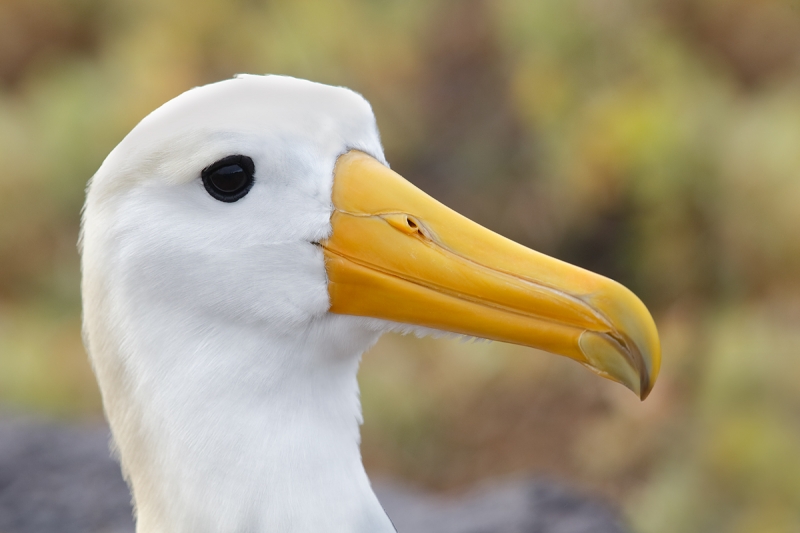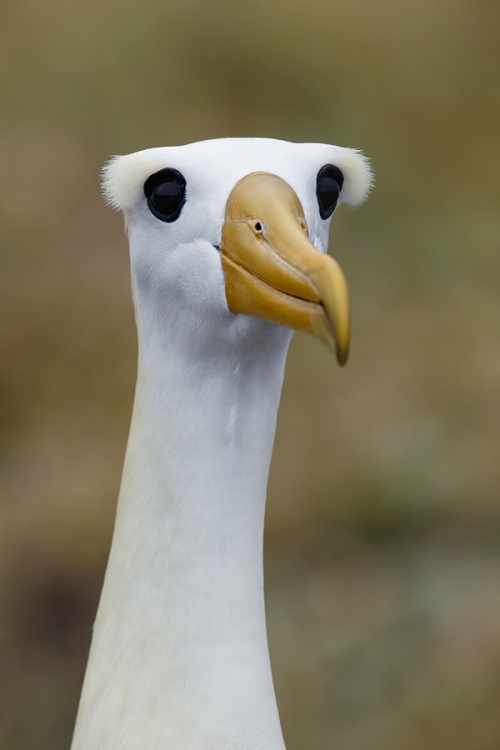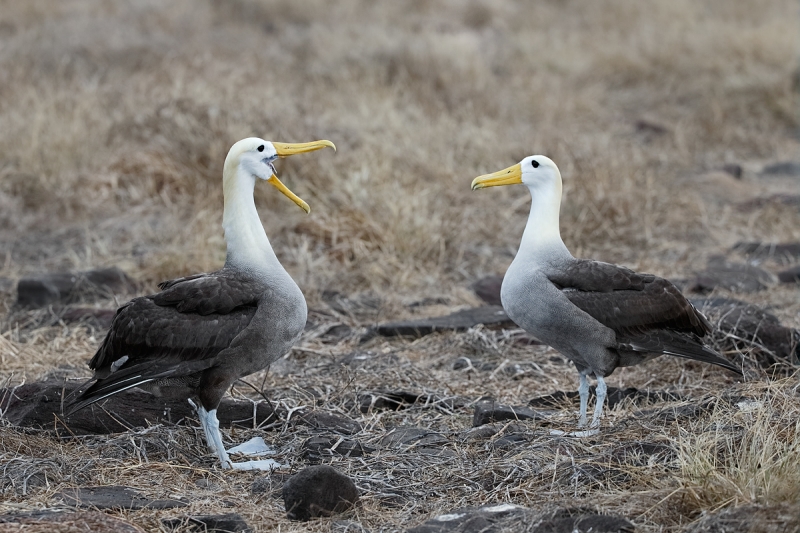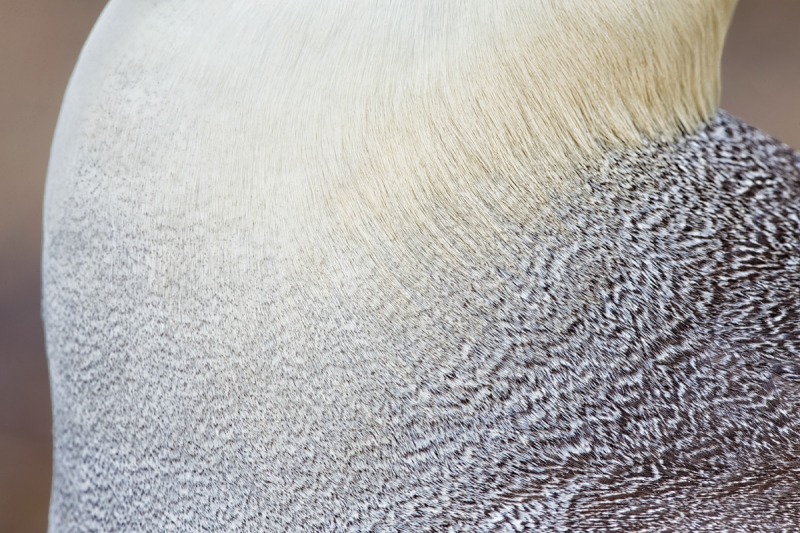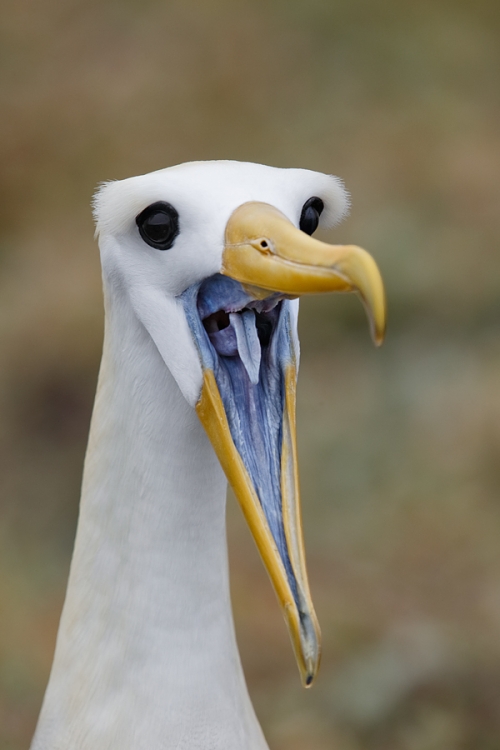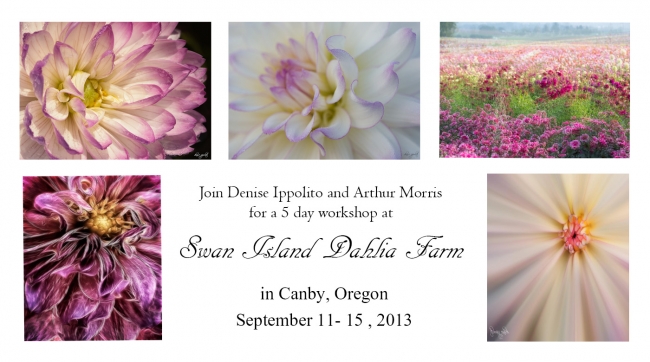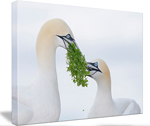October 3rd, 2013
Kvelling
kvell (kvɛl) Slang. v.i./to be extraordinarily pleased; esp., to be bursting with pride, as over one’s family. From the Yiddish kveln, be delighted; compare to Middle High German, German quellen to well up, gush.
Well, that is how I felt when I walked into the gallery building and saw the exhibition title along with one of the two signature images on the wall high above the beautifully framed, laid out, and designed exhibition. It was quite rewarding to see my three decades of hard work recognized. And it was very nice to be among the greats who proceeded me at the Museum of American Bird Art. Those include artist Robert Verity Clem, friend and field guide artist David Sibley, friend and colleague Kevin Schafer, artist Lars Jonsson, the incomparable and whimsical Charley Harper, and John James Audubon himself. Nice company. 🙂
Thanks a stack to Museum of American Bird Art director Amy Montague for her invite and for putting the exhibit together on such short notice. Kudos and thanks as well to museum staff members Sharon, Tammis, and Steve for all of their help during our visit. And a big thanks as well to volunteer Shawn Carey for his help and for all the work that he does for Mass Audubon. Shawn is quite a talented photographer; you can see his work here.
Exhibition, American Museum of Bird Art at Mass Audubon, Canton, MA
BIRDS AS ART/The Bird Photography of Arthur Morris
Though you missed the opening, all are invited to visit the exhibition at the American Museum of Bird Art at Mass Audubon (193 Washington Street, Canton, MA 02021. 1-781-821-8853.) The 35 framed-print exhibition, that is being sponsored in part by Canon USA/Explorers of Light, will run from September 29, 2013 – January 12, 2014. Open Tuesday through Sunday, 1 p.m. – 5 p.m. Click here for additional details.
Notes on the Venue
Thanks to museum director Amy Montague for sharing the following:
Mildred Morse Allen, artist and maker of natural history films, gave her 121-acre property to Mass Audubon as a bequest. I stayed in the estate house, her former home that was built in 1916 and renovated in 1998. It was quite comfortable. The beautiful gallery building, built in 1938 of stucco, served at Mildred Morse Allen’s painting studio.
|
|
|
This dahlia image was created with the hand held Canon EF 100mm f/2.8L IS macro lens and the Canon EOS 5D Mark III Digital camera body. ISO 800. Evaluative metering +1/3 stop: 1/400 sec. at f/2.8 in Av mode.
One row below and two sensors to the left of the central sensor/AI Servo Rear Focus AF as framed active at the moment of exposure. Click here if you missed the Rear Focus Tutorial. Click on the image to enjoy a larger version.
|
Catching Up I
In the Learning About and Working With a New Lens: the Canon EF 100mm f/2.8L Macro IS USM, my favorite image was the third one, the red and yellow dahlia with the offset bud. I love the combination of the red and yellow and love that the
bud, being a bit closer to me than the flower itself, was rendered slightly out of focus.
My second favorite was the first one, the green bud with the purple trim and the white/pink flower background with just the right amount of detail.
Catching Up II
In the Big Bird feature here, I liked them all but my favorite was the third one, the tight vertical Ostrich portrait.
Catching Up III
Answers to the Image Quiz in the World’s Most Beautiful Crane Species? blog post here.
#1: With focus on the crane that was farthest away, why was there enough depth-of-field (at only f/6.3) to render the closer cranes sharp?
A: depth of field increases as the distance to the subject increases. The group of cranes was far away.
#2: With small areas of white in the frame, why didn’t the +2/3 stop exposure compensation burn the highlights?
A: Early morning light is very soft and the image averaged to a light tone….
#3: Why Tv mode?
A: So that, in combination with either ISO Safety Shift (that I use) or Auto ISO, I could quickly and easily set a minimum acceptable shutter speed, one that would be fast enough to ensure the creation of a sharp image.
Coastal Carolina Camera Club Meeting: A Bird Photographer’s Story
I will be presenting ” A Bird Photographer’s Story” on Tuesday, October 8, 2103 from 7:00-9:00pm for the Coastal Carolina Camera Club. This event, which will be held in the Fellowship Hall, Shallotte Presbyterian Church, 5070 M H Rourk Drive, Shallotte, NC 28470, is being sponsored by Canon USA/Explorers of Light and will be free and open to the public. Click here for more information.
Huntington Beach State Park In-the-Field Workshop: Tuesday, October 8, 2013: $250
In conjunction with the program above, I will be conducting an In-the-Field Workshop at Huntington Beach State Park, Murrells Inlet, SC from 7-11am.
Bird photography enthusiasts will be able to take advantage of Morris’ expertise in a hands-on, in-the-field workshop at one of the most popular locations for viewing birds, Huntington Beach State Park. Class size is limited to 12 so that everyone will receive lots of personal attention. In the workshop, you will learn: how to get the right exposure every time with digital, how to get closer to your subjects without scaring them, how to choose the best perspective, flight photography tips and techniques, gear handling and tripod tips and techniques, and how to see, understand, and use the light effectively.
Register now by calling Jim at the office at 863-692-0906 with your credit card in hand.
Holland Heating Up
Signed up another Happy Camper today; pending the arrival of the promised checks, we now have seven folks for the Touch of Holland Tulip IPT. Click here and scroll down for details.
Bosque IPTs
For information on both the 7-Day and the recently announced short version of the 2013 Bosque IPTs please click here and scroll down.
Support the BAA Blog. Support the BAA Bulletins: Shop B&H here!
We want and need to keep providing you with the latest free information, photography and Photoshop lessons, and all manner of related information. Show your appreciation by making your purchases immediately after clicking on any of our B&H or Amazon Affiliate links in this blog post. Remember, B&H ain’t just photography!


Amazon
Everyone buys something from Amazon, be it a big lens or deodorant. Support the blog by starting your search by starting your search by clicking on the logo-link below. No purchase is too small to be appreciated; they all add up. Why make it a habit? Because I make it a habit of bringing you new images and information on an almost daily basis.
Typos
On all blog posts, feel free to e-mail or leave a comment regarding any typos, wrong words, misspellings, omissions, or grammatical errors. Just be right. 🙂
October 2nd, 2013
|
|
|
This image was created with the Canon 24-105mm f/4L IS EF USM AF lens hand held at 32mm) and the Canon EOS 5D Mark III ISO 400. Evaluative metering +1 stop: 1/500 sec. at f/10.
Two sensors to the left of the central sensor/AI Servo Rear Focus AF on the elephant’s mouth active at the moment of exposure. Click here if you missed the Rear Focus Tutorial. Be sure to click on the image to enjoy a larger version.
|
Big Tusker
We saw this big African Elephant a long way off. With its 7 foot tucks, it stood out from the crowd. Patrick Sparkman was in my safari van. We were so enthralled with those huge tusks that though we were both experienced photographers we each made the mistake of making images of the animal with the 600II/2X III TC combination when the image was far far away on a hot dusty morning. With the heat shimmer, haze, and dust between us and our subject we deleted every image.
We waited patiently as the elephant walked steadfastly towards our van. When he angled away a bit while foraging, we had Niko back up the van about 100 meters. When the animal crossed the road it turned right, and headed directly towards us while munching on the large shrubs on the side of the road. When it was obvious that it would wind up right next to the van both Patrick and I grabbed the 24-105s, opened the side windows, and began making images. At one point I was wishing that I had my fish eye lens on!
|
|
|
This in-camera HDR Art Vivid image was created with the hand held Canon EF 200-400mm f/4L IS USM Lens with Internal 1.4x Extender (with the internal TC in place at 473mm) and the Canon EOS 5D Mark III. ISO 400. Evaluative metering +1 stop yielded a base exposure of 1/1600 sec. at f/5.6.
Three sensors to the left and two rows below the central sensor/AI Servo Rear Focus AF on the Wildebeest’s face active at the moment of exposure. Click here if you missed the Rear Focus Tutorial. Click on the image to see a larger version.
|
Down by the Lake with Willy the Wildebeest
After yesterday’s lion/hyena adventure (see here), and after creating the elephant image above, we came upon this rather regal-looking (if that is possible for a Bearded Gnu) Wildebeest. First, I photographed it from the top of the van, and then for the image above, got lower by working out of the opened side window with the hand held 200-400. I went to HDR Art Vivid to counteract the rather harsh light and getting low yielded a nice background of the lake with a smattering of flamingos.
|
|
|
This image was created with the hand held Canon EF 200-400mm f/4L IS USM Lens with Internal 1.4x Extender (with the internal TC in place at 473mm) and the Canon EOS-1D X. ISO 1600. Evaluative metering at zero: 1/125 sec. at f/5.6 in Tv mode+.
Central sensor/AI Servo Rear Focus AF as framed active at the moment of exposure. Click here if you missed the Rear Focus Tutorial. Click on the image to see a larger version.
|
Grant’s Wears the Pants
Grant’s Gazelle, the largest of the 3 common antelopes in East Africa, is easily identified by its white belly and its white inner leg linings, thus the “Grant’s wears the pants” tagline. All of the images in this and the previous blog post (mentioned above) were created on August 16, 2013 at Ngorongoro Crater on the Tanzania Summer Safari. Having the opportunity to photograph so many different large mammals in a single day is one of the great attractions of being on safari.
Image Questions
Why Tv mode in the soft, pre-dawn light?
Why make this image at zero in the soft predawn light when I would normally adding one full stop of light?
Your Favorite?
Which of the three images above is your favorite? Be sure to let us know why.
2014 Tanzania Summer Safari
2014 Tanzania Summer Safari, 14-day African Adventure/leave the US on August 9. Fly home on August 24: $12,999.
Co-leaders Todd Gustafson & Arthur Morris. Denise Ippolito will be added when 8 folks are signed up. The limit is 12. Three photographers/van; you get your own row of seats. Our trip is a bit more expensive than the average safari for good reason. It is the best. We have the best driver guides with a total of decades of experience. They have been trained over the years by Todd and by me to drive with photography in mind.We have the best and most knowledgeable leaders. We stay in the best lodges and camps. We hope that you will join us for what will be Todd’s 35th African safari, and my 8th.
If you are seriously interested please e-mail me; I will be glad to send you the illustrated PDF with the complete itinerary and deposit info.
What else makes this expedition unique?
•Pre-trip consultation and camera equipment advice
•Award-winning photographers as your guides
•A seamless itinerary visiting the right locations at the best time of year
•Hands-on photography instruction in the field
•Specially designed three rood hatch photo safari vehicles
•Proprietary materials for preparation, including free copy of “A Photographer’s Guide to Photographing in East Africa.”
•Post-safari image critiques
All-inclusive (double-occupancy) except for your flights to and from Kilamajaro Airport, bar drinks, soda & water (except at the Intimate Tented Camp where everything is free for our entire stay), tips for drivers and camp staff, personal items, and trip insurance.
Holland Heating Up
Pending the arrival of promised checks, we now have six folks for the Touch of Holland Tulip IPT. Click here and scroll down for details.
Bosque IPTs
For information on both the 7-Day and the recently announced short version of the 2013 Bosque IPTs please click here and scroll down.
Support the BAA Blog. Support the BAA Bulletins: Shop B&H here!
We want and need to keep providing you with the latest free information, photography and Photoshop lessons, and all manner of related information. Show your appreciation by making your purchases immediately after clicking on any of our B&H or Amazon Affiliate links in this blog post. Remember, B&H ain’t just photography!


Amazon
Everyone buys something from Amazon, be it a big lens or deodorant. Support the blog by starting your search by starting your search by clicking on the logo-link below. No purchase is too small to be appreciated; they all add up. Why make it a habit? Because I make it a habit of bringing you new images and information on an almost daily basis.
Typos
On all blog posts, feel free to e-mail or leave a comment regarding any typos, wrong words, misspellings, omissions, or grammatical errors. Just be right. 🙂
September 30th, 2013
On the Kill
Mid-morning on our third day at Ngorongoro Crater we came upon two big male lions devouring a full grown Wildebeest. It was a tough situation with lots of grasses between us on the subject. We got lucky for an instant as seen above when this big guy stood up to pull apart its breakfast.
|
|
|
This image was created with the Canon 24-105mm f/4L IS EF USM AF lens hand held at 24mm) and the Canon EOS 5D Mark III ISO 400. Evaluative metering +1 stop: 1/125 sec. at f/20.
Central sensor/AI Servo Rear Focus AF on the closest hyena and re-compose. Click here if you missed the Rear Focus Tutorial. Be sure to click on the image to enjoy a larger version.
|
The Patient Hyenas
For this image I reached for the 24-105 in order to create the scene-setting image. Twenty-two Spotted Hyenas waited patiently for the lions to finish their meals. First one lion left. The moment that the second lion left the hyenas charged in to fight over the left-overs. One of the big lions can be see on the kill on the left side of the frame.
The Aftermath
Once the hyenas moved in we were treated to 10 minutes of great action photography as the scavengers ripped and tore and fought and ran off with their prizes. Using the bump the focus techniques that I had learned while editing Jim Neiger’s great new e-Guide, “Flight Plan” helped me make lots of sharp images of the running Spotted Hyenas. Click here to learn more about “Flight Plan.”
2014 Tanzania Summer Safari
If you are interested in joining us in Tanzania next summer please shoot me an e-mail and I will be glad to forward you the PDF with dates, itinerary, and price.
Holland Heating Up
Pending the arrival of promised checks, we now have six folks for the Touch of Holland Tulip IPT. Click here and scroll down for details.
Bosque IPTs
For information on both the 7-Day and the recently announced short version of the 2013 Bosque IPTs please click here and scroll down.
Support the BAA Blog. Support the BAA Bulletins: Shop B&H here!
We want and need to keep providing you with the latest free information, photography and Photoshop lessons, and all manner of related information. Show your appreciation by making your purchases immediately after clicking on any of our B&H or Amazon Affiliate links in this blog post. Remember, B&H ain’t just photography!


Amazon
Everyone buys something from Amazon, be it a big lens or deodorant. Support the blog by starting your search by starting your search by clicking on the logo-link below. No purchase is too small to be appreciated; they all add up. Why make it a habit? Because I make it a habit of bringing you new images and information on an almost daily basis.
Typos
On all blog posts, feel free to e-mail or leave a comment regarding any typos, wrong words, misspellings, omissions, or grammatical errors. Just be right. 🙂
September 28th, 2013
|
|
|
This dahlia image was created with the hand held Canon EF 100mm f/2.8L IS macro lens and the Canon EOS 5D Mark III Digital camera body. ISO 800. Evaluative metering +1 1/3 stops: 1/250 sec. at f/4.5 in Av mode.
One row above and one sensor to the left of the central sensor/AI Servo Rear Focus AF as framed active at the moment of exposure. Click here if you missed the Rear Focus Tutorial. Click on the image to enjoy a larger version.
I added sections on 2 new lenses to my morning program; see below for details. We worked extensively with the group on the recently concluded Swan Island Dahlia Farm IPT on backgrounds and creating bud/flower background images like this. See info on the September 2014 trip below.
|
HVPN
Denise Ippolito and I wowed the more than 120 folks who assembled at the Ramada Inn in Fishkill, NY for the Hudson Valley Photographic Network’s Fall Conference today. Denise began with her hugely popular and inspirational “Bloomin’ Ideas” program. I followed with “Choosing and Using Lenses for Nature Photography” after spending yesterday afternoon refining–aka deleting some images–the program and adding new sections on the 200-400 f/4L IS with Internal 1.4X Extender and on the 100 f/2.8L IS macro lens.
After lunch denise and I did our joint program, “Pleasing Blurs.” We are happy to report that not a single attendee was seen nodding off to sleep all day! A quick internet search revealed Golden Buddha Thai Cuisine, 985 Main St, Fishkill, NY. We enjoyed a sumptuous dinner of great thai food. We were waited on by the owner’s shy, delightful, and beautiful young granddaughter. The entire evening was a delightful experience as we had a long chat with the owner after dinner. Learn more about Golden Buddha Thai here.
We are off early tomorrow for the opening of the exhibition of my work at the Museum of American Bird Art at Mass Audubon followed by another seminar on Monday and a special presentation of “A Bird Photographer’s Story on Tuesday evening. Do join us and say “Hi” if at all possible. Complete details can be found here.
|
|
|
Images copyright Arthur Morris/BIRDS AS ART & Denise Ippolito/A Creative Adventure. Card design by denise.
|
Announcing the 2014 Swan Island Dahlia Farm IPT
A Creative Adventure/BIRDS AS ART Swan Island Dahlia Farm Instructional Photo-Tour, September 8-12, 2014: 5 FULL DAYS: $1699. Meet and Greet: September 7 at 8pm.
Join Denise Ippolito and Arthur Morris at the Swan Island Dahlia Farm in Canby Oregon (just south of Portland) for a great learning and photography experience. Swan Island features more than 40 acres with over 350 varieties of dahlias in a plethora of colors, shapes and sizes, making it one of the largest growers in the United States.
Daily Photo Schedule
We will enjoy four morning (7:00am till 10:30am) and five afternoon (3:30pm till 6pm) photography sessions. While we will do most of our photography at the Swan Island Dahlia Farm, we will also visit the Portland Rose Garden and/or the Portland Japanese Garden on this IPT. We may visit the Hughes Water Gardens and a local sunflower field as well. The in-the-field instruction will include seeing the situation, the use of selective focus, creative use of depth of field, histogram and exposure guidance, designing creative images, choosing your background, isolating your subject, lens options, and the use of reflectors and diffusers. Our field sessions will include challenging photography assignments geared to make you think creatively. Both personalized and small group instruction will be provided. All times are tentative and subject to change based on the weather and on local conditions. All are invited to bring their laptops to lunch for image sharing on Monday and Wednesday through Friday.
The group will have lunch together daily except for Tuesday, the seminar morning; lunch will be on your own that day. We hope that you can join us for an intense five days of learning and some of the best flower photography to be had in North America.
Seminar Morning: Tuesday September 9: 8:30am till 12:30pm
Denise will begin by presenting her “Bloomin’ Ideas” program, an overview of the in-the-field and post-processing techniques that she has used and developed over the past few years to create her signature look. Artie will follow with a Photoshop session that will be geared towards all levels. He’ll be sharing some of his favorite techniques and tips while working on images from the first two days of the IPT. Denise will conclude the seminar portion of the IPT with a Photoshop demo; she will share her creative workflow using a variety of Photoshop filters and effects. The entire morning is designed to give you a peek into the minds of two very skilled and creative folks. Lunch on your own.
Deposit Info and Cancellation Policies:
A $499 non-refundable deposit is required to hold your slot for this IPT. Your balance is due 4 months before the date of the IPT and is also non-refundable. If the trip fills, we will be glad to apply a credit applicable to a future IPT for the full amount less a $100 processing fee. If we do not receive your check for the balance on or before the due date we will try to fill your spot from the waiting list. If your spot is filled, you will lose your deposit. If not, you can secure your spot by paying your balance.
Please print, complete, and sign the form that is linked to here and shoot it to us along with your deposit check (made out to “Arthur Morris.”) You can also leave your deposit with a credit card by calling the office at 863-692-0906. If you register by phone, please print, complete and sign the form as noted above and either mail it to us or e-mail the scan.
If you have any questions, please feel free to contact me via e-mail
September 27th, 2013
|
|
|
This image of a courting group of Grey-crowned Cranes was created with the Todd-pod mounted Canon EF 600mm f/4L IS II USM lens, the Canon 1.4x EF Extender III (Teleconverter), and the Canon EOS-1D X Digital SLR camera. ISO 1250 Evaluative metering +2/3 stop: 1/1000 sec. at f/6.3 in Tv mode in very early morning light.
Two sensors to the left of the central sensor/AI Servo Surround/Rear Focus AF on the base of the wing of the bird with its wings raised, active at the moment of exposure. Click here if you missed the Rear Focus Tutorial. Click on the image to see a larger version.
|
Grey-crowned Crane
From the moment that I saw my first Grey-crowned Crane, on safari with Todd Gustafson, Patty Ardoin, her late husband Wes, and many others, probably in 2001, I fell in love. When I visited Tanzania fairly regularly, we did see this species fairly often, but they were somewhat hard to come by in the winter months. On the Summer Safari last August they were abundant, and best of all, they were flying around and dancing and courting. That made for exciting times at Ngorongoro Crater. I can’t wait to get back next year.
Image Quiz
#1: With focus on the crane that was farthest away, why was there enough depth-of-field (at only f/6.3) to render the closer cranes sharp?
#2: With small areas of white in the frame, why didn’t the +2/3 stop exposure compensation burn the highlights?
#3: Why Tv mode?
|
|
|
This image of a landing Grey-crowned Crane was created with the Todd-pod mounted Canon EF 600mm f/4L IS II USM lens, the Canon 2x EF Extender III (Teleconverter), and the Canon EOS-1D X Digital SLR camera. ISO 400. Evaluative metering +1/3 stop: 1/1000 sec. at f/8 in Manual mode in early morning light.
Central sensor (by necessity)/AI Servo Expand/Rear Focus AF just caught the base of the bird’s neck, active–of course–at the moment of exposure. Click here if you missed the Rear Focus Tutorial. Click on the image to see a larger version.
See the animated GIF below for the before and after comparison.
|
World’s Most Beautiful Crane Species?
With their grey body feathers, reddish brown flight feathers, soft white wing coverts with a faint yellow wash to them, red wattles, white face ovals with the red accent above it, black caps, light blue irises, and their amazing gold crests, it is hard to image a more beautiful crane species.
If you have photographed a more beautiful crane species, we would love to hear from you.
The Image Optimization
After leveling and color correcting the TIFF that had been converted in Canon Digital Photo Professional (see our DPP Conversion Guide here), I cleaned up the background. Most of the distracting dark spots were zebra poop. As usual, clean-up was done with the Patch Tool, the Spot Healing Brush, and a series of small Quick Masks. I ran my NIK 50-50 only on the bird after selecting it with the Quick Selection Tool.
All of the above is detailed in our Digital Basics File. Digital Basics is an instructional PDF that is sent via e-mail. It includes my complete digital workflow, dozens of great Photoshop tips including Digital Eye Doctor techniques, several different ways of expanding canvas, all of my time-saving Keyboard Shortcuts, Quick Masking, Layer Masking and NIK Color Efex Pro basics, creating and using time-saving Actions, and tons more.
2014 Tanzania Summer Safari
If you are interested in joining us in Tanzania next summer please shoot me an e-mail and I will be glad to forward you the PDF with dates, itinerary, and price.
Flight Plan
After spending more than two months (part time) editing Jim Neiger’s great new e-Guide, Flight Plan, I learned a ton about flight photography. His explanation of the bumping the focus technique finally sunk in. Using this technique has improved my flight photography by leaps and bounds, especially when doing flight photography with an f/4 super-telephoto lens and the 2X III tele-converter (as above in the landing crane image). I remember bumping the focus as I tracked the crane on final approach and was thrilled with the sharpness of the two keepers from the short series.
You learn more about Flight Plan here or order a copy by clicking here.
First Flight Plan Feedback
Markus Jais’s paraphrased Bulletin #449 comment:
September 27, 2013 at 2:20 am
Bought Jim’s birds in flight e-guide yesterday and already read parts of it. Absolutely fantastic. The best resource out there on photographing birds in flight. Anyone interested in improving their flight photography must(!) read this. Many lessons are also helpful for other subjects like running mammals or swimming ducks. The tips on hand holding are fantastic. I often handhold my new EF 4/200-400L IS 1.4x (e.g. for marmots, swimming geese, etc) because I am faster and more flexible than with a tripod.
Many thanks to you and Jim for publishing this. I will recommend this to anyone who asks me about photographing birds in flight.
Markus
Holland Heating Up
Pending the arrival of promised checks, we now have six folks for the Touch of Holland Tulip IPT. Click here and scroll down for details.
Bosque IPTs
For information on both the 7-Day and the recently announced short version of the 2013 Bosque IPTs please click here and scroll down.
Support the BAA Blog. Support the BAA Bulletins: Shop B&H here!
We want and need to keep providing you with the latest free information, photography and Photoshop lessons, and all manner of related information. Show your appreciation by making your purchases immediately after clicking on any of our B&H or Amazon Affiliate links in this blog post. Remember, B&H ain’t just photography!


Amazon
Everyone buys something from Amazon, be it a big lens or deodorant. Support the blog by starting your search by starting your search by clicking on the logo-link below. No purchase is too small to be appreciated; they all add up. Why make it a habit? Because I make it a habit of bringing you new images and information on an almost daily basis.
Typos
On all blog posts, feel free to e-mail or leave a comment regarding any typos, wrong words, misspellings, omissions, or grammatical errors. Just be right. 🙂
September 25th, 2013 CDLC Focus On Feature
Be sure to check out my 10-image “FOCUS ON: EF 200-400mm f/4L IS USM Extender 1.4x” feature on the Canon Digital Learning Center here. Click on the home tab for lots more great articles and videos.
|
|
|
This image was created with the Todd-pod supported Canon EF 200-400mm f/4L IS USM Lens with Internal 1.4x Extender (with the internal TC in place at 560mm) and the Canon EOS-1D X. ISO 500. Evaluative metering +1/3 stop as framed in Manual Mode: 1/640 sec. at f/6.3.
One sensor to the left and one sensor up from the Central sensor/AI Servo/Surround/Rear Focus AF as framed. Click here if you missed the Rear Focus Tutorial. Click on the image to see a larger version.
Ostrich I
|
Big Bird
We were thrilled, at 7:33 am on August 17, on the Tanzania Summer Safari, to find a gorgeous male Ostrich parading around in early morning light. As I did often on the safari, I used both the 200-400 and the 600II to create a variety of images.
On the first morning of the Swan Island Dahlia Farm IPT many of the participants approached denise and me to share their images. They would show us one image of this flower and one image of that flower. We quickly found ourselves preaching repeatedly: “Once a subject catches your eye, makes lots of images of it. Work it. Vary your perspective. Use different apertures. Change lenses. Make some horizontals. Make some verticals.”
Except for the “use different apertures” bit, the same advice is equally important on safari. Once we realized that we had a cooperative subject, we directed our driver/guide to move the van probably more than 20 times to secure a new perspective and try for ideal, uncluttered backgrounds.
|
|
|
This image was also created with the Todd-pod supported Canon EF 200-400mm f/4L IS USM Lens with Internal 1.4x Extender (with the internal TC in place at 560mm) and the Canon EOS-1D X. ISO 500. Evaluative metering +2/3 stop as framed in Manual Mode: 1/500 sec. at f/6.3.
Three sensors to the left and one sensor up from the Central sensor/AI Servo/Surround/Rear Focus AF as framed. Click here if you missed the Rear Focus Tutorial. Click on the image to see a larger version.
Ostrich II
|
Handsome Boy!
Our cooperative Ostrich was a handsome male in full breeding plumage. There was a female nearby. We hoped against hope that they would begin their amazing courtship behavior but that was not to be. We did see the Ostrich dance twice that morning, both times with distant, backlit subjects.
Your Fave?
Which of the three Ostrich images is your favorite? Be sure to let us know why.
Ostrich Image Questions
In Ostrich I, why didn’t I point the lens more to the right to effectively move the subject more to our left in the frame?
In Ostrich II, where would you have put the bird in the frame?
After clicking on each photo to see a larger version can you determine which of the three images is the least sharp on the face?
Flight Plan
Check out Jim Neiger’s great, long-awaited new e-Guide on photographing birds in flight here.
See You Soon!
I fly to Islip tomorrow for a whirlwind tour of the northeast with Denise Ippolito with stops in Fishkill, NY on Saturday followed by a series of events in Canton, MA just south and east of Boston. It is not too late to register for any of the three great events. No need to register for the Tuesday night Mass Audubon special program. Click here for complete details and links.
2014 Tanzania Summer Safari
If you are interested in joining us in Tanzania next summer please shoot me an e-mail and I will be glad to forward you the PDF with dates, itinerary, and price.
Bosque IPTs
For information on both the 7-Day and the recently announced short version of the 2013 Bosque IPTs please click here and scroll down.
Support the BAA Blog. Support the BAA Bulletins: Shop B&H here!
We want and need to keep providing you with the latest free information, photography and Photoshop lessons, and all manner of related information. Show your appreciation by making your purchases immediately after clicking on any of our B&H or Amazon Affiliate links in this blog post. Remember, B&H ain’t just photography!


Amazon
Everyone buys something from Amazon, be it a big lens or deodorant. Support the blog by starting your search by starting your search by clicking on the logo-link below. No purchase is too small to be appreciated; they all add up. Why make it a habit? Because I make it a habit of bringing you new images and information on an almost daily basis.
September 24th, 2013
|
|
|
Sandesh Kadur on location with one of his big lenses.
|
Meet the National Geographic Explorer/Filmmaker
Sandesh Kadur is an award-winning wildlife photographer and cinematographer with a passion for natural history. His photographs have been published widely in books and magazines, while his documentaries on subjects ranging from cobras to elephants have been aired worldwide on the BBC, Discovery, and National Geographic networks. Over the years Kadur’s work has garnered many top awards, including the CIWEM Environmental Photographer Award, Nature’s Best Award, BBC Camera-trap Award, and International Conservation Photographer Award, and has twice been nominated for a Green Oscar at Wildscreen. He is an associate fellow of the International League of Conservation Photographers (ILCP) and the International Environmental Photographers Association (IEPA), and serves as board member for the International Association of Wildlife Filmmakers. A few years ago he founded Felis Creations, a media and visual arts company that focuses on creating content that inspires conservation.
I had the pleasure of meeting a young Indian photographer in June of 2012, National Geographic videographer Sandesh Kadur (say “sun-DAYSH) on a familiarization tour of Trinidad and Tobago. Sandesh impressed me in a number of ways, especially with how he dealt with the loss of his one and only checked bag by American Airlines. It was obvious to all that the young man had a great attitude. And he blew everyone away when he shared short video presentations of his work with Tigers at Kaziranga, the Serengeti of India. Part I here, part II here. They are both worth a click just to hear his voice.
BAA is honored to have Sandesh as one of the six judges for our 2nd International Bird Photography Competition. Click here to visit the competition page.
|
|
|
This is the cover of Sandesh’s new book, Himalaya, Mountains of Light (with author Kamal Bawa)
|
Himalaya, Mountains of Light
Congrats to Sandesh on the recent publication of “Himalaya, Mountains of Light,” (with co-author Kamal Bawa), a remarkable new book on the wildlife of the Eastern Himalayas. The book explores how our ignorance and sometimes indifference is creating change in the life and landscapes of the region, which are as diverse, spectacular, and fragile as the mountains themselves. Even today these mountains hold many mysteries: unnamed species, primeval cultures, and the promise of cures to heal humanity.
You can see and hear “Impact Himalaya,” the BBC World News interview of Sandesh and Dr. Bawa by clicking here.
Learn more about the book here.
|
|
|
The cover image. Courtesy and copyright Sandesh Kadur.
|
Sandesh Kadur Upcoming East Coast Events
Washington D.C, September 25, 2013. The International League of Conservation Photographers and Blue Frontier Present “In the Spotlight: Sandesh Kadur- Into the Unseen Himalaya.” Click here for complete details.
New York, NY, October 15-20, 2013. Wildlife Conservation Film Festival. Opening reception: October 15, 6:30 PM – 11:00pm, Voce Di, Soho, NYC. Click here for complete details and scroll down to the Series 8 films on October 19 info on Sandesh’s two presentations, “Return of the Clouded Leopard” and “Northeastern Diaries: Chapter 1 – Kaziranga, Land of the Rhino and Tiger.”
New York, NY. October 30, 2013 at 7pm. “Ignorance” with Jane Alexander, Kamal Bawa, and Sandesh Kadur. Click here for more details.
HVPN Fall Conference, Fishkill, NY
Both Denise Ippolito and I will be presenting at the Hudson Valley Photographic Network’s Fall Conference, September 28, 2013 at the Ramada Inn in Fishkill, NY. Here is the schedule:
9:00 -10:15am: Bloomin’ Ideas–Denise Ippolito
10:30am till 12:30pm: Choosing and Using Lenses for Nature Photography–Arthur Morris
1:30-2:45pm: Pleasing Blurs: artie and denise
3:00 to 5:00pm: The Art and Business of Fine Art Landscape Photography–Joe Brady
Click here for complete details. Click here to register. My portion of the program is free and open to the public thanks to Canon. The whole day including lunch is only $35.00.
Exhibition Opening, American Museum of Bird Art at Mass Audubon, Canton, MA: September 29, 2013
BIRDS AS ART/The Bird Photography of Arthur Morris
All are invited to the exhibition opening at the American Museum of Bird Art at Mass Audubon at 1pm on Sunday, September 29, 2013. (963 Washington Street, Canton, MA 02021. 1-781-821-8853.) The exhibition, which is being sponsored by Canon USA/Explorers of Light, will run from September 29, 2013 – January 12, 2014. Open Tuesday through Sunday, 1 p.m. – 5 p.m.
35 framed images. Denise Ippolito and I will be there and hope that you will be too. Click here for additional details.
Expanding Your Creative Vision Nature Photography Seminar
Sept 30, 2013 9:00 am – 5:00 pm, Canton, MA.
Sponsored by Mass Audubon/Museum of American Bird Art
Non-members: $89.00/Members: $79.00
Click here to register
Spend an amazing day with Arthur Morris and Denise Ippolito in a full day nature photography seminar. Learn more about Denise on her website; be sure to visit her beautiful image galleries. You know me. 🙂 If you live within 3 hours of Boston and love photographing nature this experience is not to be missed. Artie will be doing a Tuesday night program for Mass Audubon. Both events will held be in conjunction with the opening of a 35-image exhibition of his work at the Museum of American Bird Art on Sunday, September 29, 2013. See details above.
Schedule:
9:00 to 10:45am: Choosing and Using Lenses for Nature Photography BIRDS AS ART Style – Artie Morris
10:45 to 11:00am: break
11:00 to 12:00 noon: Blooming Ideas – Denise Ippolito
12:00 to 1:00pm: Lunch
1:00 to 2:00pm: Refining Your Photographic Vision: Artie Morris and Denise Ippolito
2:00 to 2:30: Pro Gear Handling Tips – Artie Morris and Denise Ippolito
2:30 to 2:45: break
2:45 to 3:45: Creating Pleasing Blur – Artie Morris and Denise Ippolito s
3:45 to 5pm: Image Critiquing. Registrants will be asked to submit no more than three 1400 (wide) or 1050 (tall) sharpened JPEGs via e-mail 2-4 weeks before the seminar. At least one image from each participant will be selected for review.
Click here to register
Mass Audubon Special Event: A Bird Photographer’s Story
I will be presenting ” A Bird Photographer’s Story” on Tuesday, October 1, 2103 from 7:00-9:00pm for Mass Audubon. This event, which will be held at the auditorium, Canton High School, 900 Washington St, Canton MA 02021, is being sponsored by Canon USA/Explorers of Light and will be free and open to the public. The event is being hosted by The Museum of American Bird Art at Mass Audubon.
Click here for additional details.
Bosque del Apache 2013 IPT: “The Short Version.” NOV 30-DEC 2, 2013. 3-FULL DAYS: $1199. Co-leader: Denise Ippolito. Introductory Slide program: 7:30 pm on 11/29. Limit: 12.
If you will be spending Thanksgiving with your family please click here and scroll down for complete details on the short version Bosque IPT.
Typos
On all blog posts, feel free to e-mail or leave a comment regarding any typos, wrong words, misspellings, omissions, or grammatical errors. Just be right. 🙂
September 21st, 2013
|
|
|
This dahlia image was created on the recently-concluded Swan Island Dahlia Farm IPT with the tripod-mounted Canon EF 100mm f/2.8L IS macro lens and the Canon EOS 5D Mark III Digital camera body. ISO 400. Evaluative metering +1 1/3 stops: 1/20 sec. at f/22 in Av mode.
Live View for mirror lock and the live RGB histogram. 2-second timer. Manual Focus. Click on the image to enjoy a larger version.
I created a series of images at every f/stop from f/2.8 to f/32. F/22 was my favorite as it brought up the background nicely without making it too obtrusive as it was at f/32.
|
My Motivation?
I have always loved my Canon Telephoto EF 180mm f/3.5L Macro USM Autofocus lens for flower photography. So why did I decide to borrow the Canon EF 100mm f/2.8L Macro IS USM lens for the Swan Island Dahlia Farm IPT?
Why? Because Denise Ippolito is probably the world’s best and most creative flower photographer and the older Canon EF 100mm f/2.8L Macro USM is her favorite and most used flower photography lens. She is so good at hand holding the non-IS version that she has never upgraded. And I am not one to argue with either success or results. I was pretty sure in advance that I would rarely if every hand hold the 100mm f/2.8L IS Macro lens; read on to see if I was right.
The Tripod Head
I had long ridiculed the pistol grip tripod heads when folks tried to use them for bird photography; my comment was always, “That would be great for folks with three hands.” But the aforementioned Ms. Ippolito owns and uses the Manfrotto 222 Joystick Head, aka, the pistol grip, for her flower photography when she is not hand holding. So I borrowed one from B&H and tried it for flowers. I loved it. It was easy to use, stable–can you say 1/3 second?, weighs only 1.7 pounds, and easily supports 5 1/2 pounds. The 100mm IS does not come with a tripod collar as standard equipment so it is necessary to mount your camera to the tripod head.
The Manfrotto 222 Joystick Head comes with a square camera body plate that locks securely onto the head via the RC2 Quick Release System. It is a snap to attach the plate to the bottom of your camera with the 1/4-20 camera screw with the convenient fold-away tightening grip.
I will strive to post a detailed feature covering all aspects of the Manfrotto pistol grip before I leave for Torres del Paine and the Avistar festival on October 27.
|
|
|
This dahlia image was created with the hand held Canon EF 100mm f/2.8L IS macro lens and the Canon EOS 5D Mark III Digital camera body. ISO 800. Evaluative metering +1/3 stop: 1/400 sec. at f/2.8 in Av mode.
One row below and two sensors to the left of the central sensor/AI Servo Rear Focus AF as framed active at the moment of exposure. Click here if you missed the Rear Focus Tutorial. Click on the image to enjoy a larger version.
|
Hand Holding with AF
The next step was to begin to enjoy the freedom of hand holding while taking advantage of the 5D III’s excellent AF system. Fortunately, the 100mm f/2.8L IS macro lens actually focuses, and quickly at that. This in comparison to the 180mm macro lens that has trouble focusing on a checkerboard in bright sun. For the image above, I took care to position myself so that the bud would be slightly on our side of the plane of the focus. This gave the image an ethereal look.
|
|
|
This image of an exotic water lily was created at the Hughes Water Garden with the hand held Canon EF 100mm f/2.8L IS macro lens and the Canon EOS 5D Mark III Digital camera body. ISO 400. Evaluative metering +2/3 stop: 1/1600 sec. at f/2.8 in Av mode.
One row below and one sensors to the right of the central sensor/AI Servo Rear Focus AF as framed active at the moment of exposure. Click here if you missed the Rear Focus Tutorial. Click on the image to enjoy a larger version.
|
The Hughes Water Garden
We visited the the Hughes Water Garden on our last afternoon when everyone was somewhat dahlia-ed out. Other highlight locations included the Portland Japanese Gardens and a local sunflower field with lots of orange-brown variant blooms. I did get to create some Red-wing Blackbird flock blurs there with the 200-400. Most of our photography sessions were with the amazingly beautiful and varied dahlias.
The Last Step…
The last step was using the focus by body/breathing movement technique. Denise encouraged everyone to hand hold while focusing manually. “Once you get the approximate focus take a good stance, control your breathing, and allow your body to move naturally and slowly so that the focus goes in and out. With a bit of practice, you will be able to press the shutter button when the image is focused as you want.
I did not think that I was capable of using that technique successfully, but towards the end of the trip I began to try it and with a bit of practice I was able to make many sharp images like the one above. Note that the image stabilization surely helped me to produce a sharp image at the 1/25 sec. shutter speed.
I did use my 180 macro, often with the 1.4X TC, and I did use the 200-400mm f/4L IS with Internal 1.4X Extender, but I had the most fun trying and using the super-sharp Canon EF 100mm f/2.8L IS macro lens.
Your Favorite?
Take a moment to leave a comment and let us know which is your favorite image. And be sure to let us know why.
Bosque del Apache 2013 IPT: “The Short Version.” NOV 30-DEC 2, 2013. 3-FULL DAYS: $1199. Co-leader: Denise Ippolito. Introductory Slide program: 7:30 pm on 11/29. Limit: 12.
If you will be spending Thanksgiving with your family please click here and scroll down for complete details on the short version Bosque IPT.
Typos
On all blog posts, feel free to e-mail or leave a comment regarding any typos, wrong words, misspellings, omissions, or grammatical errors. Just be right. 🙂
Support the BAA Blog. Support the BAA Bulletins: Shop B&H here!
We want and need to keep providing you with the latest free information, photography and Photoshop lessons, and all manner of related information. Show your appreciation by making your purchases immediately after clicking on any of our B&H or Amazon Affiliate links in this blog post. Remember, B&H ain’t just photography!
If you are considering an item for purchase or comparison shopping be sure to place an item in your cart to see the too-low-to show the actual price. In many cases the prices are so low that B&H is forbidden from publicizing them!


Support the Blog


Amazon
Everyone buys something from Amazon, be it a big lens or deodorant. Support the blog by starting your search by starting your search by clicking on the logo-link below. No purchase is too small to be appreciated; they all add up. Why make it a habit? Because I make it a habit of bringing you new images and information on an almost daily basis.
September 18th, 2013
|
|
|
This image was created with the tripod-mounted Canon EF 200-400mm f/4L IS USM Lens with Internal 1.4x Extender (with the internal TC in place at 467mm) and the Canon EOS-1D X. ISO 400. Evaluative metering +1/3 stop as framed in Manual Mode.
Central sensor/AI Servo/Rear Focus on the purple flowers and re-compose. Click here if you missed the Rear Focus Tutorial. Click on the image to see a larger version.
|
Just So You Know I/Windblown II
During the Mini-Flower Seminar that denise Ippoltio and I did in conjunction with the Swan Island Dahlia Farm IPT, we noticed that over time my laptop had developed a large red cast. Many of denise’s high key flower images with pure white backgrounds looked fine on the screen but looked downright pink on my laptop. When I got home I calibrated my laptop with the Gregtag Macbeth Eye-One Match 3 device that I had used regularly for years but had been neglecting recently… That device is no longer being produced but you can find a good one here.
As posted originally in September 16, 2013 blog post here, the image above was a bit too dark and too BLUE, with too much BLUE in the GREENs. Once my laptop was re-calibrated I re-worked the image as denise suggested and removed the dust spots as suggested by Doug West.
Just So You Know
Just so you know, the exposure was 15 seconds at f/45; I told you that it was dark! Just so you know, the image above is one of my all-time favorite Family Jewels images.
Just So You Know/Digital Exposure
In the same blog post (here) I asked, referring to the two pink, single dahlia bloom images, one made in soft early morning light, the other made with the flower diffused and the background sunlit:
In the sunlit image, how did I know before I pressed the shutter button to add 2/3 stop of light to the exposure?
Why did I need to add 2 1/3 stops of light when I shaded the flower?
As far as the first question, “In the sunlit image, how did I know before I pressed the shutter button to add 2/3 stop of light to the exposure?,” nobody who answered understood the concepts:
When the sun is bright, the camera is pretty smart. When the light is soft or when it is cloudy, the meters are dumb. The lighter the overall tonality of the image and the softer the light, the dumber the camera’s meter is.
Looking at the first flower image, the one lit by the sun, my thinking went like this: I have a light-toned subject set against a middle-toned background. In full sun the metered exposure would be perfect for Canon cameras, perhaps -1/3 stop for Nikon cameras. But, it was not full sun, it was soft, early light. So I added 2/3 stop of light to the exposure and nailed the histogram on my first attempt.
Considering the second flower image, the one with the flower shaded by a large diffuser and the background still it by the sun, Doug Schurman had a pretty good handle on things when he wrote, “In the second photo now the flower has less light but your diffuser is only affecting the flower and not the background. As a result now the background has become brighter relative to the flower. This makes the meter over correct on exposure even more than the first. So you have to add even more light to get the flower to come out correctly.
Since the background was not affected by the diffuser it comes out much brighter in the second photo.”
He did not, however, factor in or mention the soft light. Had the image been created in harsh light, at 10:00am for example, it would not have been possible to get a good exposure on the background without burning out (over-exposing) the background.
APB II Free Excerpt
Here is a free excerpt from The Art of Bird Photography II (ABP II) that covers the basics noted above:
With digital photography taking the world by storm, the need for photographers to have a complete understanding of exposure theory—as they did when using color slide film—no longer exists. They can simply make an image, check and evaluate the resulting histogram, adjust the exposure if need be, and then produce perfect exposure after perfect exposure as long as the light level remains constant. The only problem with that plan occurs when you are faced with a once-in-a-lifetime situation that lasts only a few seconds. When you have only one chance to get it right, you had best get it right. In addition, if you do blow the highlights you may lose a great pose here and there before you get the exposure right. And if you underexpose considerably for whatever reason you increase digital noise and greatly reduce the amount of color information contained in your files. To make things easier for everyone, I have revamped and simplified my method of teaching exposure on IPTs and at seminars. If you would like to gain a complete understanding of exposure theory—and I recommend that all serious photographers do just that—please see Chapter Three in The Art of Bird Photography: The Complete Guide to Professional Field Techniques.
Exposure Simplified
Here are the basics:
Get in the habit of working in Av mode and adjusting the exposure suggested by your camera’s evaluative or matrix meter reading by dialing in exposure compensation. If the background tonality is changing constantly, learn to work in Manual Mode and to adjust your exposure via the analog exposure scale in the viewfinder. By doing so and then checking the histogram, you will always have the correct exposure for the subject regardless of the tonality of the background (as long as the light level remains constant). When the sun is at full strength, that is, on a clear day at least an hour after sunrise or at least an hour before sunset, your camera’s evaluative or matrix meter is smart. It is rare in these conditions that you will need to compensate more than 1/3 stop in either direction. When you are working in the shade, or when it is cloudy or overcast, or when the sun is at less than full strength, then your camera’s evaluative or matrix meter is dumb. You will need to help it out in order to get the exposure that you want. The closer your scene is to white, the more you will need to help the meter by adding light to the suggested exposure.
1. If the sun is at full strength and what you see in your viewfinder averages to a middle-tone or lighter and there are no white or bright highlights, you can use the metered exposure.
2. If the sun is at full strength and what you see in your viewfinder averages to darker than a middle-tone and there are no white or bright highlights, you can use the metered exposure less 1/3 stop.
3. If there are bright or white highlights in #1 or # 2, use 1/3 stop less light than recommended above.
4. If you are working in the shade, if it is cloudy or overcast, or if the sun is at less than full strength and what you see in the viewfinder averages to a middletone, the best exposure will always be either the metered exposure or the metered exposure + 1/3 stop.
5. If you are working in the shade, if it is cloudy or overcast, or if the sun is at less than full strength and what you see in the viewfinder averages to lighter than a middle-tone, you will need to add light to the metered exposure to come up with a pleasing exposure. The lighter the scene, the more light you need to add. For scenes a bit lighter than a middle tone, add 2/3 stop of light. For images well brighter than a middle tone, add 1 full stop of light. For images that average to white, add 1 1/3 stops of light. In white-out conditions add 2 full stops of light.
6. If you are working in the shade, if it is cloudy or overcast, or if the sun is at less than full strength and what you see in the viewfinder averages to darker than a middle-tone, use the metered exposure if there are no bright or white highlights. With bright or white highlights, use -1/3 stop. Because of the wordy qualifications that needed to be included above, the principles may seem more complex than they really are. To simplify things even further, consider the following:
Situation #1- Sun at full strength, middle tone or brighter: 0.
Situation #2- Sun at full strength, darker than a middle tone: -1/3.
Situation #3- Sun at full strength, bright highlights against a middle-toned background: -1/3; against a dark background: -2/3.
Situation #4- Sun at less than full strength: 0 or +1/3.
Situation #5- Sun at less than full strength, lighter than a middle tone: +2/3. Sun at less than full strength, well brighter than a middle tone: +1. Sun at less than full strength, white: +1 1/3. White-out conditions: +2.
Situation #6- Sun at less than full strength, darker than a middle-tone: 0.
In the 39 examples that follow, we shall walk you through the reasoning for each exposure choice. By studying these examples and the captions that accompany each of the images, you can learn to apply this rather simple system quickly and easily.
Note: everything above applies to most Canon digital camera bodies. Most Nikon digital camera bodies will–on average–need 1/3 stop less light across the board and often 2/3 of a stop or more less light in Situation #3.
The Art of Bird Photography II (ABP II on CD only: 916 pages, 900+ images each with our legendary BAA educational captions) is the digital follow-up to the classic The Art of Bird Photography: The Complete Guide to Professional Field Techniques. . Aside from the invaluable information on exposure and histograms, there is a wealth of info on a variety of additional topics germane to your photography. Those include a chapter on Advanced Composition and Image Design, an “It Ain’t Just Birds” “section, a Flash Simplified section, a chapter on Advanced Sharpness Techniques & Creating Pleasing Blurs, and a “Practicalities” chapter that includes a detailed section on setting up your backyard for bird photography as well as sections on photographing on safari and on the tundra.
You can save $10 by ordering the two book bundle here.
|
|
|
Card design by & all images courtesy of and copyright 2013: Denise Ippolito.
|
Camargue & Provence France IPT: June 25- July 2nd, 2014/6 1/2 days of photography: $6995 (Limit: 10 photographers)
Co-leaders: Arthur Morris & Denise Ippolito. Though it is expected to fill quickly, this workshop needs a minimum of 6 to run.
The centerpiece of this workshop will be four sessions photographing the beautiful Camargue horses mostly running in the water or on the beach. There is a wonderful natural bird park in Camargue where we will photograph flamingos and other birds for four evenings in the usually gorgeous light. The flamingos fly in to feed each evening and we should have multiple opportunities to capture images of them in flight.
After our first four magical days we will visit several different and interesting locations sites during the trip and will spend part of a day at the market in Arles. An evening shoot in Avignon to photograph the bridge and the magical blue sky should be exciting! In addition, the lavender fields should be at peak bloom during our stay with fields of poppies everywhere as we make our way to the lavender fields. This is a wonderful opportunity to combine travel photography with stallions, birds, flowers, and lots more.
Click here for complete details and schedule.
Photographic Society of Chattanooga Seminar
Scroll down here for details on the Saturday seminar that Denise Ippolito and yours truly are doing in Chattanooga on October 12, 2013 and the follow-up Old Car City In-the-Field Workshop. Blog folks who sign up for both are invited to join us at a secret Urbex location in Atlanta on Friday morning October 11. Feel free to e-mail me for details after you are registered for both.
|
|
|
Snow Goose composite, Bosque del Apache NWR, San Antonio, NM. Click on the image for a larger version.
|
Bosque del Apache 2013 IPT: “The Complete Bosque Experience.” NOV 26-DEC 2, 2013. 7-FULL DAYS: $3399. Co-leader: Denise Ippolito. Introductory Slide program: 6:30 pm on 11/25. Limit: 12.
Tens of thousand of Snow Geese, 10,000 Sandhill Cranes, ducks including point-blank American Wigeon and Wood Duck, amazing sunrises, sunsets, and blast-offs. Live, eat, and breathe photography with one of (if not the) world’s premier photographic educators at one of his very favorite locations on the planet. Top-notch Photoshop instruction. This will make 19 consecutive Novembers at Bosque for me. Nobody knows the place better than I do. Join us to learn to think like a pro, to recognize situations and to anticipate them based on the weather, especially the sky conditions, the light, and the wind direction. Every time we make a move we will let you know why. When you head home applying what you learned will prove to be invaluable. Includes all lunches and the Thanksgiving Buffet at the Crowne Plaza in Albuquerque. I hope that you can join me for what will be an unparalleled learning experience.
A $500 non-refundable deposit is required to hold your slot for this IPT. Your balance is due 4 months before the date of the IPT and is also non-refundable. If the trip fills, we will be glad to apply a credit applicable to a future IPT for the full amount less a $100 processing fee. If we do not receive your check for the balance on or before the due date we will try to fill your spot from the waiting list. If your spot is filled, you will lose your deposit. If not, you can secure your spot by paying your balance.
Please print, complete, and sign the form that is linked to here and shoot it to us along with your deposit check (made out to “Arthur Morris.”) You can also leave your deposit with a credit card by calling the office at 863-692-0906. If you register by phone, please print, complete and sign the form as noted above and either mail it to us or e-mail the scan. If you have any questions, please feel free to contact me via e-mail.
|
|
|
Images copyright 2012: Denise Ippoltio & Arthur Morris. Card design by Denise Ippolito. Click on the image to enjoy a spectacular larger version.
|
Holland 2014 7 1/2-Day/8-Night: A Creative Adventure/BIRDS AS ART/Tulips & A Touch of Holland IPT. April 17-April 24, 2014 :$4995 Limit: 12 photographers/Openings 9
This trip needs 8 registrants to run so please do not purchase your plane tickets until you hear from us; right now we need 5 more folks.
Join Denise Ippolito, Flower Queen and the author of “Bloomin’ Ideas,” and Arthur Morris, Canon Explorer of Light Emeritus and one of the planet’s premier photographic educators for a great trip to Holland in mid-April 2014. Day 1 of the IPT will be April 17, 2014. We will have a short afternoon get-together and then our first photographic session at the justly-famed Keukenhof. Most days we will return to the hotel for lunch, image sharing and a break. On Day 8, April 24, we will enjoy both morning and afternoon photography sessions.
The primary subjects will be tulips and orchids at Keukenhof and the spectacularly amazing tulip, hyacinth, and daffodil bulb fields around Lisse. In addition we will spend one full day in Amsterdam. There will be optional visits the Van Gogh Museum in the morning and the Anne Frank House in the afternoon; there will be plenty of time for street photography as well. And some great food. On another day we will have a wonderful early dinner at Kinderdijk and then head out with our gear to photograph the windmills and possibly some birds for those who bring their longs lenses. We will spend an afternoon in the lovely Dutch town of Edam where we will do some street photography and enjoy a superb dinner. All lodging, ground transportation, entry fees, and meals (from dinner on Day 1 through dinner on Day 8) are included.
For those who will be bringing a big lens we will likely have an optional bird photography afternoon or two. If we get lucky, the big attraction should be gorgeous Purple Herons in flight at a breeding marsh. We would be photographing them from the roadside. And we might be able to find a few Great-crested Grebes at a location near Keukenhof.
Click here for complete details and some previously unpublished images. And/or click here and see item one for lots more tulip photos and complete trip details.
Click here for complete details and some previously unpublished images. And/or click here and see item one for lots more tulip photos and complete trip details.
|
|
|
Images courtesy of and copyright 2012: Bill Mueller. Card design by Denise Ippolito.
|
Old Car City Creative Photography In-the-Field HDR Workshop: Sunday, October 13, 2013/ 9am till 1pm.
White, Georgia: $250 plus a $15 entrance fee donation (cash only on the day of the event) that will go to charity. Limit: 16 photographers.
On October 13, 2013, Arthur Morris/BIRDS AS ART and Denise Ippolito/A Creative Adventure will be conducting an In-the-Field HDR Workshop at Old Car City in White, Georgia. Old Car City is about an hour north of Atlanta, GA and an hour south of Chattanooga, TN where they will, as noted above, be doing a full day seminar for the Photographic Society of Chattanooga on Saturday, October 12th. Click here for complete details.
Typos
On all blog posts, feel free to e-mail or leave a comment regarding any typos, wrong words, misspellings, omissions, or grammatical errors. Just be right. 🙂
Support the BAA Blog. Support the BAA Bulletins: Shop B&H here!
We want and need to keep providing you with the latest free information, photography and Photoshop lessons, and all manner of related information. Show your appreciation by making your purchases immediately after clicking on any of our B&H or Amazon Affiliate links in this blog post. Remember, B&H ain’t just photography!
If you are considering an item for purchase or comparison shopping be sure to place an item in your cart to see the too-low-to show the actual price. In many cases the prices are so low that B&H is forbidden from publicizing them!




Support the Blog


Amazon
Everyone buys something from Amazon, be it a big lens or deodorant. Support the blog by starting your search by starting your search by clicking on the logo-link below. No purchase is too small to be appreciated; they all add up. Why make it a habit? Because I make it a habit of bringing you new images and information on an almost daily basis.
And from the BAA On-line Store:
LensCoats. I have a LensCoat on each of my big lenses to protect them from nicks and thus increase their re-sales value. All my big lens LensCoat stuff is in Hardwood Snow pattern.
LegCoat Tripod Leg Covers. I have four tripods active and each has a Hardwood Snow LegCoat on it to help prevent further damage to my tender shoulders 🙂 And you will love them in mega-cold weather….
Gitzo GT3532 LS CF Tripod. This one replaces the GT3530LS Tripod and will last you a lifetime. Learn more about this great tripod here.
Mongoose M3.6 Tripod Head. Right now this is the best tripod head around for use with lenses that weigh less than 9 pounds. For heavier lenses, check out the Wimberley V2 head.
Double Bubble Level. You will find one in my camera’s hot shoe whenever I am not using flash.
The Lens Align Mark II. I use the Lens Align Mark II pretty much religiously to micro-adjust all of my gear an average of once a month and always before a major trip. Enjoy our free comprehensive tutorial here.
BreezeBrowser. I do not see how any digital photographer can exist without this program.
Delkin Flash Cards. I use and depend on Delkin compact Flash Cards and card readers most every day. Learn more about their great 700X and 1000X cards here or about my favorite Delkin card here.
September 17th, 2013
The Shorter of It
The plains of the Serengeti that surrounded our mobile tented camp near the Mara River in Tanzania were beautiful. I used the 200-400 often to create subject-small-in-the-frame environmental images that featured lots of habitat.
After seeing that I had two TCs in place but was working only at 448mm many would ask, “Why the two TCs? You should have removed one for a slightly sharped image.” Though they have a point with their question, the answer should be obvious: I might have needed the additional reach. Had I taken the time to remove the external TC, I might have missed the image had the large antelope decided to leave the scene. A better option would have been to have simply moved the lever to dis-engage the internal TC but in the heat of the moment I did not consider that. The 2-4 even with two TCs is incredibly sharp.
See the image optimization by giving the animated GIF below a few seconds to play.
The Long of It
As long as I am physically able, I will travel with the 600 II whenever I need it. On the Tanzania Summer Safari, I needed it often. Though many would be fine making such a trip with the 200-400, the maximum reach of that lens with an external TC added is only 784mm. The 600 and the 2X gives you 1200mm and with the size of the subject in the frame a function of the square of the focal length. For me, it is hard to imagine being without the great reach of the 600II/2X III TC combo. That said, there are lots of folks who either cannot make sharp images with an f/4 super-telephoto lens or believe that doing so is not possible. I am not in either group :).
Your Fave?
Take a moment to leave a comment and let us know which of the two images you like best. And be sure to let us know why. We are aware that a very few folks are having trouble posting comments; we are working on a solution. Thanks for your patience.
The Image Optimization
After converting each of the images in today’s post in DPP (see the DPP RAW Conversion Guide here) the color work proved challenging. I used a number of selectively applied Hue/Saturation and Selective Color adjustments. I may have overdone the red tones just a bit. For the wide image clean-up was with the Patch Tool and the Spot Healing Brush. The image rotation, cropping, NIK, and color work were all performed as detailed in our Digital Basics File.
Digital Basics is an instructional PDF that is sent via e-mail. It includes my complete digital workflow, dozens of great Photoshop tips including Digital Eye Doctor techniques, several different ways of expanding canvas, all of my time-saving Keyboard Shortcuts, Quick Masking, Layer Masking and NIK Color Efex Pro basics, creating and using time-saving Actions, and tons more.
|
|
|
This is Lou Coetzer’s winning image from the 1st competition.
|
BIRDS AS ART 2nd International Bird Photography Competition
Thanks to yeoman work by the BAA competition team, Peter Kes, Denise Ippolito, and yours truly, the BIRDS AS ART 2nd International Bird Photography Competition is now open. We are ready to see your best images. And we are truly excited. This year’s streamlined contest has 8 categories and offers 119 prizes including the $1,000 first prize: a check for $500 from BIRDS AS ART and a $500 gift certificate from major contest sponsor B&H. The 25 winning and honored images will share the 119 item prize pool.
Click here to visit the competition page.
Click here to see all the winning images from last year’s competition.
Select an item from the 1st-IBPC (International Bird Photography Competition) drop-down menu on the yellow bar on the top of each blog page to view the images in the various categories from last year’s competition that were sent to the judges. “1st-IBPC” is item two on the yellow bar shown above. Note that you can access all contest categories from the drop-down menu for the 3rd item, “2nd Competition.”
Click here to read the rules that include the most liberal digital guidelines of any major contest.
Click here for payment options.
Click here to learn about our panel of prestitgious judges.
Click here to check out the prize pool.
Click here and scroll down to read the Organizer’s Message.
Good luck!
Categories
1-Bird Portraits (whole bird or tight including body parts)
2-Flight
3-Small in the frame/Environmental
4-Pleasing Blurs
5-Action & Behavior
6-Hand of Man (the composition may include man-made elements) & Captive (including zoos and rehab birds)
7-Digital Creations (anything goes including the use of filters and effects)
8-Youth (high School or younger)
Typos
On all blog posts, feel free to e-mail or leave a comment regarding any typos, wrong words, misspellings, omissions, or grammatical errors. Just be right. 🙂
Support the BAA Blog. Support the BAA Bulletins: Shop B&H here!
We want and need to keep providing you with the latest free information, photography and Photoshop lessons, and all manner of related information. Show your appreciation by making your purchases immediately after clicking on any of our B&H or Amazon Affiliate links in this blog post. Remember, B&H ain’t just photography!
If you are considering an item for purchase or comparison shopping be sure to place an item in your cart to see the too-low-to show the actual price. In many cases the prices are so low that B&H is forbidden from publicizing them!
If you are considering an item for purchase or comparison shopping be sure to place an item in your cart to see the too-low-to show the actual price. In many cases the prices are so low that B&H is forbidden from publicizing them!




Support the Blog


Amazon
Everyone buys something from Amazon, be it a big lens or deodorant. Support the blog by starting your search by starting your search by clicking on the logo-link below. No purchase is too small to be appreciated; they all add up. Why make it a habit? Because I make it a habit of bringing you new images and information on an almost daily basis.
And from the BAA On-line Store:
LensCoats. I have a LensCoat on each of my big lenses to protect them from nicks and thus increase their re-sales value. All my big lens LensCoat stuff is in Hardwood Snow pattern.
LegCoat Tripod Leg Covers. I have four tripods active and each has a Hardwood Snow LegCoat on it to help prevent further damage to my tender shoulders 🙂 And you will love them in mega-cold weather….
Gitzo GT3532 LS CF Tripod. This one replaces the GT3530LS Tripod and will last you a lifetime. Learn more about this great tripod here.
Mongoose M3.6 Tripod Head. Right now this is the best tripod head around for use with lenses that weigh less than 9 pounds. For heavier lenses, check out the Wimberley V2 head.
Double Bubble Level. You will find one in my camera’s hot shoe whenever I am not using flash.
The Lens Align Mark II. I use the Lens Align Mark II pretty much religiously to micro-adjust all of my gear an average of once a month and always before a major trip. Enjoy our free comprehensive tutorial here.
BreezeBrowser. I do not see how any digital photographer can exist without this program.
Delkin Flash Cards. I use and depend on Delkin compact Flash Cards and card readers most every day. Learn more about their great 700X and 1000X cards here or about my favorite Delkin card here.
September 16th, 2013 Guest Blog Post
Check out my guest blog post, “Which telephoto lenses do I bring? Traveling with big glass and more” on the Canon Digital Learning Center here.
Windblown
This image was created at 6:48am on a dark, cloudy morning on the recently-concluded (that being yesterday) Swan Island Dahlia Farm Creative Adventure/BIRDS AS ART IPT. I worked from the office porch to get a bit of elevation. I used Live View for the live RGB histogram that reflects the RAW file. Note: the histogram that you can see on the rear LCD after you create an image reflects the embedded JPEG and is thus more contrasty. Let us know in what way the differences in the two histograms would influence flower photography. Please be specific.
There was a nice breeze when I made the image. Not a strong wind, just a nice breeze.
Exposure Data?
What was the shutter speed? What was the aperture.
Whaddya Think?
Do you like the dahila blur image above? Voice your opinion. Either way, be sure to let us know why or why not. What is your favorite part of the image? Is there anything that you do not like about it? Be sure to view the larger image.
Canon 200-400mm with Internal 1.4X Extender
The reach and versatility of the 200-400 allowed me to frame this image precisely as I wanted to. I used the 200-400 for about 40% of my work at the Dahlia Farm. Lots more images and learning coming soon.
…..
Poor Teaching Technique By Me
In the September 12, 2013 blog post, “The Color of Light” here, I posted, referring to the two images immediately above:
The Two Exposures
For the image made in early morning sunshine, I added 2/3 stop of light to the exposure. This yielded a perfect histogram. For the second image, made in the shade of the large diffuser, I needed to add 2 1/3 stops of light to achieve a perfect histogram.
Why did I add 2/3 stops of light to the image made in early morning light?
Why did I need to add 2 1/3 stops of light when I shaded the flower?
How many stops different were the resulting exposures?
Several folks easily calculated the 3-stop difference in exposure (1/40, 1/80. 1/160, 1/320). As far as the two exposure compensations were concerned, several folks gave the stock answers: to get a good histogram. They did their best.
Shame on me for not asking the questions that I wanted to ask, ones that might have elicited the answers I was looking for. So here is a second chance:
In the sunlit image, how did I know before I pressed the shutter button to add 2/3 stop of light to the exposure?
Why did I need to add 2 1/3 stops of light when I shaded the flower?
|
|
|
Card design by & all images courtesy of and copyright 2013: Denise Ippolito.
|
Camargue & Provence France IPT: June 25- July 2nd, 2014/6 1/2 days of photography: $6995 (Limit: 10 photographers)
Co-leaders: Arthur Morris & Denise Ippolito. Though it is expected to fill quickly, this workshop needs a minimum of 6 to run.
The centerpiece of this workshop will be four sessions photographing the beautiful Camargue horses mostly running in the water or on the beach. There is a wonderful natural bird park in Camargue where we will photograph flamingos and other birds for four evenings in the usually gorgeous light. The flamingos fly in to feed each evening and we should have multiple opportunities to capture images of them in flight.
After our first four magical days we will visit several different and interesting locations sites during the trip and will spend part of a day at the market in Arles. An evening shoot in Avignon to photograph the bridge and the magical blue sky should be exciting! In addition, the lavender fields should be at peak bloom during our stay with fields of poppies everywhere as we make our way to the lavender fields. This is a wonderful opportunity to combine travel photography with stallions, birds, flowers, and lots more.
Click here for complete details and schedule.
Photographic Society of Chattanooga Seminar
Scroll down here for details on the Saturday seminar that Denise Ippolito and yours truly are doing in Chattanooga on October 12, 2013 and the follow-up Old Car City In-the-Field Workshop. Blog folks who sign up for both are invited to join us at a secret Urbex location in Atlanta on Friday morning October 11. Feel free to e-mail me for details after you are registered for both.
|
|
|
Snow Goose composite, Bosque del Apache NWR, San Antonio, NM. Click on the image for a larger version.
|
Bosque del Apache 2013 IPT: “The Complete Bosque Experience.” NOV 26-DEC 2, 2013. 7-FULL DAYS: $3399. Co-leader: Denise Ippolito. Introductory Slide program: 6:30 pm on 11/25. Limit: 12.
Tens of thousand of Snow Geese, 10,000 Sandhill Cranes, ducks including point-blank American Wigeon and Wood Duck, amazing sunrises, sunsets, and blast-offs. Live, eat, and breathe photography with one of (if not the) world’s premier photographic educators at one of his very favorite locations on the planet. Top-notch Photoshop instruction. This will make 19 consecutive Novembers at Bosque for me. Nobody knows the place better than I do. Join us to learn to think like a pro, to recognize situations and to anticipate them based on the weather, especially the sky conditions, the light, and the wind direction. Every time we make a move we will let you know why. When you head home applying what you learned will prove to be invaluable. Includes all lunches and the Thanksgiving Buffet at the Crowne Plaza in Albuquerque. I hope that you can join me for what will be an unparalleled learning experience.
A $500 non-refundable deposit is required to hold your slot for this IPT. Your balance is due 4 months before the date of the IPT and is also non-refundable. If the trip fills, we will be glad to apply a credit applicable to a future IPT for the full amount less a $100 processing fee. If we do not receive your check for the balance on or before the due date we will try to fill your spot from the waiting list. If your spot is filled, you will lose your deposit. If not, you can secure your spot by paying your balance.
Please print, complete, and sign the form that is linked to here and shoot it to us along with your deposit check (made out to “Arthur Morris.”) You can also leave your deposit with a credit card by calling the office at 863-692-0906. If you register by phone, please print, complete and sign the form as noted above and either mail it to us or e-mail the scan. If you have any questions, please feel free to contact me via e-mail.
|
|
|
Images copyright 2012: Denise Ippoltio & Arthur Morris. Card design by Denise Ippolito. Click on the image to enjoy a spectacular larger version.
|
Holland 2014 7 1/2-Day/8-Night: A Creative Adventure/BIRDS AS ART/Tulips & A Touch of Holland IPT. April 17-April 24, 2014 :$4995 Limit: 12 photographers/Openings 9
This trip needs 8 registrants to run so please do not purchase your plane tickets until you hear from us; right now we need 5 more folks.
Join Denise Ippolito, Flower Queen and the author of “Bloomin’ Ideas,” and Arthur Morris, Canon Explorer of Light Emeritus and one of the planet’s premier photographic educators for a great trip to Holland in mid-April 2014. Day 1 of the IPT will be April 17, 2014. We will have a short afternoon get-together and then our first photographic session at the justly-famed Keukenhof. Most days we will return to the hotel for lunch, image sharing and a break. On Day 8, April 24, we will enjoy both morning and afternoon photography sessions.
The primary subjects will be tulips and orchids at Keukenhof and the spectacularly amazing tulip, hyacinth, and daffodil bulb fields around Lisse. In addition we will spend one full day in Amsterdam. There will be optional visits the Van Gogh Museum in the morning and the Anne Frank House in the afternoon; there will be plenty of time for street photography as well. And some great food. On another day we will have a wonderful early dinner at Kinderdijk and then head out with our gear to photograph the windmills and possibly some birds for those who bring their longs lenses. We will spend an afternoon in the lovely Dutch town of Edam where we will do some street photography and enjoy a superb dinner. All lodging, ground transportation, entry fees, and meals (from dinner on Day 1 through dinner on Day 8) are included.
For those who will be bringing a big lens we will likely have an optional bird photography afternoon or two. If we get lucky, the big attraction should be gorgeous Purple Herons in flight at a breeding marsh. We would be photographing them from the roadside. And we might be able to find a few Great-crested Grebes at a location near Keukenhof.
Click here for complete details and some previously unpublished images. And/or click here and see item one for lots more tulip photos and complete trip details.
Click here for complete details and some previously unpublished images. And/or click here and see item one for lots more tulip photos and complete trip details.
|
|
|
Images courtesy of and copyright 2012: Bill Mueller. Card design by Denise Ippolito.
|
Old Car City Creative Photography In-the-Field HDR Workshop: Sunday, October 13, 2013/ 9am till 1pm.
White, Georgia: $250 plus a $15 entrance fee donation (cash only on the day of the event) that will go to charity. Limit: 16 photographers.
On October 13, 2013, Arthur Morris/BIRDS AS ART and Denise Ippolito/A Creative Adventure will be conducting an In-the-Field HDR Workshop at Old Car City in White, Georgia. Old Car City is about an hour north of Atlanta, GA and an hour south of Chattanooga, TN where they will, as noted above, be doing a full day seminar for the Photographic Society of Chattanooga on Saturday, October 12th. Click here for complete details.
Typos
On all blog posts, feel free to e-mail or leave a comment regarding any typos, wrong words, misspellings, omissions, or grammatical errors. Just be right. 🙂
Support the BAA Blog. Support the BAA Bulletins: Shop B&H here!
We want and need to keep providing you with the latest free information, photography and Photoshop lessons, and all manner of related information. Show your appreciation by making your purchases immediately after clicking on any of our B&H or Amazon Affiliate links in this blog post. Remember, B&H ain’t just photography!
If you are considering an item for purchase or comparison shopping be sure to place an item in your cart to see the too-low-to show the actual price. In many cases the prices are so low that B&H is forbidden from publicizing them!
If you are considering an item for purchase or comparison shopping be sure to place an item in your cart to see the too-low-to show the actual price. In many cases the prices are so low that B&H is forbidden from publicizing them!




Support the Blog


Amazon
Everyone buys something from Amazon, be it a big lens or deodorant. Support the blog by starting your search by starting your search by clicking on the logo-link below. No purchase is too small to be appreciated; they all add up. Why make it a habit? Because I make it a habit of bringing you new images and information on an almost daily basis.
And from the BAA On-line Store:
LensCoats. I have a LensCoat on each of my big lenses to protect them from nicks and thus increase their re-sales value. All my big lens LensCoat stuff is in Hardwood Snow pattern.
LegCoat Tripod Leg Covers. I have four tripods active and each has a Hardwood Snow LegCoat on it to help prevent further damage to my tender shoulders 🙂 And you will love them in mega-cold weather….
Gitzo GT3532 LS CF Tripod. This one replaces the GT3530LS Tripod and will last you a lifetime. Learn more about this great tripod here.
Mongoose M3.6 Tripod Head. Right now this is the best tripod head around for use with lenses that weigh less than 9 pounds. For heavier lenses, check out the Wimberley V2 head.
Double Bubble Level. You will find one in my camera’s hot shoe whenever I am not using flash.
The Lens Align Mark II. I use the Lens Align Mark II pretty much religiously to micro-adjust all of my gear an average of once a month and always before a major trip. Enjoy our free comprehensive tutorial here.
BreezeBrowser. I do not see how any digital photographer can exist without this program.
Delkin Flash Cards. I use and depend on Delkin compact Flash Cards and card readers most every day. Learn more about their great 700X and 1000X cards here or about my favorite Delkin card here.
September 14th, 2013 Which telephoto lenses do I bring? Traveling with big glass and more
Check out my guest blog post, “Which telephoto lenses do I bring? Traveling with big glass and more” on the Canon Digital Learning Center here.
Refining Your Photographic Vision
In many of our seminars denise and I do a segment entitled “Refining Your Photographic Vision.” This portion of the program is designed to help folks understand how professional photographers see and think, to teach them about what excites us and how we go about choosing the right lens for a given situation.
Take a close look at the image above. Does anything excite you? Does anything catch your eye. Do you see any unusual colors or textures. Read on to see what I saw.
|
|
|
This image was created with the Todd-pod mounted Canon EF 600mm f/4L IS II USM lens and the Canon EOS-1D X. ISO 800. Evaluative metering +2/3 stop: 1/640 sec. at f/10 in Av mode.
Central sensor (Surround)/AI Servo Rear Focus active at the moment of exposure. Click here if you missed the Rear Focus Tutorial. Click on the image to see a larger version.
|
My Vision
The first thing that I noticed when we drove by this tree in early morning light was the large yellow scar on the right side of the trunk. I asked the driver about the cause. He stated that it was an elephant scratching post, that they cleaned and sharpened their tusks by rubbing them against the trunk. I grabbed the 600 and had him re-position the van. The others immediately joined in the fun.
Your Favorite?
Take a moment to leave a comment and let us know which of the two images above is your favorite. And be sure to let us know why.
Exhibition Opening, American Museum of Bird Art at Mass Audubon, Canton, MA
BIRDS AS ART/The Bird Photography of Arthur Morris
All are invited to the exhibition opening at the American Museum of Bird Art at Mass Audubon at 1pm on Sunday, September 28, 2013. (963 Washington Street, Canton, MA 02021. 1-781-821-8853.) The exhibition, which is being sponsored by Canon USA/Explorers of Light, will run from September 29, 2013 – January 12, 2014. Open Tuesday through Sunday, 1 p.m. – 5 p.m.
35 framed images. Denise Ippolito and I will be there and hope that you will be too. Click here for additional details.
Expanding Your Creative Vision Nature Photography Seminar
Sept 30, 2013 9:00 am – 5:00 pm, Canton, MA.
Sponsored by Mass Audubon/Museum of American Bird Art
Non-members: $89.00/Members: $79.00
Click here to register
Spend an amazing day with Arthur Morris and Denise Ippolito in a full day nature photography seminar. Learn more about Denise on her website; be sure to visit her beautiful image galleries. You know me. 🙂 If you live withing 3 hours of Boston and love photographing nature this experience is not to be missed. Artie will be doing a Tuesday night program for Mass Audubon. Both events will held be in conjunction with the opening of a 35-image exhibition of his work at the Museum of American Bird Art on Sunday, September 29, 2013. See details above.
Schedule:
9:00 to 10:45am: Choosing and Using Lenses for Nature Photography BIRDS AS ART Style – Artie Morris
10:45 to 11:00am: break
11:00 to 12:00 noon: Blooming Ideas – Denise Ippolito
12:00 to 1:00pm: Lunch
1:00 to 2:00pm: Refining Your Photographic Vision: Artie Morris and Denise Ippolito
2:00 to 2:30: Pro Gear Handling Tips – Artie Morris and Denise Ippolito
2:30 to 2:45: break
2:45 to 3:45: Creating Pleasing Blur – Artie Morris and Denise Ippolito s
3:45 to 5pm: Image Critiquing. Registrants will be asked to submit no more than three 1400 (wide) or 1050 (tall) sharpened JPEGs via e-mail 2-4 weeks before the seminar. At least one image from each participant will be selected for review.
Click here to register
Mass Audubon Special Event: A Bird Photographer’s Story
I will be presenting ” A Bird Photographer’s Story” on Tuesday, October 1, 2103 from 7:00-9:00pm for Mass Audubon. This event, which will be held at the auditorium, Canton High School, 900 Washington St, Canton MA 02021, is being sponsored by Canon USA/Explorers of Light and will be free and open to the public. The event is being hosted by The Museum of American Bird Art at Mass Audubon.
Click here for additional details.
Typos
On all blog posts, feel free to e-mail or leave a comment regarding any typos, wrong words, misspellings, omissions, or grammatical errors. Just be right. 🙂
Support the BAA Blog. Support the BAA Bulletins: Shop B&H & Amazon here!
We want and need to keep providing you with the latest free information, photography and Photoshop lessons, and all manner of related information. Show your appreciation by making your purchases immediately after clicking on any of our B&H or Amazon Affiliate links in this blog post. Remember, B&H ain’t just photography!
If you are considering an item for purchase or comparison shopping be sure to place an item in your cart to see the too-low-to show the actual price. In many cases the prices are so low that B&H is forbidden from publicizing them!
If you are considering an item for purchase or comparison shopping be sure to place an item in your cart to see the too-low-to show the actual price. In many cases the prices are so low that B&H is forbidden from publicizing them!






Amazon
Everyone buys something from Amazon, be it a big lens or deodorant. Support the blog by starting your search by starting your search by clicking on the logo-link below. No purchase is too small to be appreciated; they all add up. Why make it a habit? Because I make it a habit of bringing you new images and information on an almost daily basis.
And from the BAA On-line Store:
LensCoats. I have a LensCoat on each of my big lenses to protect them from nicks and thus increase their re-sales value. All my big lens LensCoat stuff is in Hardwood Snow pattern.
LegCoat Tripod Leg Covers. I have four tripods active and each has a Hardwood Snow LegCoat on it to help prevent further damage to my tender shoulders 🙂 And you will love them in mega-cold weather….
Gitzo GT3532 LS CF Tripod. This one replaces the GT3530LS Tripod and will last you a lifetime. Learn more about this great tripod here.
Mongoose M3.6 Tripod Head. Right now this is the best tripod head around for use with lenses that weigh less than 9 pounds. For heavier lenses, check out the Wimberley V2 head.
Double Bubble Level. You will find one in my camera’s hot shoe whenever I am not using flash.
The Lens Align Mark II. I use the Lens Align Mark II pretty much religiously to micro-adjust all of my gear an average of once a month and always before a major trip. Enjoy our free comprehensive tutorial here.
BreezeBrowser. I do not see how any digital photographer can exist without this program.
Delkin Flash Cards. I use and depend on Delkin compact Flash Cards and card readers most every day. Learn more about their great 700X and 1000X cards here or about my favorite Delkin card here.
September 12th, 2013
The Color of Light
This image was created in very early morning light on the first day of the sold out Swan Island Dahlia Farm Creative Adventure/BIRDS AS ART IPT. Portland, Oregon is famous for its clouds and drizzle but so far it has been clear blue skies with high temps in the mid-90s each afternoon. We have a wonderful group of folks. Each is a Happy Camper. All are both eager to learn and highly skilled. They are applying what we are teaching and producing gorgeous images to be shared during our working lunches at the wonderful Hayden Grill.
Back to the image. I was in love with the image above, with the glorious, richly-colored light that I saw both through the viewfinder and on the rear LCD screen. None-the-less, I decided to hold up a large diffuser to shade the subject. The much higher key image below was the result.
The Two Exposures
For the image made in early morning sunshine, I added 2/3 stop of light to the exposure. This yielded a perfect histogram. For the second image, made in the shade of the large diffuser, I needed to add 2 1/3 stops of light to achieve a perfect histogram.
Why did I add 2/3 stops of light to the image made in early morning light?
Why did I need to add 2 1/3 stops of light when I shaded the flower?
How many stops different were the resulting exposures?
The Sharpness Technique
Both images were created with the 2-second timer and Live View. Why was this mandatory for the 2nd image but not for the first?
Your Favorite Light?
Do you prefer the first image, the one made in early morning light or do you prefer the higher key image made with the flower shaded? Be sure to let us know why.
The 200-400 with Internal TC
Though I am making lots of images with both the 100mm f/2.8L IS and 180mm f/3.5 macro lenses, I am glad, as above, to have the the 2-4 along for its ability to isolate single flowers.
|
|
|
Card design by & all images courtesy of and copyright 2013: Denise Ippolito.
|
Camargue & Provence France IPT: June 25- July 2nd, 2014/6 1/2 days of photography: $6995 (Limit: 10 photographers)
Co-leaders: Arthur Morris & Denise Ippolito. Though it is expected to fill quickly, this workshop needs a minimum of 6 to run.
The centerpiece of this workshop will be four sessions photographing the beautiful Camargue horses mostly running in the water or on the beach. There is a wonderful natural bird park in Camargue where we will photograph flamingos and other birds for four evenings in the usually gorgeous light. The flamingos fly in to feed each evening and we should have multiple opportunities to capture images of them in flight.
After our first four magical days we will visit several different and interesting locations sites during the trip and will spend part of a day at the market in Arles. An evening shoot in Avignon to photograph the bridge and the magical blue sky should be exciting! In addition, the lavender fields should be at peak bloom during our stay with fields of poppies everywhere as we make our way to the lavender fields. This is a wonderful opportunity to combine travel photography with stallions, birds, flowers, and lots more.
Click here for complete details and schedule.
Photographic Society of Chattanooga Seminar
Scroll down here for details on the Saturday seminar that Denise Ippolito and yours truly are doing in Chattanooga on October 12, 2013 and the follow-up Old Car City In-the-Field Workshop. Blog folks who sign up for both are invited to join us at a secret Urbex location in Atlanta on Friday morning October 11. Feel free to e-mail me for details after you are registered for both.
|
|
|
Snow Goose composite, Bosque del Apache NWR, San Antonio, NM. Click on the image for a larger version.
|
Bosque del Apache 2013 IPT: “The Complete Bosque Experience.” NOV 26-DEC 2, 2013. 7-FULL DAYS: $3399. Co-leader: Denise Ippolito. Introductory Slide program: 6:30 pm on 11/25. Limit: 12.
Tens of thousand of Snow Geese, 10,000 Sandhill Cranes, ducks including point-blank American Wigeon and Wood Duck, amazing sunrises, sunsets, and blast-offs. Live, eat, and breathe photography with one of (if not the) world’s premier photographic educators at one of his very favorite locations on the planet. Top-notch Photoshop instruction. This will make 19 consecutive Novembers at Bosque for me. Nobody knows the place better than I do. Join us to learn to think like a pro, to recognize situations and to anticipate them based on the weather, especially the sky conditions, the light, and the wind direction. Every time we make a move we will let you know why. When you head home applying what you learned will prove to be invaluable. Includes all lunches and the Thanksgiving Buffet at the Crowne Plaza in Albuquerque. I hope that you can join me for what will be an unparalleled learning experience.
A $500 non-refundable deposit is required to hold your slot for this IPT. Your balance is due 4 months before the date of the IPT and is also non-refundable. If the trip fills, we will be glad to apply a credit applicable to a future IPT for the full amount less a $100 processing fee. If we do not receive your check for the balance on or before the due date we will try to fill your spot from the waiting list. If your spot is filled, you will lose your deposit. If not, you can secure your spot by paying your balance.
Please print, complete, and sign the form that is linked to here and shoot it to us along with your deposit check (made out to “Arthur Morris.”) You can also leave your deposit with a credit card by calling the office at 863-692-0906. If you register by phone, please print, complete and sign the form as noted above and either mail it to us or e-mail the scan. If you have any questions, please feel free to contact me via e-mail.
|
|
|
Images copyright 2012: Denise Ippoltio & Arthur Morris. Card design by Denise Ippolito. Click on the image to enjoy a spectacular larger version.
|
Holland 2014 7 1/2-Day/8-Night: A Creative Adventure/BIRDS AS ART/Tulips & A Touch of Holland IPT. April 17-April 24, 2014 :$4995 Limit: 12 photographers/Openings 9
This trip needs 8 registrants to run so please do not purchase your plane tickets until you hear from us; right now we need 5 more folks.
Join Denise Ippolito, Flower Queen and the author of “Bloomin’ Ideas,” and Arthur Morris, Canon Explorer of Light Emeritus and one of the planet’s premier photographic educators for a great trip to Holland in mid-April 2014. Day 1 of the IPT will be April 17, 2014. We will have a short afternoon get-together and then our first photographic session at the justly-famed Keukenhof. Most days we will return to the hotel for lunch, image sharing and a break. On Day 8, April 24, we will enjoy both morning and afternoon photography sessions.
The primary subjects will be tulips and orchids at Keukenhof and the spectacularly amazing tulip, hyacinth, and daffodil bulb fields around Lisse. In addition we will spend one full day in Amsterdam. There will be optional visits the Van Gogh Museum in the morning and the Anne Frank House in the afternoon; there will be plenty of time for street photography as well. And some great food. On another day we will have a wonderful early dinner at Kinderdijk and then head out with our gear to photograph the windmills and possibly some birds for those who bring their longs lenses. We will spend an afternoon in the lovely Dutch town of Edam where we will do some street photography and enjoy a superb dinner. All lodging, ground transportation, entry fees, and meals (from dinner on Day 1 through dinner on Day 8) are included.
For those who will be bringing a big lens we will likely have an optional bird photography afternoon or two. If we get lucky, the big attraction should be gorgeous Purple Herons in flight at a breeding marsh. We would be photographing them from the roadside. And we might be able to find a few Great-crested Grebes at a location near Keukenhof.
Click here for complete details and some previously unpublished images. And/or click here and see item one for lots more tulip photos and complete trip details.
Click here for complete details and some previously unpublished images. And/or click here and see item one for lots more tulip photos and complete trip details.
|
|
|
Images courtesy of and copyright 2012: Bill Mueller. Card design by Denise Ippolito.
|
Old Car City Creative Photography In-the-Field HDR Workshop: Sunday, October 13, 2013/ 9am till 1pm.
White, Georgia: $250 plus a $15 entrance fee donation (cash only on the day of the event) that will go to charity. Limit: 16 photographers.
On October 13, 2013, Arthur Morris/BIRDS AS ART and Denise Ippolito/A Creative Adventure will be conducting an In-the-Field HDR Workshop at Old Car City in White, Georgia. Old Car City is about an hour north of Atlanta, GA and an hour south of Chattanooga, TN where they will, as noted above, be doing a full day seminar for the Photographic Society of Chattanooga on Saturday, October 12th. Click here for complete details.
Typos
On all blog posts, feel free to e-mail or leave a comment regarding any typos, wrong words, misspellings, omissions, or grammatical errors. Just be right. 🙂
Support the BAA Blog. Support the BAA Bulletins: Shop B&H here!
We want and need to keep providing you with the latest free information, photography and Photoshop lessons, and all manner of related information. Show your appreciation by making your purchases immediately after clicking on any of our B&H or Amazon Affiliate links in this blog post. Remember, B&H ain’t just photography!
If you are considering an item for purchase or comparison shopping be sure to place an item in your cart to see the too-low-to show the actual price. In many cases the prices are so low that B&H is forbidden from publicizing them!
If you are considering an item for purchase or comparison shopping be sure to place an item in your cart to see the too-low-to show the actual price. In many cases the prices are so low that B&H is forbidden from publicizing them!




Support the Blog


Amazon
Everyone buys something from Amazon, be it a big lens or deodorant. Support the blog by starting your search by starting your search by clicking on the logo-link below. No purchase is too small to be appreciated; they all add up. Why make it a habit? Because I make it a habit of bringing you new images and information on an almost daily basis.
And from the BAA On-line Store:
LensCoats. I have a LensCoat on each of my big lenses to protect them from nicks and thus increase their re-sales value. All my big lens LensCoat stuff is in Hardwood Snow pattern.
LegCoat Tripod Leg Covers. I have four tripods active and each has a Hardwood Snow LegCoat on it to help prevent further damage to my tender shoulders 🙂 And you will love them in mega-cold weather….
Gitzo GT3532 LS CF Tripod. This one replaces the GT3530LS Tripod and will last you a lifetime. Learn more about this great tripod here.
Mongoose M3.6 Tripod Head. Right now this is the best tripod head around for use with lenses that weigh less than 9 pounds. For heavier lenses, check out the Wimberley V2 head.
Double Bubble Level. You will find one in my camera’s hot shoe whenever I am not using flash.
The Lens Align Mark II. I use the Lens Align Mark II pretty much religiously to micro-adjust all of my gear an average of once a month and always before a major trip. Enjoy our free comprehensive tutorial here.
BreezeBrowser. I do not see how any digital photographer can exist without this program.
Delkin Flash Cards. I use and depend on Delkin compact Flash Cards and card readers most every day. Learn more about their great 700X and 1000X cards here or about my favorite Delkin card here.
September 10th, 2013 Hot Off the Presses
Check out my guest blog post, “Which telephoto lenses do I bring? Traveling with big glass and more” on the Canon Digital Learning Center here.
|
|
|
This image was created with the tripod-mounted Canon EF 200-400mm f/4L IS USM Lens with Internal 1.4x Extender (with the internal TC in place at 506mm) and the Canon EOS-1D X). ISO 1600. Evaluative metering +2/3 stop as framed: 1/400 sec. at f/5.6 in Manual Mode.
Two sensors above the central sensor/AI Servo-Surround/Rear Focus on the bear’s muzzle below the eyes active at the moment of exposure. Click here if you missed the Rear Focus Tutorial. Click on the image to see a larger version.
|
Not a Bad Start
We had been scheduled to fly out to meet the bear boat on Monday, September2, but the day dawned windy and dark and by mid-morning the Kodiak weather was Armageddon-like. Everyone was of course disappointed but with all Happy Campers along things remained pleasant. It was my first ever lost day on a Bear Boat IPT.
We did an extensive Bear Boat introductory session in the early afternoon. Then participant and multiple-IPT veteran David Neilson wowed everyone including denise and me with his spectacular Greater Prairie Chicken, Sharp-tailed Grouse, and prairie chicken X sharp-tailed hybrid images. With David on a roll he shared some of his Smart Object/NIK Color EfexPro techniques with the group.
The weather the next morning was huge improved. We flew in two float planes to Geographic Harbor in Katmai National Park. Five of us were with Roland on Seahawk Air’s venerable Beaver. We were at the boat a little after 10am. The flight of the Widgeon, a vintage WWII wheel/float plane was delayed as they played catch-up from messed up Monday. The boat captain raised Steve Harvey, pilot of the small, yellow float plane on the radio only to learn that there was no visibility at the mouth of the bay. They were circling outside of a big fog bank.
But ten minutes later we heard the plane over head and all on board photographed the big yellow bathtub toy as it landed.
With high tide at 2:20pm, I said, “Get your gear ready, try on a pair of hip waders, and eat fast when the food is up. The sooner we get out there the more time we will have with the bears.” Everyone cooperated beautifully and by 11:45 or so we were photographing Coastal Brown Bears chasing and catching salmon. The gravel bars and grassy islands were strewn with hundreds if not thousands of Pink and Chum Salmon carcasses so many of the bears were fat and lazy, simply picking up nearly dead spawned-out salmon from the fast flowing stream. Everyone, however, was thrilled, as many seemingly huge bears approached the group within 15 or 20 feet; all grizzlies look huge at close range.
|
|
|
This image was created with the hand held Canon EF 200-400mm f/4L IS USM Lens with Internal 1.4x Extender (at 266mm) and the Canon EOS-1D X). ISO 800. Evaluative metering +1 1/3 stops off the stream: 1/2000 sec. at f/4 in Manual Mode.
Central sensor/AI Servo-Surround/Rear Focus just caught the top of the gull’s head, active at the moment of exposure. Click here if you missed the Rear Focus Tutorial. Click on the image to see a larger version.
|
The Gulls
Hundreds of gulls of three species, Mew, Glaucous-winged, and Black-legged Kittiwake (in order of abundance), gather along and on the salmon streams to feast on the salmon roe and the carcasses. These birds provide great photographic opportunities when the wind and light cooperate. While nearly all of the folks in the group were fixated on the bears, I concentrated on the gulls in flight as the wind and what light there was were behind us. As a result, the birds were flying towards me as they dipped into the stream to pluck out single fish eggs.
I started off hand holding and did that until my left arm became too tired to continue. I did well using both methods.
As the tide rose, the bears disappeared into the bushes in search of berries so we headed back to the ship for lunch.
|
|
|
This image was created with the tripod-mounted Canon EF 200-400mm f/4L IS USM Lens with Internal 1.4x Extender (with the internal TC in place at 473mm) and the Canon EOS-1D X). ISO 200. Evaluative metering +2/3 stop as framed: 1/8 sec. at f/8 in Manual Mode.
Central sensor/AI Servo-Surround/Rear Focus as framed active at the moment of exposure. Click here if you missed the Rear Focus Tutorial. Click on the image to see a larger version.
|
After Dinner Blurs
As the tide dropped, several bears materialized at the mouth of the creek. We quickly got dressed, geared up, and loaded the skiff. As the clouds were thick, light levels were very low when we began photographing. I immediately decided that I would be better off trying to make some pleasing blurs. As the bears were new to most everyone in the group but David Neilson, everyone was using high ISO settings in order to have shutter speeds fast enough to freeze the motion. Denise Ippolito did just that and created two killer ISO 4000 images with her 5D Mark IV and the much-maligned 100-400; each showed the same bear in pursuit of an airborne salmon. I hope to share those two images with you at some point.
|
|
|
This image was created with the tripod-mounted Canon EF 200-400mm f/4L IS USM Lens with Internal 1.4x Extender (at 266mm) and the Canon EOS-1D X). ISO 1600. Evaluative metering +1 1/3 stops as framed: 1/500 sec. at f/4 in Manual Mode.
Central sensor/AI Servo-Surround/Rear Focus on the bear’s left eye in the un-cropped original image active at the moment of exposure. Click here if you missed the Rear Focus Tutorial. Click on the image to see a larger version.
|
Photoshop Session
After a relatively early dinner, I did a Photoshop session that emphasized Quick Masks, Layer Masks, a variety of image clean-up techniques, and some NIK Color Efex Pro stuff. In other words, the usual. In the image above, there were more than a dozen gulls along the top of the frame; the key word being “were. “ I used a variety of techniques described in detail in Digital Basics. You can see the original image below.
Digital Basics is an instructional PDF that is sent via e-mail. It includes my complete digital workflow, dozens of great Photoshop tips including Digital Eye Doctor techniques, several different ways of expanding canvas, all of my time-saving Keyboard Shortcuts, Quick Masking, Layer Masking and NIK Color Efex Pro basics, creating and using time-saving Actions, and tons more.
|
|
|
This is the original from which the optimized image above was created.
|
Your Favorite?
Which of the four images above do you think is the strongest? Be sure to let us know why.
The Mini-Flower Photography Seminar, Friday, September 13: 8:30am till 12:30pm, Canby Oregon
As part of the Swan Island Dahlia Farm Instructional Photo-Tour, September 11-15, 2013 (sold out; see here for details), denise and I will be presenting a 1/2-Day Mini-Flower Photography Seminar. Folks wishing to register for the mini seminar only may do so for only $49.
Denise will begin by presenting her “Bloomin’ Ideas” program, an overview of the in-the-field and post-processing techniques that she has used and developed over the past few years to create her signature look. Artie will follow with a Photoshop session that will be geared towards all levels. He’ll be sharing some of his favorite techniques and tips while working on images from the first two days of the IPT. Denise will conclude the morning seminar with a Photoshop demo; she will share her creative workflow using a variety of Photoshop filters and effects. The entire morning is designed to give you a peek into the minds of two very skilled and creative folks.
To register for the Mini-Flower Photography Seminar call Jim or Jennifer at 863-692-0906 with your credit card in hand.
Exhibition Opening, American Museum of Bird Art at Mass Audubon, Canton, MA
BIRDS AS ART/The Bird Photography of Arthur Morris
All are invited to the exhibition opening at the American Museum of Bird Art at Mass Audubon at 1pm on Sunday, September 28, 2013. (963 Washington Street, Canton, MA 02021. 1-781-821-8853.) The exhibition, which is being sponsored by Canon USA/Explorers of Light, will run from September 29, 2013 – January 12, 2014. Open Tuesday through Sunday, 1 p.m. – 5 p.m.
35 framed images. Denise Ippolito and I will be there and hope that you will be too. Click here for additional details.
Expanding Your Creative Vision Nature Photography Seminar
Sept 30, 2013 9:00 am – 5:00 pm, Canton, MA.
Sponsored by Mass Audubon/Museum of American Bird Art
Non-members: $89.00/Members: $79.00
Click here to register
Spend an amazing day with Arthur Morris and Denise Ippolito in a full day nature photography seminar. Learn more about Denise on her website; be sure to visit her beautiful image galleries. You know me. 🙂 If you live withing 3 hours of Boston and love photographing nature this experience is not to be missed. Artie will be doing a Tuesday night program for Mass Audubon. Both events will held be in conjunction with the opening of a 35-image exhibition of his work at the Museum of American Bird Art on Sunday, September 29, 2013. See details above.
Schedule:
9:00 to 10:45am: Choosing and Using Lenses for Nature Photography BIRDS AS ART Style – Artie Morris
10:45 to 11:00am: break
11:00 to 12:00 noon: Blooming Ideas – Denise Ippolito
12:00 to 1:00pm: Lunch
1:00 to 2:00pm: Refining Your Photographic Vision: Artie Morris and Denise Ippolito
2:00 to 2:30: Pro Gear Handling Tips – Artie Morris and Denise Ippolito
2:30 to 2:45: break
2:45 to 3:45: Creating Pleasing Blur – Artie Morris and Denise Ippolito s
3:45 to 5pm: Image Critiquing. Registrants will be asked to submit no more than three 1400 (wide) or 1050 (tall) sharpened JPEGs via e-mail 2-4 weeks before the seminar. At least one image from each participant will be selected for review.
Click here to register
Mass Audubon Special Event: A Bird Photographer’s Story
I will be presenting ” A Bird Photographer’s Story” on Tuesday, October 1, 2103 from 7:00-9:00pm for Mass Audubon. This event, which will be held at the auditorium, Canton High School, 900 Washington St, Canton MA 02021, is being sponsored by Canon USA/Explorers of Light and will be free and open to the public. The event is being hosted by The Museum of American Bird Art at Mass Audubon.
Click here for additional details.
Typos
On all blog posts, feel free to e-mail or leave a comment regarding any typos, wrong words, misspellings, omissions, or grammatical errors. Just be right. 🙂
Support the BAA Blog. Support the BAA Bulletins: Shop B&H & Amazon here!
We want and need to keep providing you with the latest free information, photography and Photoshop lessons, and all manner of related information. Show your appreciation by making your purchases immediately after clicking on any of our B&H or Amazon Affiliate links in this blog post. Remember, B&H ain’t just photography!
If you are considering an item for purchase or comparison shopping be sure to place an item in your cart to see the too-low-to show the actual price. In many cases the prices are so low that B&H is forbidden from publicizing them!
If you are considering an item for purchase or comparison shopping be sure to place an item in your cart to see the too-low-to show the actual price. In many cases the prices are so low that B&H is forbidden from publicizing them!






Amazon
Everyone buys something from Amazon, be it a big lens or deodorant. Support the blog by starting your search by starting your search by clicking on the logo-link below. No purchase is too small to be appreciated; they all add up. Why make it a habit? Because I make it a habit of bringing you new images and information on an almost daily basis.
And from the BAA On-line Store:
LensCoats. I have a LensCoat on each of my big lenses to protect them from nicks and thus increase their re-sales value. All my big lens LensCoat stuff is in Hardwood Snow pattern.
LegCoat Tripod Leg Covers. I have four tripods active and each has a Hardwood Snow LegCoat on it to help prevent further damage to my tender shoulders 🙂 And you will love them in mega-cold weather….
Gitzo GT3532 LS CF Tripod. This one replaces the GT3530LS Tripod and will last you a lifetime. Learn more about this great tripod here.
Mongoose M3.6 Tripod Head. Right now this is the best tripod head around for use with lenses that weigh less than 9 pounds. For heavier lenses, check out the Wimberley V2 head.
Double Bubble Level. You will find one in my camera’s hot shoe whenever I am not using flash.
The Lens Align Mark II. I use the Lens Align Mark II pretty much religiously to micro-adjust all of my gear an average of once a month and always before a major trip. Enjoy our free comprehensive tutorial here.
BreezeBrowser. I do not see how any digital photographer can exist without this program.
Delkin Flash Cards. I use and depend on Delkin compact Flash Cards and card readers most every day. Learn more about their great 700X and 1000X cards here or about my favorite Delkin card here.
September 9th, 2013
Breakfast Meat Miracle
As first described in the August 9th blog post https://www.birdsasart-blog.com/baa/2013/08/09/leopard-and-internet-miracles/, the mother Leopard had her prey high in the sausage tree and was buried behind a wall of tangled branches. None-the-less we were excited to be able to find a small opening with a relatively clean view of her beautiful face even though we could not see the Thompson’s Gazelle at all.
Why Piss-Poor?
Too many branches. Too much foreground and background clutter. Sure, that’s what was, but photographing what is does not always make a good image; sometimes reality is simply not beautiful.
|
|
|
This image was created after mother leopard dragged her prey half way down the tree with the Todd-Pod supported Canon EF 600mm f/4L IS II USM lens and the Canon EOS-1D X. ISO 1600. Evaluative metering +2/3 stop: 1/125 sec. at f/4 in Manual mode.
Central sensor (Surround)/AI Servo Rear Focus on the Leopard’s eye and re-compose. Click here if you missed the Rear Focus Tutorial. Click on the image to see a larger version.
Leopard II
|
Shocked
My safari van-mates and I were shocked when the mother leopard picked up the tommy, carried it halfway down the tree, and sat on a relatively clear branch. We moved the van forward and well closer to the gorgeous, powerful animal. And made a series of images similar to the one above.
|
|
|
This image was created with the Todd-Pod supported Canon EF 600mm f/4L IS II USM lens and the Canon EOS-1D X. ISO 800. Evaluative metering +1 1/3 stops: 1/200 sec. at f/4 in Manual mode.
Central sensor (Surround)/AI Servo Rear Focus on the Leopard’s face and re-compose. Click here if you missed the Rear Focus Tutorial. Click on the image to see a larger version.
Leopard III
|
Thinking More Clearly
I was so excited that I was not thinking clearly. While the 2nd series of images was nice, the pose regal, the exposure was good, and I had not cut off the tail, the big problems were that the background was less than ideal and the large knot in the branch was blocking the view of the prey’s face. Once I saw the problems, directing the driver to drive forward and turn left on the intersecting road we were afforded a clean and clear look at both the animal and the gazelle.
Tighter For More Impact
After creating a long series of images similar to the previous image I went back to the 2X and created a variety of tight images featuring the Leopard and its prey. An out-of-focus branch that intersected with the Leopard’s head was removed using Denise Ippolito’s Protective Cloning on a Layer as described in detail in Digital Basics. Digital Basics is an instructional PDF that is sent via e-mail. It includes my complete digital workflow, dozens of great Photoshop tips including Digital Eye Doctor techniques, several different ways of expanding canvas, all of my time-saving Keyboard Shortcuts, Quick Masking, Layer Masking and NIK Color Efex Pro basics, creating and using time-saving Actions, and tons more.
What Do You Do When the Subject Moves?
What do you do when the subject moves? Have the driver move the van to a better vantage point. That’s why they call it a van….
Your Favorite?
Which of the six images above do you think is the strongest image? Please use the numbered image designations–Leopard I, Leopard II, etc. Be sure to let us know why.
The Mini-Flower Photography Seminar, Friday, September 13: 8:30am till 12:30pm, Canby Oregon
As part of the Swan Island Dahlia Farm Instructional Photo-Tour, September 11-15, 2013 (sold out; see here for details), denise and I will be presenting a 1/2-Day Mini-Flower Photography Seminar. Folks wishing to register for the mini seminar only may do so for only $49.
Denise will begin by presenting her “Bloomin’ Ideas” program, an overview of the in-the-field and post-processing techniques that she has used and developed over the past few years to create her signature look. Artie will follow with a Photoshop session that will be geared towards all levels. He’ll be sharing some of his favorite techniques and tips while working on images from the first two days of the IPT. Denise will conclude the morning seminar with a Photoshop demo; she will share her creative workflow using a variety of Photoshop filters and effects. The entire morning is designed to give you a peek into the minds of two very skilled and creative folks.
To register for the Mini-Flower Photography Seminar call Jim or Jennifer at 863-692-0906 with your credit card in hand.
Exhibition Opening, American Museum of Bird Art at Mass Audubon, Canton, MA
BIRDS AS ART/The Bird Photography of Arthur Morris
All are invited to the exhibition opening at the American Museum of Bird Art at Mass Audubon at 1pm on Sunday, September 28, 2013. (963 Washington Street, Canton, MA 02021. 1-781-821-8853.) The exhibition, which is being sponsored by Canon USA/Explorers of Light, will run from September 29, 2013 – January 12, 2014. Open Tuesday through Sunday, 1 p.m. – 5 p.m.
35 framed images. Denise Ippolito and I will be there and hope that you will be too. Click here for additional details.
Expanding Your Creative Vision Nature Photography Seminar
Sept 30, 2013 9:00 am – 5:00 pm, Canton, MA.
Sponsored by Mass Audubon/Museum of American Bird Art
Non-members: $89.00/Members: $79.00
Click here to register
Spend an amazing day with Arthur Morris and Denise Ippolito in a full day nature photography seminar. Learn more about Denise on her website; be sure to visit her beautiful image galleries. You know me. 🙂 If you live withing 3 hours of Boston and love photographing nature this experience is not to be missed. Artie will be doing a Tuesday night program for Mass Audubon. Both events will held be in conjunction with the opening of a 35-image exhibition of his work at the Museum of American Bird Art on Sunday, September 29, 2013. See details above.
Schedule:
9:00 to 10:45am: Choosing and Using Lenses for Nature Photography BIRDS AS ART Style – Artie Morris
10:45 to 11:00am: break
11:00 to 12:00 noon: Blooming Ideas – Denise Ippolito
12:00 to 1:00pm: Lunch
1:00 to 2:00pm: Refining Your Photographic Vision: Artie Morris and Denise Ippolito
2:00 to 2:30: Pro Gear Handling Tips – Artie Morris and Denise Ippolito
2:30 to 2:45: break
2:45 to 3:45: Creating Pleasing Blur – Artie Morris and Denise Ippolito s
3:45 to 5pm: Image Critiquing. Registrants will be asked to submit no more than three 1400 (wide) or 1050 (tall) sharpened JPEGs via e-mail 2-4 weeks before the seminar. At least one image from each participant will be selected for review.
Click here to register
Mass Audubon Special Event: A Bird Photographer’s Story
I will be presenting ” A Bird Photographer’s Story” on Tuesday, October 1, 2103 from 7:00-9:00pm for Mass Audubon. This event, which will be held at the auditorium, Canton High School, 900 Washington St, Canton MA 02021, is being sponsored by Canon USA/Explorers of Light and will be free and open to the public. The event is being hosted by The Museum of American Bird Art at Mass Audubon.
Click here for additional details.
Typos
On all blog posts, feel free to e-mail or leave a comment regarding any typos, wrong words, misspellings, omissions, or grammatical errors. Just be right. 🙂
Support the BAA Blog. Support the BAA Bulletins: Shop B&H here!
We want and need to keep providing you with the latest free information, photography and Photoshop lessons, and all manner of related information. Show your appreciation by making your purchases immediately after clicking on any of our B&H or Amazon Affiliate links in this blog post. Remember, B&H ain’t just photography!
If you are considering an item for purchase or comparison shopping be sure to place an item in your cart to see the too-low-to show the actual price. In many cases the prices are so low that B&H is forbidden from publicizing them!
If you are considering an item for purchase or comparison shopping be sure to place an item in your cart to see the too-low-to show the actual price. In many cases the prices are so low that B&H is forbidden from publicizing them!




Support the Blog


Amazon
Everyone buys something from Amazon, be it a big lens or deodorant. Support the blog by starting your search by starting your search by clicking on the logo-link below. No purchase is too small to be appreciated; they all add up. Why make it a habit? Because I make it a habit of bringing you new images and information on an almost daily basis.
And from the BAA On-line Store:
LensCoats. I have a LensCoat on each of my big lenses to protect them from nicks and thus increase their re-sales value. All my big lens LensCoat stuff is in Hardwood Snow pattern.
LegCoat Tripod Leg Covers. I have four tripods active and each has a Hardwood Snow LegCoat on it to help prevent further damage to my tender shoulders 🙂 And you will love them in mega-cold weather….
Gitzo GT3532 LS CF Tripod. This one replaces the GT3530LS Tripod and will last you a lifetime. Learn more about this great tripod here.
Mongoose M3.6 Tripod Head. Right now this is the best tripod head around for use with lenses that weigh less than 9 pounds. For heavier lenses, check out the Wimberley V2 head.
Double Bubble Level. You will find one in my camera’s hot shoe whenever I am not using flash.
The Lens Align Mark II. I use the Lens Align Mark II pretty much religiously to micro-adjust all of my gear an average of once a month and always before a major trip. Enjoy our free comprehensive tutorial here.
BreezeBrowser. I do not see how any digital photographer can exist without this program.
Delkin Flash Cards. I use and depend on Delkin compact Flash Cards and card readers most every day. Learn more about their great 700X and 1000X cards here or about my favorite Delkin card here.
September 8th, 2013
|
|
|
This image was created with the Canon EF 200-400mm f/4L IS USM Lens with Internal 1.4x Extender (with the internal TC in place hand held at 560mm) and the Canon EOS-1D X. ISO 4000. Evaluative metering +1 stop; 1/250 sec. at f/5.6 in Tv mode.
One sensor to the left of and one sensor below the Central sensor/AI Servo-Surround/Rear Focus AF as framed active at the moment of exposure. Click here if you missed the Rear Focus Tutorial. Click on the image to see a larger version.
|
Here Kitty, Kitty Through the Opened Window
While it would be nice if safari vans had roll down windows to work from, they do not. If you are lucky, you can slide the windows open only about 8 inches. Pervasive dust often makes that difficult or impossible and some windows may not slide open fully. In any case, the various iterations of the new Canon 200-400 make it ideal for the task at hand, photographing through the open window of a safari van. It relatively small size and compact build allow you to hand hold it easily while working in the small opening and the four stop IS system gives you the confidence to use relatively slow shutter speeds.
Why TV Mode?
In many early morning, low light situations I like to use Tv mode. First I set the Mode to Tv. Then, I set a shutter speed that will yield a sharp image. Next I enter the proper exposure compensation. I have both my 1D X bodies and my 5D III bodies set up with ISO Safety Shift activated. An option would be to set Auto ISO. Either way, the camera will set an ISO that is high enough to yield the needed shutter speed. It has always been my contention that when you need a certain shutter speed to make a sharp image you need that certain shutter speed. I make the image first and worry about dealing with the noise later.
1D X High ISO Noise
Though I have not worked extensively with relatively high ISOs with my 1D X I must say that I was very impressed with the image quality of this ISO 4000 image. Though there was pretty much no noise at all evident even in the animal’s dark stripes, I did run a 4, 6 Surface Blur on the cat only.
Serval
Serval is a rarely seen nocturnal species that is difficult to spot during the day and even harder to photograph. Our group had three excellent chances with this medium sized, long-legged cat. John Cornish found the first one as we drive into Seronera. His wife Jane found the second one. And buddy Patrick Sparkman found this one at Ngorongoro Crater.
|
|
|
Snow Goose composite, Bosque del Apache NWR, San Antonio, NM. Click on the image for a larger version.
|
Bosque del Apache 2013 IPT: “The Complete Bosque Experience.” NOV 26-DEC 2, 2013. 7-FULL DAYS: $3399. Co-leader: Denise Ippolito. Introductory Slide program: 6:30 pm on 11/25. Limit: 12.
Tens of thousand of Snow Geese, 10,000 Sandhill Cranes, ducks including point-blank American Wigeon and Wood Duck, amazing sunrises, sunsets, and blast-offs. Live, eat, and breathe photography with one of (if not the) world’s premier photographic educators at one of his very favorite locations on the planet. Top-notch Photoshop instruction. This will make 19 consecutive Novembers at Bosque for me. Nobody knows the place better than I do. Join us to learn to think like a pro, to recognize situations and to anticipate them based on the weather, especially the sky conditions, the light, and the wind direction. Every time we make a move we will let you know why. When you head home applying what you learned will prove to be invaluable. Includes all lunches and the Thanksgiving Buffet at the Crowne Plaza in Albuquerque. I hope that you can join me for what will be an unparalleled learning experience.
A $500 non-refundable deposit is required to hold your slot for this IPT. Your balance is due 4 months before the date of the IPT and is also non-refundable. If the trip fills, we will be glad to apply a credit applicable to a future IPT for the full amount less a $100 processing fee. If we do not receive your check for the balance on or before the due date we will try to fill your spot from the waiting list. If your spot is filled, you will lose your deposit. If not, you can secure your spot by paying your balance.
Please print, complete, and sign the form that is linked to here and shoot it to us along with your deposit check (made out to “Arthur Morris.”) You can also leave your deposit with a credit card by calling the office at 863-692-0906. If you register by phone, please print, complete and sign the form as noted above and either mail it to us or e-mail the scan. If you have any questions, please feel free to contact me via e-mail.
|
|
|
Images copyright 2012: Denise Ippoltio & Arthur Morris. Card design by Denise Ippolito. Click on the image to enjoy a spectacular larger version.
|
Holland 2014 7 1/2-Day/8-Night: A Creative Adventure/BIRDS AS ART/Tulips & A Touch of Holland IPT. April 17-April 24, 2014 :$4995 Limit: 12 photographers/Openings 9
This trip needs 8 registrants to run so please do not purchase your plane tickets until you hear from us; right now we need 5 more folks.
Join Denise Ippolito, Flower Queen and the author of “Bloomin’ Ideas,” and Arthur Morris, Canon Explorer of Light Emeritus and one of the planet’s premier photographic educators for a great trip to Holland in mid-April 2014. Day 1 of the IPT will be April 17, 2014. We will have a short afternoon get-together and then our first photographic session at the justly-famed Keukenhof. Most days we will return to the hotel for lunch, image sharing and a break. On Day 8, April 24, we will enjoy both morning and afternoon photography sessions.
The primary subjects will be tulips and orchids at Keukenhof and the spectacularly amazing tulip, hyacinth, and daffodil bulb fields around Lisse. In addition we will spend one full day in Amsterdam. There will be optional visits the Van Gogh Museum in the morning and the Anne Frank House in the afternoon; there will be plenty of time for street photography as well. And some great food. On another day we will have a wonderful early dinner at Kinderdijk and then head out with our gear to photograph the windmills and possibly some birds for those who bring their longs lenses. We will spend an afternoon in the lovely Dutch town of Edam where we will do some street photography and enjoy a superb dinner. All lodging, ground transportation, entry fees, and meals (from dinner on Day 1 through dinner on Day 8) are included.
For those who will be bringing a big lens we will likely have an optional bird photography afternoon or two. If we get lucky, the big attraction should be gorgeous Purple Herons in flight at a breeding marsh. We would be photographing them from the roadside. And we might be able to find a few Great-crested Grebes at a location near Keukenhof.
Click here for complete details and some previously unpublished images. And/or click here and see item one for lots more tulip photos and complete trip details.
Click here for complete details and some previously unpublished images. And/or click here and see item one for lots more tulip photos and complete trip details.
|
|
|
Images courtesy of and copyright 2012: Bill Mueller. Card design by Denise Ippolito.
|
Old Car City Creative Photography In-the-Field HDR Workshop: Sunday, October 13, 2013/ 9am till 1pm.
White, Georgia: $250 plus a $15 entrance fee donation (cash only on the day of the event) that will go to charity. Limit: 16 photographers.
On October 13, 2013, Arthur Morris/BIRDS AS ART and Denise Ippolito/A Creative Adventure will be conducting an In-the-Field HDR Workshop at Old Car City in White, Georgia. Old Car City is about an hour north of Atlanta, GA and an hour south of Chattanooga, TN where they will, as noted above, be doing a full day seminar for the Photographic Society of Chattanooga on Saturday, October 12th. Click here for complete details.
Typos
On all blog posts, feel free to e-mail or leave a comment regarding any typos, wrong words, misspellings, omissions, or grammatical errors. Just be right. 🙂
Support the BAA Blog. Support the BAA Bulletins: Shop B&H here!
We want and need to keep providing you with the latest free information, photography and Photoshop lessons, and all manner of related information. Show your appreciation by making your purchases immediately after clicking on any of our B&H or Amazon Affiliate links in this blog post. Remember, B&H ain’t just photography!
If you are considering an item for purchase or comparison shopping be sure to place an item in your cart to see the too-low-to show the actual price. In many cases the prices are so low that B&H is forbidden from publicizing them!
If you are considering an item for purchase or comparison shopping be sure to place an item in your cart to see the too-low-to show the actual price. In many cases the prices are so low that B&H is forbidden from publicizing them!






Amazon
Everyone buys something from Amazon, be it a big lens or deodorant. Support the blog by starting your search by starting your search by clicking on the logo-link below. No purchase is too small to be appreciated; they all add up. Why make it a habit? Because I make it a habit of bringing you new images and information on an almost daily basis.
And from the BAA On-line Store:
LensCoats. I have a LensCoat on each of my big lenses to protect them from nicks and thus increase their re-sales value. All my big lens LensCoat stuff is in Hardwood Snow pattern.
LegCoat Tripod Leg Covers. I have four tripods active and each has a Hardwood Snow LegCoat on it to help prevent further damage to my tender shoulders 🙂 And you will love them in mega-cold weather….
Gitzo GT3532 LS CF Tripod. This one replaces the GT3530LS Tripod and will last you a lifetime. Learn more about this great tripod here.
Mongoose M3.6 Tripod Head. Right now this is the best tripod head around for use with lenses that weigh less than 9 pounds. For heavier lenses, check out the Wimberley V2 head.
Double Bubble Level. You will find one in my camera’s hot shoe whenever I am not using flash.
The Lens Align Mark II. I use the Lens Align Mark II pretty much religiously to micro-adjust all of my gear an average of once a month and always before a major trip. Enjoy our free comprehensive tutorial here.
BreezeBrowser. I do not see how any digital photographer can exist without this program.
Delkin Flash Cards. I use and depend on Delkin compact Flash Cards and card readers most every day. Learn more about their great 700X and 1000X cards here or about my favorite Delkin card here.
September 7th, 2013
|
|
|
The images for this 3-frame in-camera Art Vivid HDR were created with the Canon 24-105mm f/4L IS EF USM AF lens hand held at 24mm) and the Canon EOS 5D Mark III ISO 400. Evaluative metering +1 1/3 stops: the base exposure was 1/800 sec. at f/5.6 in Manual mode (then +/- two stops).
Central sensor/AI Servo Rear Focus AF on the closest zebra and re-compose. Click here if you missed the Rear Focus Tutorial. Be sure to click on the image to enjoy a larger version.
|
Special Handling Required
Whenever I see a stormy sky, I immediately think HDR. In-camera Art Vivid HDR with my 5D III in particular. And when there is a herd of Burchell’s Zebras in the foreground, that goes double. With the 5D Mark III, the in-camera HDR feature is an attractive one especially for HDR-lazy folks like me. To create the image above I went with a relatively wide aperture in hopes that the resulting relatively fast shutter speed would prevent the out-lining that occurs when subjects move during the creation of the frames. Here that strategy worked.
There was one big problem with this image. In the out-of-camera JPEG, the brightest areas of the sky were over-exposed. Whether you are creating in-camera HDRs with your 5D Mark III or creating them in post processing with either Photomatix or NIK HDR Efex Pro, this is a common problem that makes zero sense to me. It would seem that since you have one image in the 3-frame HDR series that is severely under-exposed with no flashing highlights that either the camera or the software would do what it is supposed to do: combine the images to yield a single high dynamic range image with detail in both the deepest shadows and the brightest highlights. With the two well respected programs mentioned above, this can sometimes be achieved with careful tweaking. But again, it makes no sense to me that simply processing the three images in either of them yields an image with over-exposed highlights.
|
|
|
This is the darkest image in the series. It pays to set Save Source IMGs to All images and to save the three RAW files in each series when you are picking your keepers in case you need one or more of them as I did here….
|
Saving the Highlights
It would seem a simple matter to convert the dark image, drag the HDR image on a Layer on top of the dark image, add a Layer Mask, and use a soft brush at 50% opacity to paint in the properly exposed sky. If you think that as I did, you are over-looking one important fact: as noted many times on the blog and as covered in detail in the 5D Mark III User’s Guide, the final HDR JPEG is cropped from what you see in the viewfinder; you need to remember to frame wider when creating in-camera HDRs.
What to do? I did drag a layer with the HDR image on top of the darker image but then I had to re-size the top layer to match the bottom layer. I did this by activating the Transform Tool and reducing the size of the top layer. I made sure to hold the Shift key when I dragged in the corner love handles to make sure that the layer was not distorted. It took a few tries but by first reducing the Opacity of the top Layer and then setting it back to 100% and toggling the Layer visibility eyeball on and often success took only a few minutes. Then it was just a matter of using a soft brush at 50% opacity to paint in the properly exposed sky as needed.
All of the above as detailed in our Digital Basics File. Digital Basics is an instructional PDF that is sent via e-mail. It includes my complete digital workflow, dozens of great Photoshop tips including Digital Eye Doctor techniques, several different ways of expanding canvas, all of my time-saving Keyboard Shortcuts, Quick Masking, Layer Masking and NIK Color Efex Pro basics, creating and using time-saving Actions, and tons more.
5D Mark III In-camera HDR Feature
I would keep my 5D Mark III for this feature alone as the EOS-1D X does not have it. It is way too much fun and offers lots of options. Of the 5 HDR styles, my favorite is Art Vivid. In the EOS-5D Mark III User’s Guide I share with you my preferred settings along with several ways to access and to utilize this great feature. Not to mention everything that I know about the great AF system including my customized AF Case for birds in flight. And my comments on every menu item and custom function that I use. If you own a 5D Mark III and do not own and study our User’s Guide you are really putting yourself behind the eight ball.
The Mini-Flower Photography Seminar, Friday, September 13: 8:30am till 12:30pm, Canby Oregon
As part of the Swan Island Dahlia Farm Instructional Photo-Tour, September 11-15, 2013 (sold out; see here for details), denise and I will be presenting a 1/2-Day Mini-Flower Photography Seminar. Folks wishing to register for the mini seminar only may do so for only $49.
Denise will begin by presenting her “Bloomin’ Ideas” program, an overview of the in-the-field and post-processing techniques that she has used and developed over the past few years to create her signature look. Artie will follow with a Photoshop session that will be geared towards all levels. He’ll be sharing some of his favorite techniques and tips while working on images from the first two days of the IPT. Denise will conclude the morning seminar with a Photoshop demo; she will share her creative workflow using a variety of Photoshop filters and effects. The entire morning is designed to give you a peek into the minds of two very skilled and creative folks.
To register for the Mini-Flower Photography Seminar call Jim or Jennifer at 863-692-0906 with your credit card in hand.
HVPN Fall Conference, Fishkill, NY
Both Denise Ippolito and I will be presenting at the Hudson Valley Photographic Network’s Fall Conference, September 28, 2013 at the Ramada Inn in Fishkill, NY. Here is the schedule:
9:00 -10:15am: Bloomin’ Ideas–Denise Ippolito
10:30am till 12:30pm: Choosing and Using Lenses for Nature Photography–Arthur Morris
1:30-2:45pm: Pleasing Blurs: artie and denise
3:00 to 5:00pm: The Art and Business of Fine Art Landscape Photography–Joe Brady
Click here for complete details. Click here to register. My portion of the program is free and open to the public thanks to Canon. The whole day including lunch is only $35.00.
Exhibition Opening, American Museum of Bird Art at Mass Audubon, Canton, MA
BIRDS AS ART/The Bird Photography of Arthur Morris
All are invited to the exhibition opening at the American Museum of Bird Art at Mass Audubon at 1pm on Sunday, September 28, 2013. (963 Washington Street, Canton, MA 02021. 1-781-821-8853.) The exhibition, which is being sponsored by Canon USA/Explorers of Light, will run from September 29, 2013 – January 12, 2014. Open Tuesday through Sunday, 1 p.m. – 5 p.m.
35 framed images. Denise Ippolito and I will be there and hope that you will be too. Click here for additional details.
Expanding Your Creative Vision Nature Photography Seminar
Sept 30, 2013 9:00 am – 5:00 pm, Canton, MA.
Sponsored by Mass Audubon/Museum of American Bird Art
Non-members: $89.00/Members: $79.00
Click here to register
Spend an amazing day with Arthur Morris and Denise Ippolito in a full day nature photography seminar. Learn more about Denise on her website; be sure to visit her beautiful image galleries. You know me. 🙂 If you live withing 3 hours of Boston and love photographing nature this experience is not to be missed. Artie will be doing a Tuesday night program for Mass Audubon. Both events will held be in conjunction with the opening of a 35-image exhibition of his work at the Museum of American Bird Art on Sunday, September 29, 2013. See details above.
Schedule:
9:00 to 10:45am: Choosing and Using Lenses for Nature Photography BIRDS AS ART Style – Artie Morris
10:45 to 11:00am: break
11:00 to 12:00 noon: Blooming Ideas – Denise Ippolito
12:00 to 1:00pm: Lunch
1:00 to 2:00pm: Refining Your Photographic Vision: Artie Morris and Denise Ippolito
2:00 to 2:30: Pro Gear Handling Tips – Artie Morris and Denise Ippolito
2:30 to 2:45: break
2:45 to 3:45: Creating Pleasing Blur – Artie Morris and Denise Ippolito s
3:45 to 5pm: Image Critiquing. Registrants will be asked to submit no more than three 1400 (wide) or 1050 (tall) sharpened JPEGs via e-mail 2-4 weeks before the seminar. At least one image from each participant will be selected for review.
Click here to register
Mass Audubon Special Event: A Bird Photographer’s Story
I will be presenting ” A Bird Photographer’s Story” on Tuesday, October 1, 2103 from 7:00-9:00pm for Mass Audubon. This event, which will be held at the auditorium, Canton High School, 900 Washington St, Canton MA 02021, is being sponsored by Canon USA/Explorers of Light and will be free and open to the public. The event is being hosted by The Museum of American Bird Art at Mass Audubon.
Click here for additional details.
Coastal Carolina Camera Club Meeting : A Bird Photographer’s Story
I will be presenting ” A Bird Photographer’s Story” on Tuesday, October 8, 2103 from 7:00-9:00pm for the Coastal Carolina Camera Club. This event, which will be held in the Fellowship Hall, Shallotte Presbyterian Church, 5070 M H Rourk Drive, Shallotte, NC 28470, is being sponsored by Canon USA/Explorers of Light and will be free and open to the public. Click here for more information.
Photographic Society of Chattanooga Seminar
Click here and scroll down to register
Scroll down here for details on the Saturday seminar that Denise Ippolito and yours truly are doing in Chattanooga on October 12, 2013 and the follow-up Old Car City In-the-Field Workshop. Blog folks who sign up for both are invited to join us at a secret Urbex location in Atlanta on Friday morning October 11. Feel free to e-mail me for details after you are registered for both. The Artie Morris presentation, “Choosing and Using Lenses for Nature Photography… BIRDS AS ART Style” (9:00 – 10:45am) is free and open to the public courtesy of Canon U.S.A.
Shooters Gallery Photography Program
October 20, 2013. Salem, CT
Click here to register.
Artie Morris & Denise Ippolito
Date: Sunday – October 20, 2013: Time: 9:00am – 4:00pm
Location: Salem Gardner Lake Firehouse Hall, 429 Old Colchester Road, Salem, CT 06420
Admission Fee: The Artie Morris presentation from 9:00am until 10:45am is free and open to the public courtesy of Canon U.S.A. The presentation by Artie and Denise from 11:00am until 4:00pm is $40.00 (Lunch & morning coffee included)
Host Organization: Shooters Gallery Photography Group
9:00 to 10:45 – “Choosing and Using Lenses for Nature Photography… BIRDS AS ART Style” – Artie Morris (Sponsored by Canon U.S.A.)
10:45 TO 11:00: Break
11:00 to 12:00 – “Blooming Ideas” – Denise Ippolito
12:00 to 1:00 – Lunch
1:00 to 2:00 – “Refining Your Photographic Vision” – Artie Morris and Denise Ippolito
2:00 to 2:30 – “Pro Gear Handling Tips” – Artie Morris and Denise Ippolito
2:30 to 2:45 – Break
2:45 to 4:00 – “Creating Pleasing Blurs” – Artie Morris and Denise Ippolito
Click here to register.
Typos
On all blog posts, feel free to e-mail or leave a comment regarding any typos, wrong words, misspellings, omissions, or grammatical errors. Just be right. 🙂
Support the BAA Blog. Support the BAA Bulletins: Shop B&H here!
We want and need to keep providing you with the latest free information, photography and Photoshop lessons, and all manner of related information. Show your appreciation by making your purchases immediately after clicking on any of our B&H or Amazon Affiliate links in this blog post. Remember, B&H ain’t just photography!
If you are considering an item for purchase or comparison shopping be sure to place an item in your cart to see the too-low-to show the actual price. In many cases the prices are so low that B&H is forbidden from publicizing them!
If you are considering an item for purchase or comparison shopping be sure to place an item in your cart to see the too-low-to show the actual price. In many cases the prices are so low that B&H is forbidden from publicizing them!




Support the Blog


Amazon
Everyone buys something from Amazon, be it a big lens or deodorant. Support the blog by starting your search by starting your search by clicking on the logo-link below. No purchase is too small to be appreciated; they all add up. Why make it a habit? Because I make it a habit of bringing you new images and information on an almost daily basis.
And from the BAA On-line Store:
LensCoats. I have a LensCoat on each of my big lenses to protect them from nicks and thus increase their re-sales value. All my big lens LensCoat stuff is in Hardwood Snow pattern.
LegCoat Tripod Leg Covers. I have four tripods active and each has a Hardwood Snow LegCoat on it to help prevent further damage to my tender shoulders 🙂 And you will love them in mega-cold weather….
Gitzo GT3532 LS CF Tripod. This one replaces the GT3530LS Tripod and will last you a lifetime. Learn more about this great tripod here.
Mongoose M3.6 Tripod Head. Right now this is the best tripod head around for use with lenses that weigh less than 9 pounds. For heavier lenses, check out the Wimberley V2 head.
Double Bubble Level. You will find one in my camera’s hot shoe whenever I am not using flash.
The Lens Align Mark II. I use the Lens Align Mark II pretty much religiously to micro-adjust all of my gear an average of once a month and always before a major trip. Enjoy our free comprehensive tutorial here.
BreezeBrowser. I do not see how any digital photographer can exist without this program.
Delkin Flash Cards. I use and depend on Delkin compact Flash Cards and card readers most every day. Learn more about their great 700X and 1000X cards here or about my favorite Delkin card here.
September 6th, 2013 The Decision
The night before I was to begin packing for my trip to Alaska for the sold out Bear Boat IPT and then continuing on to Portland for the Dahlia Farm IPT, I lay awake trying to decide whether or not to bring the 600 f/4L IS II in addition to the 200-400 f/4L IS with Internal Extender. I knew that I would be bringing the 2-4 as it would be ideal for photographing the bears chasing and catching salmon. As I lay there I thought that on occasion I would surely miss the reach advantage of the 600 with the 2X III TC. As regular readers know 1200 squared gives you a lot more bang for your buck than 784 squared….
By the time I awoke, I had made my decision. I would bring the 200-400, the 70-200, the 24-105, two sets of TCs, two 1D X bodies and one 5D Mark III, and the 600 II. My 180 macro would go in one of my checked bags. And I borrowed the 100mm IS L macro lens from CPS—it is being delivered to the IPT hotel on September 10th.
The decision was made.
Then I came to my senses. I thought how difficult it is to be in the field with both the 200-400 and the 600II. I thought the difficulties of traveling with a 55+ pound rollaboard. I thought of the problems that I had on my flights to and from Africa simply getting the rollaboard into the overhead compartments…. Once I made it to Africa, the photography was easy as I had both big lenses within reach all the time in the safari vans. And on the Galapagos trip, I knew each landing so well that I was able to go with the 200-400 on most of them, with the 600 II when I needed it, and rarely, with both when I knew that having each lens would pay huge dividends.
I know that I will on occasion miss its reach. Denise Ippolito, who will be on her first bear boat trip, is bringing hers. But thinking of all that weight and all that bulk and thinking of the sometimes long walks at low tide. I came to my senses.
The decision was unmade. I am going on the bear boat with only the 200-400 f/4L IS with Internal Extender as my big glass.
My body will thank me for it. Time will tell.
An additional factor that influenced the final decision is that when you are working tight with the 600II and either the 14 or 2X III TC, you are often dead in the water when it comes to unexpected action. Going with the 2-4 will leave me pretty much always ready for the action and will enable me to frame my images with ease. As I said, time will tell.
Your Call?
If you owned both lenses which would you bring, the 600II, the 200-400, or both? Do let us know why.
September 2nd, 2013
|
|
|
This image was created with the Canon EF 200-400mm f/4L IS USM Lens with Internal 1.4x Extender (hand held at 381mm) and the Canon EOS-1D X. ISO 800. Evaluative metering +1/3 stop; 1/1600 sec. at f/4.5 in Manual mode.
Central sensor/AI Servo-Surround/Rear Focus AF active at the moment of exposure. With the bird angling towards me the eye was on the same plane as the side of the breast. Click here if you missed the Rear Focus Tutorial. Click on the image to see a larger version.
Waved Albatross Whole Bird Portrait
|
Waved Albatross Portrait
Creating a whole bird portrait of a single bird of this species that shows the feet well is a difficult assignment. I was photographing birds in flight when I saw this guy clambering over the rocks towards the edge of the cliff from which he eventually took flight.
Full Frame Head Portrait
Creating a nearly full frame head portrait is actually a lot easier than creating a whole bird portrait that shows the feet. Here I went with the 600/2X III TC combo but I made similar portraits with various iterations of the 200-400. For the image above I sat behind my lowered tripod to effectively move the background farther away from the subject and thus render it more out of focus.
The Vertical Raised Eyebrow Shot
At times during the courtship display dance either bird may raise its eyebrows dramatically. This usually occurs before they begin bill-clacking. Needless to say it is quite the interesting look.
|
|
|
This image was created with the Canon EF 200-400mm f/4L IS USM Lens with Internal 1.4x Extender (hand held at 225mm) and the Canon EOS-1D X. ISO 800. Evaluative metering +1/3 stop; 1/640 sec. at f/5 in Manual mode.
One sensor down and two to the left of the Central sensor/AI Servo-Surround/Rear Focus AF on the top of the breast of the bird on our left active at the moment of exposure. Click here if you missed the Rear Focus Tutorial. Click on the image to see a larger version.
Waved Albatross Courtship Dance
|
The “I Should Have Done Video Courtship Image”
This is just a moment in time in the amazingly intricate courtship dance. The dance includes many identifiable segments that vary depending on the ages of the birds involved and the number of years they have been together as a mated pair. When I return in July 2015 I am finally, definitely going to shoot some video of the courtship dance.
The Namesake Pattern Image
Waved Albatross gets its name from the intricate wavy patterning on the feathers in the area of the forward part of the back and the and the spot where the neck and breast meet. Whenever doing tight feather pattern images be sure to stop down to at least f/16; the closer you are to minimum focusing distance the more you need to stop down to ensure sufficient depth-of-field.
The superb close focus of the 200-400 (MFD = 2 meters or 6.6 feet made it the perfect lens to use for this image. I was quickly able to sit down close to the bird that was close to the path. By getting low, I was able to come up with a much nicer background than had I been standing behind the 600 II/2X III combo. It would have been either difficult or impossible to get the big lens into position to make a similar image. In various situations the smaller size and the compact build of the 2-4 are huge pluses.
Open Wide
Just an instant before the birds begin rapidly clacking their bills they open there mouth as wide as possible for just an instant. It took me many attempts to get this one just right. Fortunately this pair was an amorous one.
The Lessons
Study the behavior of your subjects. Choose and use a variety of lenses and accessories so that you have the right tool for the job in your hand. Vary your perspectives. Choose effective focal lengths that will enable you to fulfill your creative vision. When repetitive action is difficult to photograph think video. And that goes double in very low light or in very harsh light.
The Best?
Take a moment to leave a comment here and let us know which image you think is the best of the lot. Be sure to let us know the reasons for your pick.
The Mini-Flower Photography Seminar, Friday, September 13: 8:30am till 12:30pm, Canby Oregon
As part of the Swan Island Dahlia Farm Instructional Photo-Tour, September 11-15, 2013 (1 slot left; see here for details), denise and I will be presenting a 1/2-Day Mini-Flower Photography Seminar. Folks wishing to register for the mini seminar only may do so for only $49.
Denise will begin by presenting her “Bloomin’ Ideas” program, an overview of the in-the-field and post-processing techniques that she has used and developed over the past few years to create her signature look. Artie will follow with a Photoshop session that will be geared towards all levels. He’ll be sharing some of his favorite techniques and tips while working on images from the first two days of the IPT. Denise will conclude the morning seminar with a Photoshop demo; she will share her creative workflow using a variety of Photoshop filters and effects. The entire morning is designed to give you a peek into the minds of two very skilled and creative folks.
To register for the Mini-Flower Photography Seminar call Jim between Monday and Thursday or on Friday morning at 863-692-0906 with your credit card in hand.
|
|
|
All images courtesy of and copyright 2012: Denise Ippolito. Click for a larger version.
|
Just one slot left!
A Creative Adventure/BIRDS AS ART Swan Island Dahlia Farm Instructional Photo-Tour, September 11-15, 2013: 5 FULL DAYS: $1649. Limit 16, Openings: 1.
Join Denise Ippolito and Arthur Morris at the Swan Island Dahlia Farm in Canby Oregon (just south of Portland) for a great learning and photography experience. Swan Island features more than 40 acres with over 350 varieties of dahlias in a plethora of colors, shapes and sizes, making it one of the largest growers in the United States.
Daily Photo Schedule
We will enjoy four morning (7:00am till 10:30am) and five afternoon (3:30pm till 6pm) photography sessions. While we will do most of our photography at the Swan Island Dahlia Farm, we will also visit the Portland Rose Garden and/or the Portland Japanese Garden on this IPT. The in-the-field instruction will include seeing the situation, the use of selective focus, creative use of depth of field, histogram and exposure guidance, designing creative images, choosing your background, isolating your subject, lens options, and the use of reflectors and diffusers. Our field sessions will include challenging photography assignments geared to make you think creatively. Both personalized and small group instruction will be provided. All times are tentative and subject to change based on the weather and on local conditions.
Seminar Morning: Friday, September 13: 8:30am till 12:30pm
Denise will begin by presenting her “Bloomin’ Ideas” program, an overview of the in-the-field and post-processing techniques that she has used and developed over the past few years to create her signature look. Artie will follow with a Photoshop session that will be geared towards all levels. He’ll be sharing some of his favorite techniques and tips while working on images from the first two days of the IPT. Denise will conclude the seminar portion of the IPT with a Photoshop demo; she will share her creative workflow using a variety of Photoshop filters and effects. The entire morning is designed to give you a peek into the minds of two very skilled and creative folks.
The group will have lunch together daily. All are invited to bring their laptops for image sharing. We hope that you can join us for an intense five days of learning and some of the best flower photography to be had in North America.
Deposit Info and Cancellation Policies:
A $449 non-refundable deposit is required to hold your slot for this IPT. Your balance is due 4 months before the date of the IPT and is also non-refundable. If the trip fills, we will be glad to apply a credit applicable to a future IPT for the full amount less a $100 processing fee. If we do not receive your check for the balance on or before the due date we will try to fill your spot from the waiting list. If your spot is filled, you will lose your deposit. If not, you can secure your spot by paying your balance.
Please print, complete, and sign the form that is linked to here and shoot it to us along with your deposit check (made out to “Arthur Morris.”) You can also leave your deposit with a credit card by calling the office at 863-692-0906. We will be short-handed in the office until January 21 so please leave a message and we will call you back. If you register by phone, please print, complete and sign the form as noted above and either mail it to us or e-mail the scan.
If you have any questions, please feel free to contact me via e-mail
Typos
On all blog posts, feel free to e-mail or leave a comment regarding any typos, wrong words, misspellings, omissions, or grammatical errors. Just be right. 🙂
Support the BAA Blog. Support the BAA Bulletins: Shop B&H here!
We want and need to keep providing you with the latest free information, photography and Photoshop lessons, and all manner of related information. Show your appreciation by making your purchases immediately after clicking on any of our B&H or Amazon Affiliate links in this blog post. Remember, B&H ain’t just photography!
If you are considering an item for purchase or comparison shopping be sure to place an item in your cart to see the too-low-to show the actual price. In many cases the prices are so low that B&H is forbidden from publicizing them!
If you are considering an item for purchase or comparison shopping be sure to place an item in your cart to see the too-low-to show the actual price. In many cases the prices are so low that B&H is forbidden from publicizing them!






Amazon
Everyone buys something from Amazon, be it a big lens or deodorant. Support the blog by starting your search by starting your search by clicking on the logo-link below. No purchase is too small to be appreciated; they all add up. Why make it a habit? Because I make it a habit of bringing you new images and information on an almost daily basis.
And from the BAA On-line Store:
LensCoats. I have a LensCoat on each of my big lenses to protect them from nicks and thus increase their re-sales value. All my big lens LensCoat stuff is in Hardwood Snow pattern.
LegCoat Tripod Leg Covers. I have four tripods active and each has a Hardwood Snow LegCoat on it to help prevent further damage to my tender shoulders 🙂 And you will love them in mega-cold weather….
Gitzo GT3532 LS CF Tripod. This one replaces the GT3530LS Tripod and will last you a lifetime. Learn more about this great tripod here.
Mongoose M3.6 Tripod Head. Right now this is the best tripod head around for use with lenses that weigh less than 9 pounds. For heavier lenses, check out the Wimberley V2 head.
Double Bubble Level. You will find one in my camera’s hot shoe whenever I am not using flash.
The Lens Align Mark II. I use the Lens Align Mark II pretty much religiously to micro-adjust all of my gear an average of once a month and always before a major trip. Enjoy our free comprehensive tutorial here.
BreezeBrowser. I do not see how any digital photographer can exist without this program.
Delkin Flash Cards. I use and depend on Delkin compact Flash Cards and card readers most every day. Learn more about their great 700X and 1000X cards here or about my favorite Delkin card here.
September 1st, 2013
|
|
|
This is Lou Coetzer’s winning image from the 1st competition.
|
Locked and Loaded
BIRDS AS ART 2nd International Bird Photography Competition
Thanks to yeoman work by the BAA competition team, Peter Kes, Denise Ippolito, and yours truly, the BIRDS AS ART 2nd International Bird Photography Competition is now open. We are ready to see your best images. And we are truly excited. This year’s streamlined contest has 8 categories and offers 119 prizes including the $1,000 first prize: a check for $500 from BIRDS AS ART and a $500 gift certificate from major contest sponsor B&H. The 25 winning and honored images will share the 119 item prize pool.
Click here to visit the competition page.
Click here to see all the winning images from last year’s competition.
Select an item from the 1st-IBPC (International Bird Photography Competition) drop-down menu on the yellow bar on the top of each blog page to view the images in the various categories from last year’s competition that were sent to the judges. “1st-IBPC” is item two on the yellow bar shown above. Note that you can access all contest categories from the drop-down menu for the 3rd item, “2nd Competition.”
Click here to read the rules that include the most liberal digital guidelines of any major contest.
Click here for payment options.
Click here to learn about our panel of prestitgious judges.
Click here to check out the prize pool.
Good luck!
Categories
1-Bird Portraits (whole bird or tight including body parts)
2-Flight
3-Small in the frame/Environmental
4-Pleasing Blurs
5-Action & Behavior
6-Hand of Man (the composition may include man-made elements) & Captive (including zoos and rehab birds)
7-Digital Creations (anything goes including the use of filters and effects)
8-Youth (high School or younger)
Organizer’s Message
Wow. This is exciting! As most of you know, I have–for the past 30 years–dedicated my life to making beautiful images of birds and teaching others to do the same. The second edition of this contest is simply an extension of that passion. Thanks to Denise Ippolito for her help organizing the contest and to Peter Kes for building the web and upload pages; Peter re-designed both the blog and the website about four years ago and helps me almost daily; his skills and work ethic are superb.
I cannot begin to talk about the contest without talking first about the incredible generosity of our many sponsors. I knew from the get-go that as the new kid on the block that we would need to assemble a huge prize pool. I asked and they gave. A huge thanks to Yechiel Orgel of principal sponsor B&H PHOTO & VIDEO. Thanks to Martin Wood and Anna Lopez of Delkin Devices for their continued support. Thanks to Clay Wimberley at Wimberley, to Walter (son) and John (father) at 4th Generation Design, and to Scott Elowitz of LensCoat. Special thanks to Helen Longest-Saccone at Nature Photographer Magazine who will be publishing the winners in a print edition of Nature Photographer magazine. Thanks again to Brian Erwin at Think Tank. (For the 2nd straight year Brian OKed my e-mail request for support in seconds; I hit send and moments later I got his “I’m in” response.) Thanks to Michael Tapes of Raw Workflow, John Stanford of Vertex Photographic, John Storrie of Vested Interest, and Bob Peltz of Essential Photo Gear. All of those mentioned above are with us for year two. Special thanks to new sponsor Chris Klapheke of Outdoor Photo Gear. We are direct competitors in the mail order business yet we have remained good friends over the years. OPG carries a lot more stuff than the BAA store; if you can’t find it here, visit OPG.
Why another contest? Entering contests is fun. Having an image or two honored is always a huge thrill. I enter the BBC Wildlife Photographer of the Year Competition every year. And the same goes for the Nature’s Best and National Wildlife contests. I have had more than a few honored images in all three contests. But considering the huge popularity of bird photography today there are relatively few avian categories in the major contests. We have rectified that situation. And here is the best news of all: with the relative ease of digital photography most anyone is capable of creating a contest winning image. The BBC contest makes no distinction between amateurs and professionals and we are doing the same here. I consistently see folks photographing for only a year or two producing images with contest-winning potential.
All of the major contests have very restrictive digital guidelines; you are pretty much limited to removing dust spots and adjusting brightness, color, and contrast. And some competitions allow only global adjustments, changes that affect the entire image; making selective adjustments is prohibited. Heck, Ansel Adams would have been disqualified from those. Our digital guidelines are the most generous of any major contest. By miles. With all due respect to the purists, our digital guidelines most accurately reflect the prevailing style of image optimization by allowing for the removal of distracting background elements. You can check out our digital guidelines by scrolling down to #12 here.
In addition there are some rules in the major contests that simply do not make sense to me. For example, a recent BBC Wildlife Photographer of the Year winner was nowhere near his camera when the winning image was made. And several other of his camera-trap images were also honored…. All in all I simply thought that I could come up with a great contest with rules that made sense. So I did.
With eight categories and a large but streamlined prize pool there are lots of reasons to enter. The entry fee is $25 for ten images. You may enter once or twice or as many times as you like. You might enter now and then again in a few months and then possibly once right before the deadline: the closing date for entries is December 31, 2013.
Earn Free Contest Entries with your B&H Gear Purchases
If you make a purchase totaling $1,000 or more from contest sponsor B&H using this link you will receive a single free contest entry. Purchases of $3,000 or more will be good for two contest entries, of $5,000 or more for three entries, and of $10,000 of more for five competition entries. To receive your free entry (or entries) send your B&H receipt to us via e-mail to staffbaa@att.net and cut and paste “B&H Contest Entry” into the subject line. You will receive instructions (for uploading your images) by e-mail.
My dream is that the BIRDS AS ART International Bird Photography Competition will continue to grow in prestige and soon rank right up there with the top-notch contests that I mentioned above. My hope is that at some time in the future we will have an exhibit of the winning images at the American Museum of Natural History in New York City. My interest in nature was sparked there when I was about twelve or thirteen. Imagine that I traveled alone on the subway taking the then Brighton Beach Express into the city and spending entire weekends roaming the halls.
I do hope that you join in the fun by entering and I look forward to seeing your very best images. Good luck! artie
|
|



